11.2 Introduction to the Skeletal System

Skull and Cross-Bones
The skull and cross-bones symbol has been used for a very long time to represent death, perhaps because after death and decomposition, bones are all that remain. Many people think of bones as dead, dry, and brittle. These adjectives may correctly describe the bones of a preserved skeleton, but the bones of a living human being are very much alive. Living bones are also strong and flexible. Bones are the major organs of the skeletal system.
Overview of the Skeleton System
The skeletal system is the organ system that provides an internal framework for the human body. Why do you need a skeletal system? Try to imagine what you would look like without it. You would be a soft, wobbly pile of skin containing muscles and internal organs, but no bones. You might look something like a very large slug. Not that you would be able to see yourself — folds of skin would droop down over your eyes and block your vision, because of your lack of skull bones. You could push the skin out of the way, if you could only move your arms, but you need bones for that, as well!
Components of the Skeletal System
In adults, the skeletal system includes 206 bones, many of which are shown in Figure 10.2.2 below. Bones are organs made of supportive connective tissues, mainly the tough protein collagen. Bones contain blood vessels, nerves, and other tissues, and they are hard and rigid, due to deposits of calcium and other mineral salts within their living tissues. Spots where two or more bones meet are called joints. Many joints allow bones to move like levers. Your elbow, for example, is a joint that allows you to bend and straighten your arm.
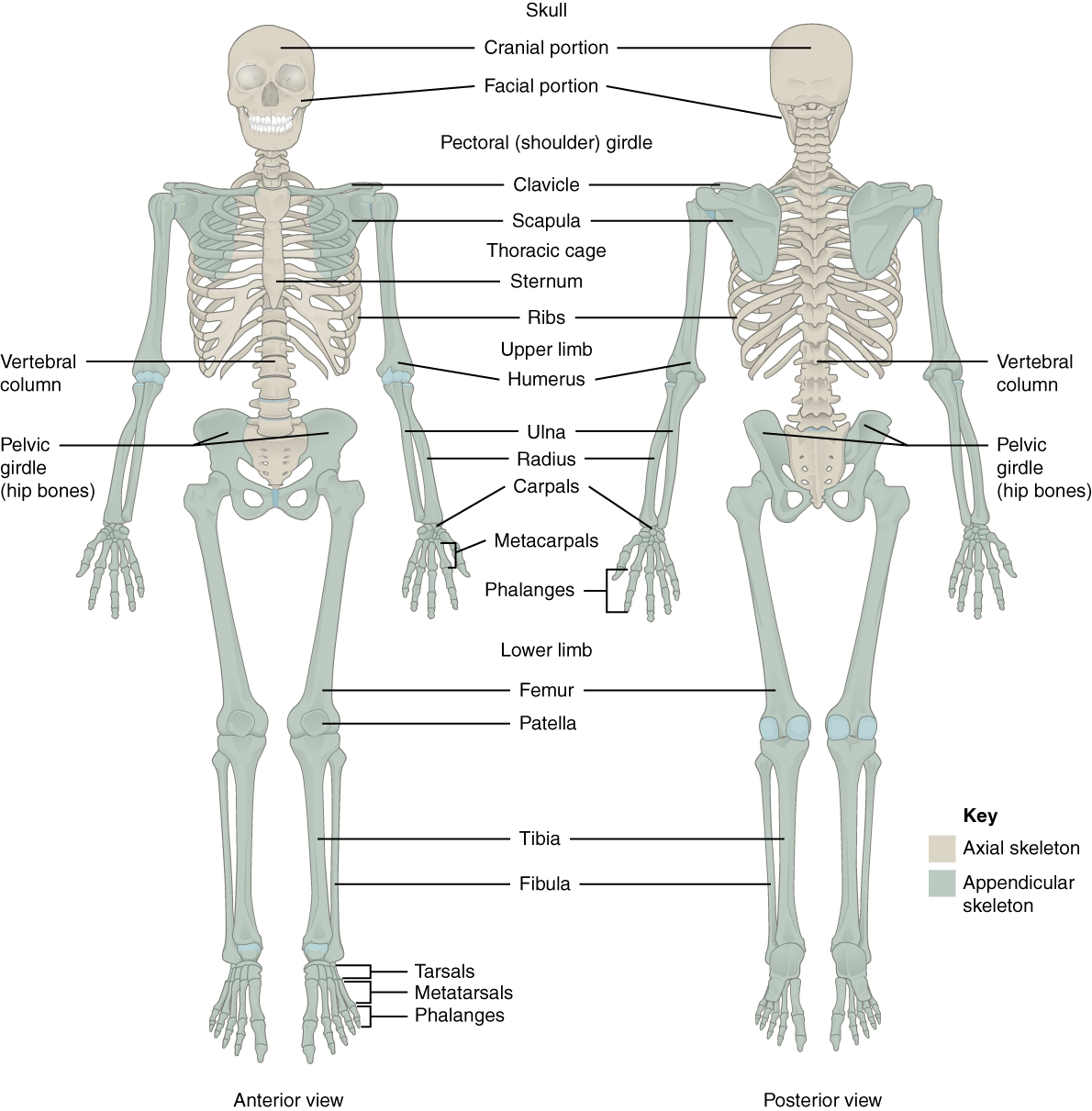
Besides bones, the skeletal system includes cartilage and ligaments.
- Cartilage is a type of dense connective tissue, made of tough protein fibres. It is strong, but flexible and very smooth. It covers the ends of bones at joints, providing a smooth surface for bones to move over.
- Ligaments are bands of dense fibrous connective tissue that hold bones together. They keep the bones of the skeleton in place.
Axial and Appendicular Skeletons
The skeleton is traditionally divided into two major parts: the axial skeleton and the appendicular skeleton, both of which are pictured below (Figure 10.2.3 and Figure 10.2.4 respectively).
- The axial skeleton forms the axis of the body. It includes the skull, vertebral column (spine), and rib cage. The bones of the axial skeleton — along with ligaments and muscles — allow the human body to maintain its upright posture. The axial skeleton also transmits weight from the head, trunk, and upper extremities down the back to the lower extremities. In addition, the bones protect the brain and organs in the chest.
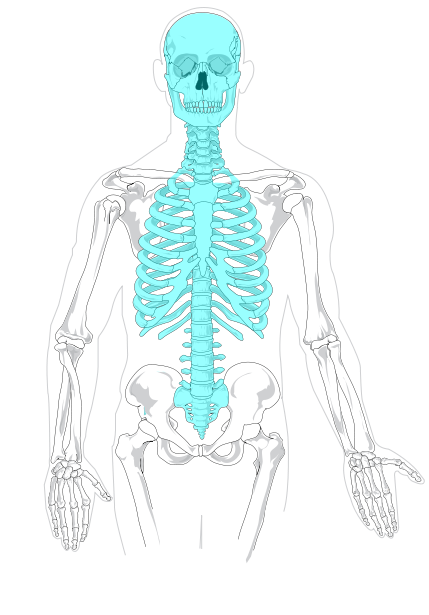
- The appendicular skeleton forms the appendages and their attachments to the axial skeleton. It includes the bones of the arms and legs, hands and feet, and shoulder and pelvic girdles. The bones of the appendicular skeleton make possible locomotion and other movements of the appendages. They also protect the major organs of digestion, excretion, and reproduction.
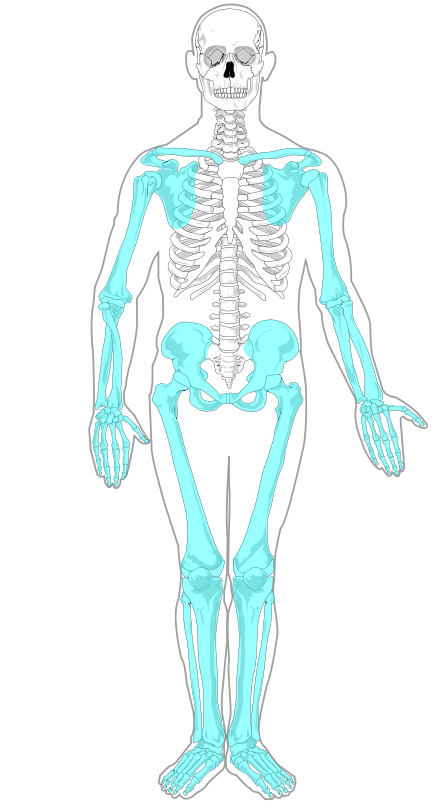
Functions of the Skeletal System
The skeletal system has many different functions that are necessary for human survival. Some of the functions, such as supporting the body, are relatively obvious. Other functions are less obvious but no less important. Three tiny bones (hammer, anvil, and stirrup) inside the middle ear, for example, transfer sound waves into the inner ear.
Support, Shape, and Protection
The skeleton supports the body and gives it shape. Without the rigid bones of the skeletal system, the human body would be just a bag of soft tissues, as described above. The bones of the skeleton are very hard and provide protection to the delicate tissues of internal organs. For example, the skull encloses and protects the soft tissues of the brain, and the vertebral column protects the nervous tissues of the spinal cord. The vertebral column, ribcage, and sternum (breast bone) protect the heart, lungs, and major blood vessels. Providing protection to these latter internal organs requires the bones to be able to expand and contract. The ribs and the cartilage that connects them to the sternum and vertebrae are capable of small shifts that allow breathing and other internal organ movements.
Movement

The bones of the skeleton provide attachment surfaces for skeletal muscles. When the muscles contract, they pull on and move the bones. Figure 11.2.5, for example, shows the muscles attached to the bones at the elbow and shoulder. They help stabilize the joint and allow the arm to bend at these two joints. The bones at joints act like levers moving at a fulcrum point, and the muscles attached to the bones apply the force needed for movement.
Hematopoiesis
Hematopoiesis is the process by which blood cells are produced. This process occurs in a tissue called red marrow, which is found inside some bones, including the pelvis, ribs, and vertebrae. Red marrow synthesizes red blood cells, white blood cells, and platelets. Billions of these blood cells are produced inside the bones every day.
Mineral Storage and Homeostasis
Another function of the skeletal system is storing minerals, especially calcium and phosphorus. This storage function is related to the role of bones in maintaining mineral homeostasis. Just the right levels of calcium and other minerals are needed in the blood for normal functioning of the body. When mineral levels in the blood are too high, bones absorb some of the minerals and store them as mineral salts, which is why bones are so hard. When blood levels of minerals are too low, bones release some of the minerals back into the blood. Bone minerals are alkaline (basic), so their release into the blood buffers the blood against excessive acidity (low pH), whereas their absorption back into bones buffers the blood against excessive alkalinity (high pH). In this way, bones help maintain acid-base homeostasis in the blood.
Another way that bones help maintain homeostasis is by acting as an endocrine organ. One endocrine hormone secreted by bone cells is osteocalcin, which helps regulate blood glucose and fat deposition. It increases insulin secretion, as well as cell’s sensitivity to insulin. In addition, it boosts the number of insulin-producing cells and reduces fat stores.
Sexual Dimorphism of the Human Skeleton
The human skeleton is not as sexually dimorphic as that of many other primate species, although human female skeletons tend to be smaller and less robust than human male skeletons within a given population. There are also subtle differences between males and females in the morphology of the skull, teeth, longs bones, and pelvis. The greatest difference is in the pelvis, because the female pelvis is adapted for child birth. Take a look at the pelvises in Figure 11.2.6 and 11.2.7. How are they different?
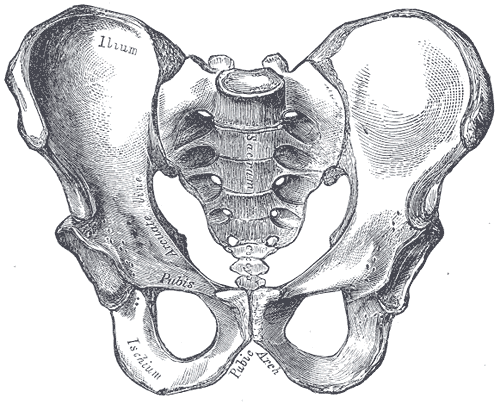 |
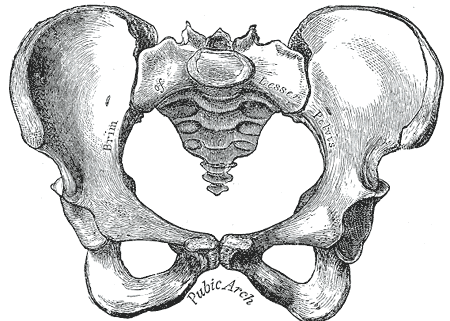 |
11.2 Summary
- The skeletal system is the organ system that provides an internal framework for the human body. In adults, the skeletal system contains 206 bones.
- Bones are organs made of supportive connective tissues, mainly the tough protein collagen. Bones also contain blood vessels, nerves, and other tissues. Bones are hard and rigid, due to deposits of calcium and other mineral salts within their living tissues. Besides bones, the skeletal system includes cartilage and ligaments.
- The skeleton is traditionally divided into two major parts: the axial skeleton (which includes the skull, spine, and rib cage) and the appendicular skeleton (which includes the appendages and the girdles that attach them to the axial skeleton).
- The skeletal system has many different functions, including supporting the body and giving it shape, protecting internal organs, providing attachment surfaces for skeletal muscles, allowing body movements, producing blood cells, storing minerals, helping to maintain mineral homeostasis, and producing endocrine hormones.
- There is relatively little sexual dimorphism in the human skeleton, although the female skeleton tends to be smaller and less robust than the male skeleton. The greatest sex difference is in the pelvis, which is adapted for childbirth in females.
11.2 Review Questions
- What is the skeletal system? How many bones are there in the adult skeleton?
- Describe the composition of bones.
- Besides bones, what other organs are included in the skeletal system?
- Identify the two major divisions of the skeleton.
- List several functions of the skeletal system.
-
- If a person has a problem with blood cell production, what type of bone tissue is most likely involved? Explain your answer.
- What are three forms of homeostasis that the skeletal system regulates? Briefly explain how each one is regulated by the skeletal system.
- What do you think would happen to us if we did not have ligaments? Explain your answer.
- What is a joint? How is cartilage related to joints? Identify one joint in the human body and describe its function.
11.2 Explore More
What can you learn from ancient skeletons? – Farnaz Khatibi, TED-Ed, 2017.
Kathy Reichs on Forensic Anthropology, Cornerstobe Publishing, 2012.
https://www.youtube.com/watch?v=7tKPju8nYi8
Sexual dimorphism in non-human primates – Video Learning – WizScience.com, 2015.
Attributions
Figure 11.2.1
Skull_and_Crossbones.svg by Unknown author on Wikimedia Commons is from The Unicode Standard (this image shows the character U+2620.) All graphic representations of Unicode characters are in the public domain (https://en.wikipedia.org/wiki/Public_domain).
Figure 11.2.2
Skeleton by OpenStax on Wikimedia Commons is used under a CC BY 4.0 (https://creativecommons.org/licenses/by/4.0) license.
Figure 11.2.3
Axial_skeleton_diagram_blank.svg by Quico/ Qllach on Wikimedia Commons is released into the public domain (https://en.wikipedia.org/wiki/Public_domain). (This is a derivative work from Axial skeleton diagram.svg, by Mariana Ruiz Villarreal [LadyofHats].)
Figure 11.2.4
Appendicular_skeleton_diagram_blank.svg by by Quico/ Qllach on Wikimedia Commons is released into the public domain (https://en.wikipedia.org/wiki/Public_domain). (This is a derivative work from Appendicular_skeleton_diagram.svg, by Mariana Ruiz Villarreal [LadyofHats].)
Figure 11.2.5
Animation_triceps_biceps by Niwadare on Wikimedia Commons is used under a CC BY-SA 4.0 (https://creativecommons.org/licenses/by-sa/4.0) license.
Figure 11.2.6
Male pelvisGray241 by Henry Vandyke Carter (1831-1897) on Wikimedia Commons is in the public domain (https://en.wikipedia.org/wiki/Public_domain). (Bartleby.com: Gray’s Anatomy, Plate 241)
Figure 11.2.7
Female pelvisGray242 by Henry Vandyke Carter (1831-1897) on Wikimedia Commons is in the public domain (https://en.wikipedia.org/wiki/Public_domain). (Bartleby.com: Gray’s Anatomy, Plate 242)
Betts, J. G., Young, K.A., Wise, J.A., Johnson, E., Poe, B., Kruse, D.H., Korol, O., Johnson, J.E., Womble, M., DeSaix, P. (2016, May 27). Figure 7.2 Axial and appendicular skeleton [digital image]. In Anatomy and Physiology (Section 7.1). OpenStax. https://openstax.org/books/anatomy-and-physiology/pages/7-1-divisions-of-the-skeletal-system
Cornerstobe Publishing. (2012, November 28). Kathy Reichs on forensic anthropology. YouTube. https://www.youtube.com/watch?v=L101Bvj0lAA
TED-Ed. (2017, June 15). What can you learn from ancient skeletons? – Farnaz Khatibi. YouTube. https://www.youtube.com/watch?v=T24hdchCVIg
VanDyke Carter, H. (1858). Illustration plates 241 and 242. In H. Gray, Anatomy of the Human Body. Lea & Febiger. Bartleby.com, 2000. www.bartleby.com/107/.
Wiz Science. (2015, September 4). Sexual dimorphism in non-human primates – Video Learning – WizScience.com. YouTube. https://www.youtube.com/watch?v=7tKPju8nYi8
Created by: CK-12/Adapted by Christine Miller
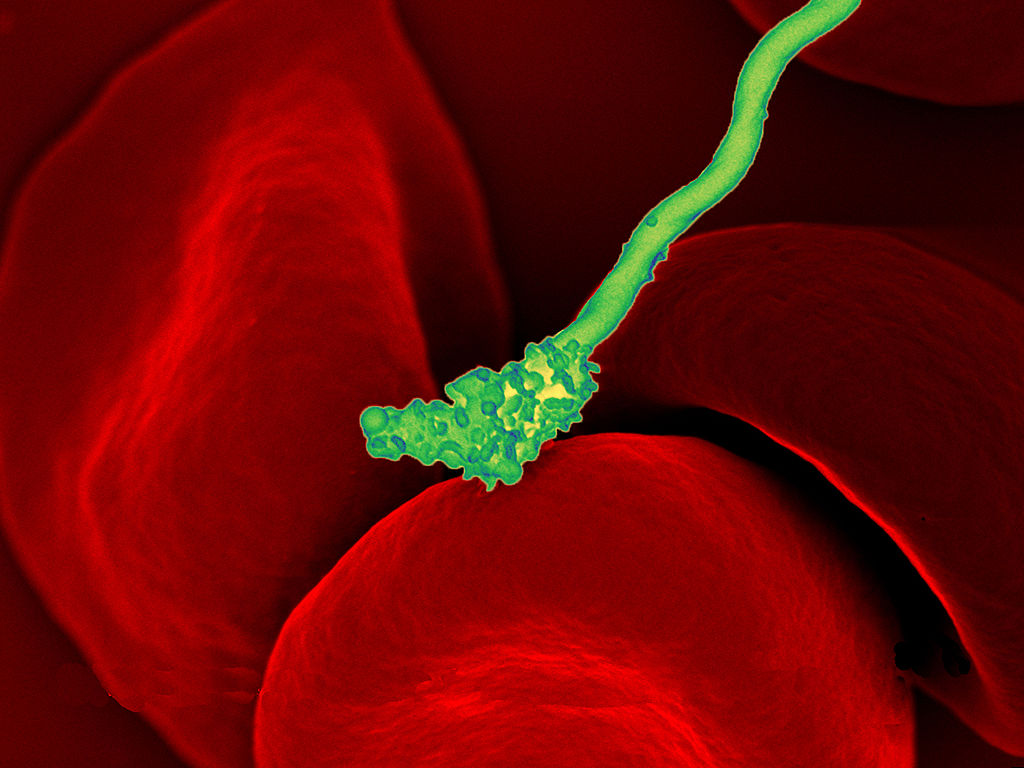
Bacteria Attack!
The colourful image in Figure 4.3.1 shows a bacterial cell (in green) attacking human red blood cells. The bacterium causes a disease called relapsing fever. The bacterial and human cells look very different in size and shape. Although all living cells have certain things in common — such as a plasma membrane and cytoplasm — different types of cells, even within the same organism, may have their own unique structures and functions. Cells with different functions generally have different shapes that suit them for their particular job. Cells vary not only in shape, but also in size, as this example shows. In most organisms, however, even the largest cells are no bigger than the period at the end of this sentence. Why are cells so small?
Explaining Cell Size
Most organisms, even very large ones, have microscopic cells. Why don't cells get bigger instead of remaining tiny and multiplying? Why aren't you one giant cell rolling around school? What limits cell size?
Once you know how a cell functions, the answers to these questions are clear. To carry out life processes, a cell must be able to quickly pass substances in and out of the cell. For example, it must be able to pass nutrients and oxygen into the cell and waste products out of the cell. Anything that enters or leaves a cell must cross its outer surface. The size of a cell is limited by its need to pass substances across that outer surface.
Look at the three cubes in Figure 4.3.2. A larger cube has less surface area relative to its volume than a smaller cube. This relationship also applies to cells — a larger cell has less surface area relative to its volume than a smaller cell. A cell with a larger volume also needs more nutrients and oxygen, and produces more waste. Because all of these substances must pass through the surface of the cell, a cell with a large volume will not have enough surface area to allow it to meet its needs. The larger the cell is, the smaller its ratio of surface area to volume, and the more difficult it will be for the cell to get rid of its waste and take in necessary substances. This is what limits the size of the cell.

Cell Form and Function
Cells with different functions often have varying shapes. The cells pictured below (Figure 4.3.3) are just a few examples of the many different shapes that human cells may have. Each type of cell has characteristics that help it do its job. The job of the nerve cell, for example, is to carry messages to other cells. The nerve cell has many long extensions that reach out in all directions, allowing it to pass messages to many other cells at once. Do you see the tail of each tiny sperm cell? Its tail helps a sperm cell "swim" through fluids in the female reproductive tract in order to reach an egg cell. The white blood cell has the job of destroying bacteria and other pathogens. It is a large cell that can engulf foreign invaders.
Figure 4.3.3 Human cells may have many different shapes that help them to do their jobs.
Cells With and Without a Nucleus
The nucleus is a basic cell structure present in many — but not all — living cells. The nucleus of a cell is a structure in the cytoplasm that is surrounded by a membrane (the nuclear membrane) and contains DNA. Based on whether or not they have a nucleus, there are two basic types of cells: prokaryotic cells and eukaryotic cells.
Prokaryotic Cells
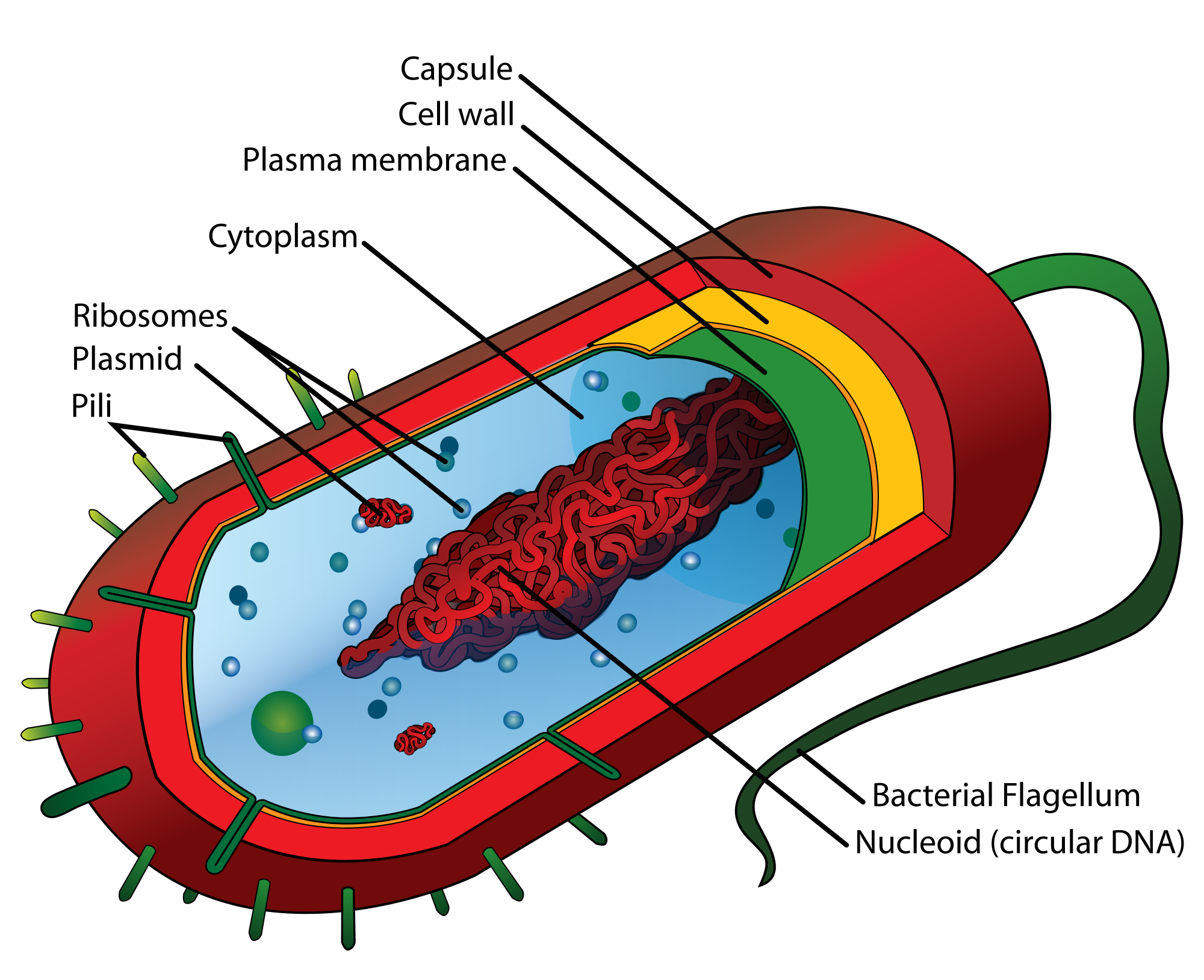
Prokaryotic cells are cells without a nucleus. The DNA in prokaryotic cells is in the cytoplasm, rather than enclosed within a nuclear membrane. In addition, these cells are typically smaller than eukaryotic cells and contain fewer organelles. Prokaryotic cells are found in single-celled organisms, such as the bacterium represented by the model in Figure 4.3.3. Organisms with prokaryotic cells are called prokaryotes. They were the first type of organisms to evolve, and they are still the most common organisms today.
Eukaryotic Cells
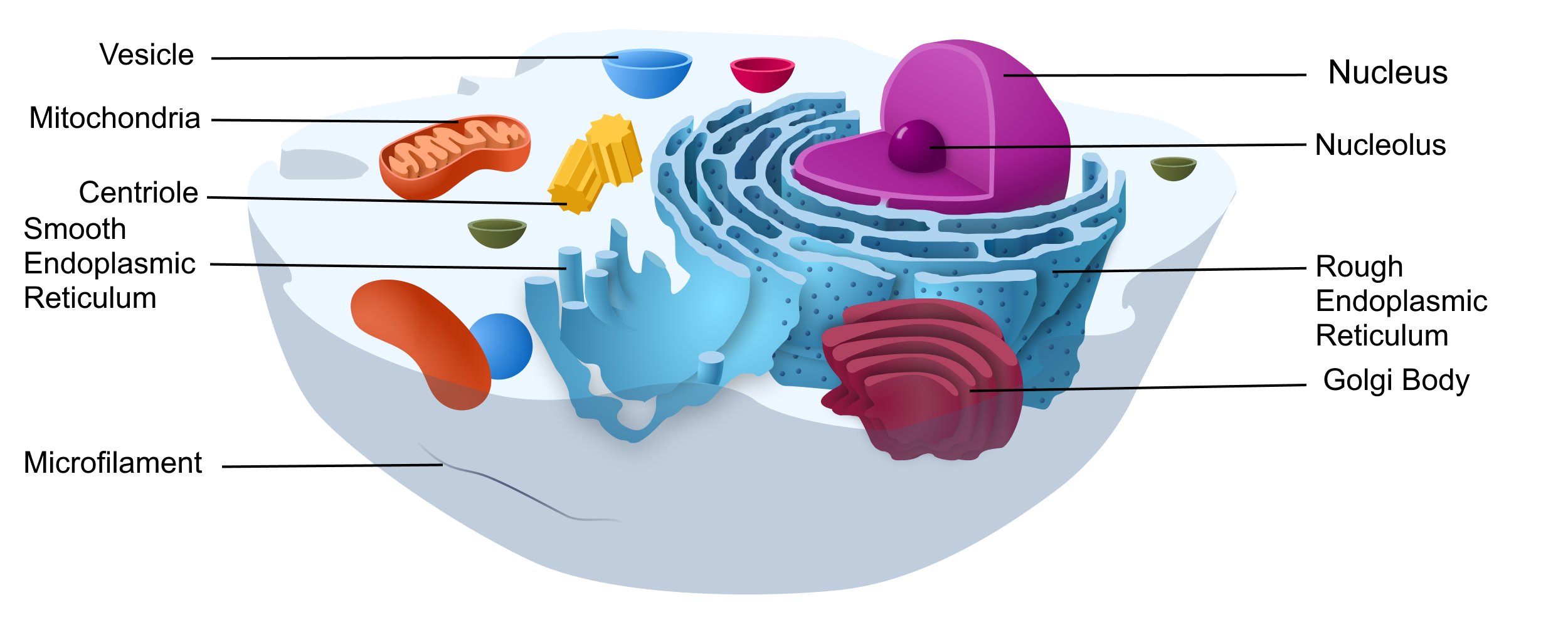
Eukaryotic cells are cells that contain a nucleus. A typical eukaryotic cell is represented by the model in Figure 4.3.4. Eukaryotic cells are usually larger than prokaryotic cells. They are found in some single-celled and all multicellular organisms. Organisms with eukaryotic cells are called eukaryotes, and they range from fungi to humans.
Besides a nucleus, eukaryotic cells also contain other organelles. An organelle is a structure within the cytoplasm that performs a specific job in the cell. Organelles called mitochondria, for example, provide energy to the cell, and organelles called vesicles store substances in the cell. Organelles allow eukaryotic cells to carry out more functions than prokaryotic cells can.
Interestingly, scientists think that mitochondria were once free-living prokaryotes that infected (or were engulfed by) larger cells. The two organisms developed a symbiotic relationship that was beneficial to both of them, resulting in the smaller prokaryote becoming an organelle within the larger cell. This is called endosymbiotic theory, and it is supported by a lot of evidence, including the fact that mitochondria have their own DNA separate from the DNA in the nucleus of the eukaryotic cell. Endosymbiotic theory will be described in more detail in later sections, and it's also discussed in the video below.
https://www.youtube.com/watch?v=FGnS-Xk0ZqU
Endosymbiotic Theory, Amoeba Sisters, 2017.
4.3 Summary
- Cells must be very small so they have a large enough surface area-to-volume ratio to maintain normal cell processes.
- Cells with different functions often have different shapes.
- Prokaryotic cells do not have a nucleus. Eukaryotic cells do have a nucleus, along with other organelles.
4.3 Review Questions
- Explain why most cells are very small.
- Discuss variations in the form and function of cells.
-
-
- Do human cells have organelles? Explain your answer.
- Which are usually larger – prokaryotic or eukaryotic cells? What do you think this means for their relative ability to take in needed substances and release wastes? Discuss your answer.
- DNA in eukaryotes is enclosed within the _______ ________.
- Name three different types of cells in humans.
- Which organelle provides energy in eukaryotic cells?
- What is a function of a vesicle in a cell?
4.3 Explore More
https://www.youtube.com/watch?time_continue=1&v=9i7kAt97XYU&feature=emb_logo
How we think complex cells evolved - Adam Jacobson, TED-Ed, 2015.
https://www.youtube.com/watch?v=Pxujitlv8wc
Prokaryotic vs. Eukaryotic Cells (updated), Amoeba Sisters, 2018.
Attributions
Figure 4.3.1
Borrelia_hermsii_Bacteria_(13758011613) by NAID on Wikimedia Commons is released into the public domain (https://en.wikipedia.org/wiki/Public_domain).
Figure 4.3.2
Cell Size by Christine Miller is released into the Public Domain (https://creativecommons.org/publicdomain/mark/1.0/).
Figure 4.3.3
- Chondrocyte. BioTek-Wikipedia-Image by BioTek Instruments, Inc. on Wikimedia Commons is used under a CC BY-SA 3.0 (https://creativecommons.org/licenses/by-sa/3.0/deed.en) license.
- Neutrophil with anthrax copy by Volker Brinkmann from PLOS Pathogens on Wikimedia Commons is used under a CC BY 2.5 (https://creativecommons.org/licenses/by/2.5/deed.en) license.
- PLoSBiol4.e126.Fig6fNeuron by Lee, et al. from PLOS Biology on Wikimedia Commons is used under a CC BY 2.5 (https://creativecommons.org/licenses/by/2.5/deed.en) license.
- Sperm (265 33) human by Doc. RNDr. Josef Reischig, CSc. on Wikimedia Commons is used under a CC BY-SA 3.0 (https://creativecommons.org/licenses/by-sa/3.0) license.
Figure 4.3.4
Model of a prokaryotic cell: bacterium by Mariana Ruiz Villarreal [LadyofHats] on Wikimedia Commons is released into the public domain (https://en.wikipedia.org/wiki/Public_domain).
Figure 4.3.5
Animal Cell adapted by Christine Miller is used under a CC0 1.0 (https://creativecommons.org/publicdomain/zero/1.0/deed.en) public domain dedication license. (Original image, Animal Cell Unannotated, is by Kelvin Song on Wikimedia Commons.)
References
Amoeba Sisters. (2017, May 3). Endosymbiotic theory. YouTube. https://www.youtube.com/watch?v=FGnS-Xk0ZqU&feature=youtu.be
Amoeba Sisters. (2018, July 30). Prokaryotic vs. eukaryotic cells (updated). YouTube. https://www.youtube.com/watch?v=Pxujitlv8wc&feature=youtu.be
Brinkmann, V. (November 2005). Neutrophil engulfing Bacillus anthracis. PLoS Pathogens 1 (3): Cover page [digital image]. DOI:10.1371. https://journals.plos.org/plospathogens/issue?id=10.1371/issue.ppat.v01.i03
Lee, W.C.A., Huang, H., Feng, G., Sanes, J.R., Brown, E.N., et al. (2005, December 27) Figure 6f, slightly altered (plus scalebar, minus letter "f".) [digital image]. Dynamic Remodeling of Dendritic Arbors in GABAergic Interneurons of Adult Visual Cortex. PLoS Biology, 4(2), e29. doi:10.1371/journal.pbio.0040029. https://journals.plos.org/plosbiology/article?id=10.1371/journal.pbio.0040029
TED-Ed. (2015, February 17). How we think complex cells evolved - Adam Jacobson. https://www.youtube.com/watch?v=9i7kAt97XYU&feature=youtu.be
A nervous system cell that provides support for neurons and helps them transmit nerve impulses.
A peptide hormone, produced by alpha cells of the pancreas. It works to raise the concentration of glucose and fatty acids in the bloodstream, and is considered to be the main catabolic hormone of the body. It is also used as a medication to treat a number of health conditions.
A peptide hormone, produced by alpha cells of the pancreas. It works to raise the concentration of glucose and fatty acids in the bloodstream, and is considered to be the main catabolic hormone of the body. It is also used as a medication to treat a number of health conditions.
Created by: CK-12/Adapted by: Christine Miller
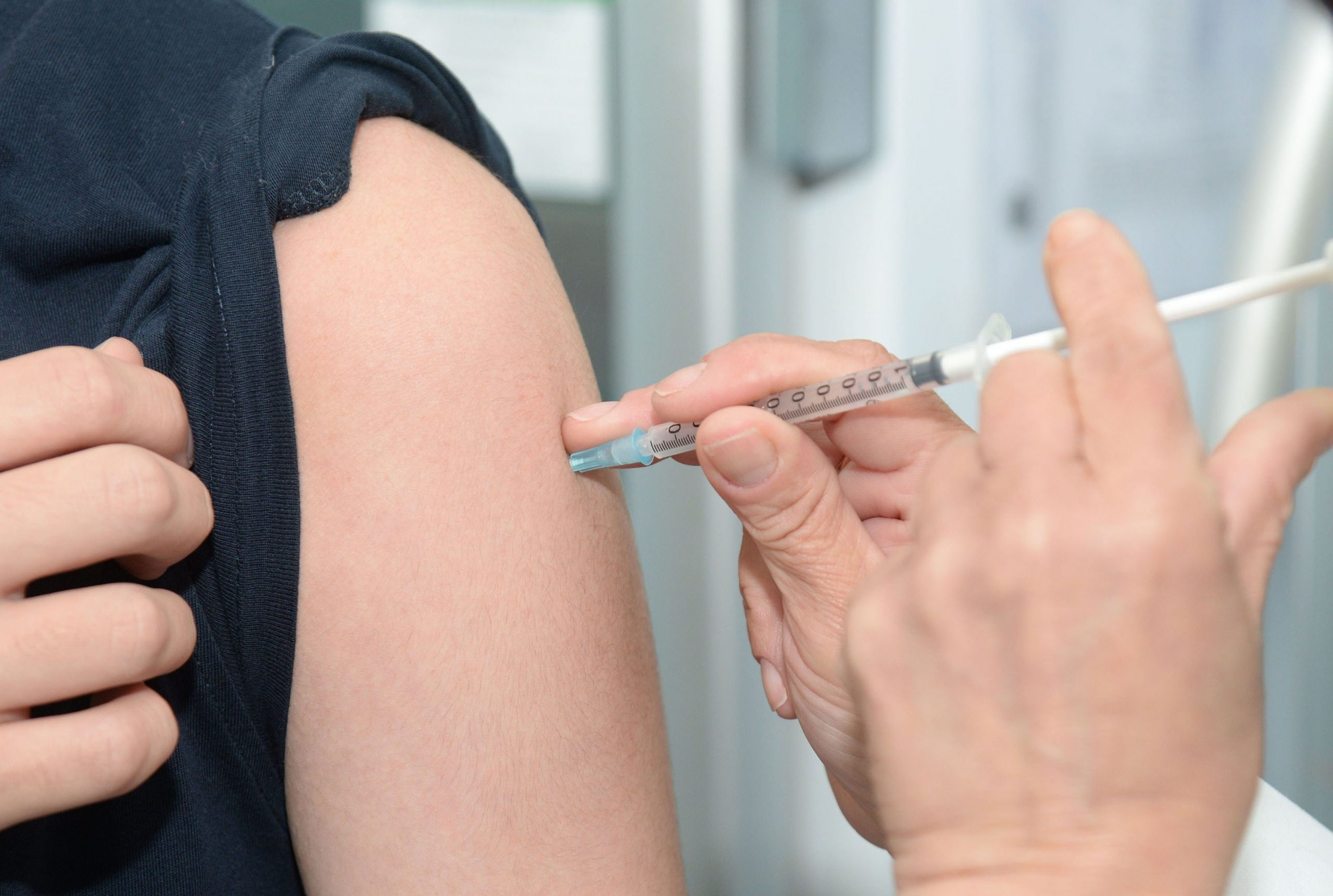
Ouch!
The person in Figure 1.2.1 is getting a flu vaccine. You probably know that getting a vaccine can hurt — but it's usually worth it. A vaccine contains dead or altered forms of germs that normally cause a disease, such as flu or measles. The germs in vaccines have been inactivated or weakened so they can no longer cause illness, but are still "noticed" by the immune system.
They stimulate the immune system to produce chemicals that can kill the actual germs if they enter the body, thus preventing future disease. How was such an ingenious way to prevent disease discovered? The short answer is more than two centuries of science.
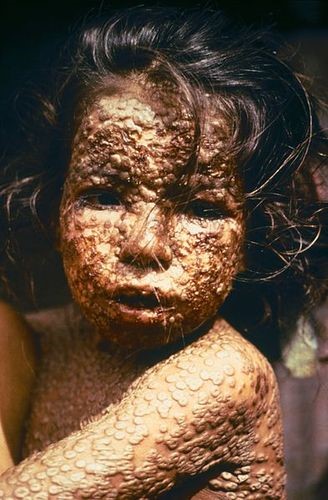
Science as Process
You may think of science as a large and detailed body of knowledge, but science is also the process by which this knowledge is obtained. Science uses experimentation, evidence, and logic to continuously test ideas. Over time and through repeated experimentation and testing, scientific knowledge advances.
We've been accumulating knowledge of vaccines for more than two centuries. The discovery of the first vaccine, as well as the process of vaccination, dates back to 1796. An English doctor named Edward Jenner observed that people who became infected with cowpox did not get sick from smallpox, a similar but much more severe disease (Figure 1.2.2). Jenner decided to transmit cowpox to a young boy to see if it would protect him from smallpox. He gave the boy cowpox by scratching liquid from cowpox sores into the boy's skin. Then, six weeks later, he scratched liquid from smallpox sores into the boy's skin. As Jenner predicted, the boy did not get sick from smallpox. Jenner had discovered the first vaccine, although additional testing was needed to show that it really was effective.
Almost a century passed before the next vaccine was discovered, a vaccine for cholera in 1879. Around the same time, French chemist Louis Pasteur found evidence that many human diseases are caused by germs, which earned him the title of "father of germ theory." Since Pasteur's time, vaccines have been discovered for scores of additional diseases caused by germs, and scientists are currently researching vaccines for many others.
Benefits of Science
Medical advances such as the discovery of vaccines are one of the most important benefits of science, but science and scientific knowledge are also crucial for most other human endeavors. Science is needed to design safe cars, predict storms, control global warming, develop new technologies of many kinds, help couples have children, and put humans on the moon. Clearly, the diversity of applications of scientific knowledge is vast!
1.2 Summary
- Science is a large and detailed body of knowledge. It is also the process by which this knowledge is obtained.
- Science uses experimentation, evidence, and logic to continuously test ideas. Over time and through repeated experimentation and testing, scientific knowledge advances.
- Medical advances such as the development of vaccines are one of the most important benefits of science, but science and scientific knowledge are also crucial for most other human endeavors.
1.2 Review Questions
- Explain why science is considered both a process and a body of knowledge.
- State three specific examples of human endeavors that are based on scientific knowledge.
- How does science influence your daily life?
- Jenner used a young boy as a research subject in his smallpox vaccine research. Today, scientists must follow strict guidelines when using human subjects in their research. What unique concerns do you think might arise when human beings are used as research subjects?
- What gave Jenner the idea to develop a vaccine for smallpox?
- Why do you think almost a century passed between the development of the first vaccine (for smallpox) and the development of the next vaccine (for cholera)
1.2 Explore More
https://www.youtube.com/watch?time_continue=1&v=yqUFy-t4MlQ&feature=emb_logohttps://www.ted.com/talks/uri_alon_why_science_demands_a_leap_into_the_unknown?language=en
How we conquered the deadly smallpox virus - Simona Zompi, TED-Ed, 2013.
Attributions
Figure 1.2.1
Vacina, centro de vacinação, by Hyttalo Souza on Unsplash, used under the Unsplash License (https://unsplash.com/license).
Figure 1.2.2
Child with Smallpox/ID#3265, by CDC/ James Hicks, from the Centre for Disease Control and Prevention, is in the public domain (https://en.wikipedia.org/wiki/Public_domain).
References
TED-Ed. (2013, October 28). How we conquered the deadly smallpox virus - Simona Zompi. YouTube. https://www.youtube.com/watch?v=yqUFy-t4MlQ&feature=youtu.be
Wikipedia contributors. (2020, August 9). Edward Jenner. In Wikipedia. https://en.wikipedia.org/w/index.php?title=Edward_Jenner&oldid=971970576
Wikipedia contributors. (2020, August 5). Louis Pasteur. In Wikipedia. https://en.wikipedia.org/w/index.php?title=Louis_Pasteur&oldid=971330056
Created by: CK-12/Adapted by: Christine Miller
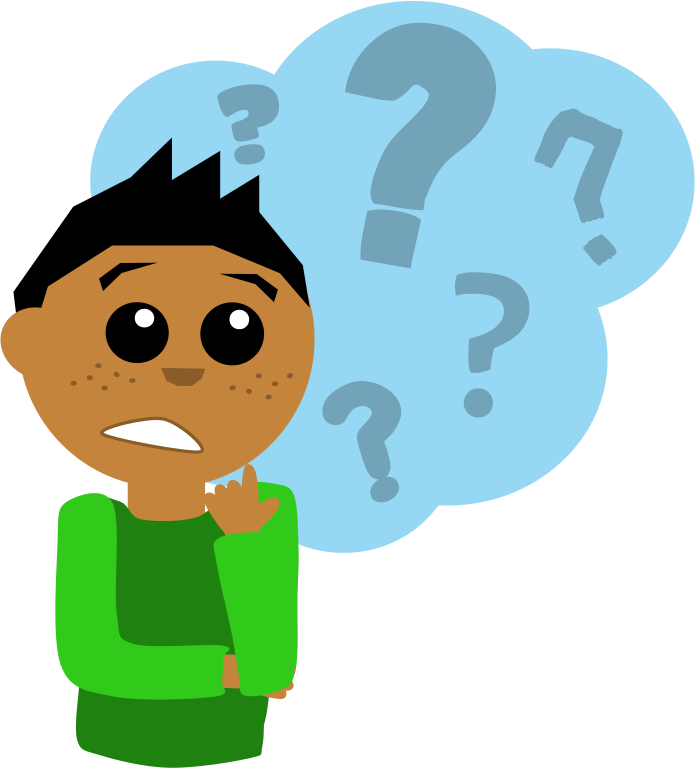
Defining Science
Science is a distinctive way of gaining knowledge about the natural world that starts with a question and then tries to answer the question using evidence and logic. It is an exciting exploration of all the whys and hows that any curious person might ask about the world. You can be part of that exploration! Besides your curiosity, all you need is a basic understanding of how scientists think and how science is done. In this concept, you'll learn how to think like a scientist.
Thinking Like a Scientist
Thinking like a scientist rests on certain underlying assumptions. Scientists assume that:
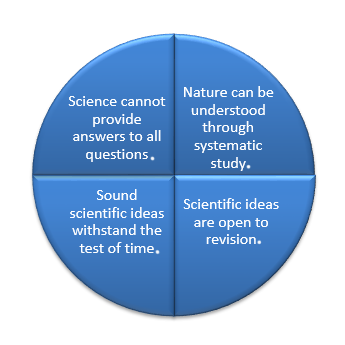
Nature Is Understandable
Scientists think of nature as a single system controlled by natural laws. By discovering natural laws, scientists strive to increase their understanding of the natural world. Laws of nature are expressed as scientific laws. A scientific law is a statement that describes what always happens under certain conditions in nature.
Scientific Ideas Are Open to Change
Science is both a process and body of knowledge. Scientific knowledge is generated through systematic processes, such as observation and experimentation. Scientists are always testing and revising their ideas, and as new observations are made, existing ideas may be challenged. Ideas may be replaced with new ideas that better fit the facts, but more often, existing ideas are simply revised. Through many new discoveries over time, scientists gradually build an increasingly accurate and detailed understanding of the natural world.
Scientific Knowledge May Be Long Lasting
Many scientific ideas have stood the test of time. About 200 years ago, the scientist John Dalton proposed atomic theory — the theory that all matter is made of tiny particles called atoms. This theory is still valid today. During the two centuries since the theory was first proposed, scientists have learned a lot more about atoms and the even smaller particles that compose them. Nonetheless, the idea that all matter consists of atoms remains valid. There are many other examples of basic scientific ideas that have been tested repeatedly and proven sound. You will learn about many of them as you study human biology.
Not All Questions Can be Answered by Science
Science rests on evidence and logic, and evidence comes from observations. Therefore, science deals only with things that can be observed. An observation is anything that is detected through human senses or with instruments or measuring devices that extend human senses. Things that cannot be observed or measured by current means — such as supernatural beings or events — are outside the bounds of science. Consider these two questions about life on Earth:
- Did life on Earth evolve over time?
- How did life on Earth originate?
The first question can be answered by science on the basis of scientific evidence (such as fossils and logical arguments). The second question could be a matter of belief, but no evidence can be gathered to support or refute it. Therefore, it is outside the realm of science.
1.3 Summary
- Science is a distinctive way of gaining knowledge about the natural world that tries to answer questions using evidence and logic.
- Scientists assume that nature can be understood through systematic study.
- Scientific ideas are open to revision.
- Sound scientific ideas withstand the test of time.
- Science cannot provide answers to all of our questions.
1.3 Review Questions
- Define science.
- What is the general goal of science?
-
- Identify four basic assumptions that scientists make when they study the natural world.
- Do observations in science have to be made by the naked eye? Can you think of a way in which scientists might be able to make observations about something they cannot directly see?
- If something cannot be observed, can it be tested scientifically? Explain your reasoning.
- Scientific knowledge builds upon itself. Give an example of a scientific idea from the reading where the initial idea developed further as science advanced.
- Discuss this statement: “Scientific ideas are always changing, so they can't be trusted.” Do you think this is true?
- Why do you think that scientific knowledge expands as technology becomes more advanced?
1.3 Explore More
https://youtu.be/3nAETHZTObk
Nature of Science with the Ameoba Sisters, 2019.
References
Amoeba Sisters. (2019, Jun 6). Nature of science with Ameoba Sisters. YouTube. https://www.youtube.com/watch?v=3nAETHZTObk
Wikipedia contributors. (2020, July 25). John Dalton. In Wikipedia. https://en.wikipedia.org/w/index.php?title=John_Dalton&oldid=969425891
A special sensory organ that collects and amplifies sound waves and information on body position and transforms them into nerve impulses that travel to the brain.
Created by: CK-12/Adapted by: Christine Miller
What Is Pseudoscience?
Pseudoscience is a claim, belief, or practice that is presented as scientific but does not adhere to the standards and methods of science. True science is based on repeated evidence-gathering and testing of falsifiable hypotheses. Pseudoscience does not adhere to these criteria. In addition to phrenology, some other examples of pseudoscience include astrology, extrasensory perception (ESP), reflexology, reincarnation, and Scientology,
Characteristics of Pseudoscience
Whether a field is actually science or just pseudoscience is not always clear. However, pseudoscience generally exhibits certain common characteristics. Indicators of pseudoscience include:
- The use of vague, exaggerated, or untestable claims: Many claims made by pseudoscience cannot be tested with evidence. As a result, they cannot be falsified, even if they are not true.
- An over-reliance on confirmation rather than refutation: Any incident that appears to justify a pseudoscience claim is treated as proof of the claim. Claims are assumed true until proven otherwise, and the burden of disproof is placed on skeptics of the claim.
- A lack of openness to testing by other experts: Practitioners of pseudoscience avoid subjecting their ideas to peer review. They may refuse to share their data and justify the need for secrecy with claims of proprietary or privacy.
- An absence of progress in advancing knowledge: In pseudoscience, ideas are not subjected to repeated testing followed by rejection or refinement, as hypotheses are in true science. Ideas in pseudoscience may remain unchanged for hundreds — or even thousands — of years. In fact, the older an idea is, the more it tends to be trusted in pseudoscience.
- Personalization of issues: Proponents of pseudoscience adopt beliefs that have little or no rational basis, so they may try to confirm their beliefs by treating critics as enemies. Instead of arguing to support their own beliefs, they attack the motives and character of their critics.
- The use of misleading language: Followers of pseudoscience may use scientific-sounding terms to make their ideas sound more convincing. For example, they may use the formal name dihydrogen monoxide to refer to plain old water.
Persistence of Pseudoscience
Despite failing to meet scientific standards, many pseudosciences survive. Some pseudosciences remain very popular with large numbers of believers. A good example is astrology.
Astrology is the study of the movements and relative positions of celestial objects as a means for divining information about human affairs and terrestrial events. Many ancient cultures attached importance to astronomical events, and some developed elaborate systems for predicting terrestrial events from celestial observations. Throughout most of its history in the West, astrology was considered a scholarly tradition and was common in academic circles. With the advent of modern Western science, astrology was called into question. It was challenged on both theoretical and experimental grounds, and it was eventually shown to have no scientific validity or explanatory power.
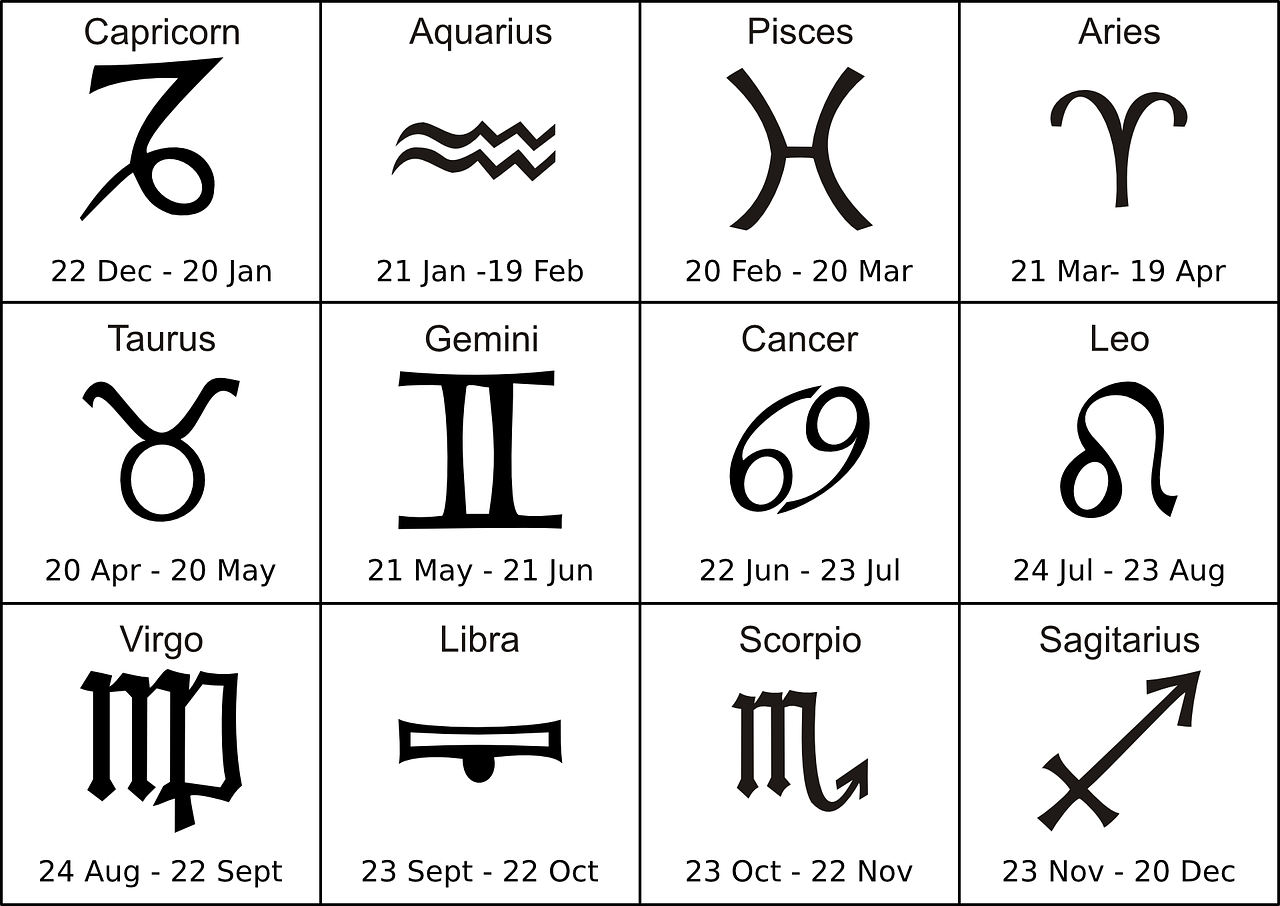
Today, astrology is considered a pseudoscience, yet it continues to have many devotees. Most people know their astrological sign, and many people are familiar with the personality traits supposedly associated with their sign. Astrological readings and horoscopes are readily available online and in print media, and a lot of people read them, even if only occasionally. About a third of all adult Americans actually believe that astrology is scientific. Studies suggest that the persistent popularity of pseudosciences such as astrology reflects a high level of scientific illiteracy. It seems that many Americans do not have an accurate understanding of scientific principles and methodology. They are not convinced by scientific arguments against their beliefs.
Dangers of Pseudoscience
Belief in astrology is unlikely to cause a person harm, but belief in some other pseudosciences might — especially in health care-related areas. Treatments that seem scientific but are not may be ineffective, expensive, and even dangerous to patients. Seeking out pseudoscientific treatments may also delay or preclude patients from seeking scientifically-based medical treatments that have been tested and found safe and effective. In short, irrational health care may not be harmless.
Scientific Hoaxes, Frauds, and Fallacies
Pseudoscience is not the only way that science may be misused. Scientific hoaxes, frauds, and fallacies may misdirect the pursuit of science, put patients at risk, or mislead and confuse the public. An example of each of these misuses of science and its negative effects is described below.
The Piltdown Hoax
![Image by By James Howard McGregor [Public domain], via Wikimedia Commons A side profile view of an artists rendition of what the Piltdown Man may have looked like, had he been real.](https://pressbooks.ccconline.org/acchumanbio/wp-content/uploads/sites/152/2023/10/Piltdown-Man-1.jpg)
Piltdown Man (see picture left) was a paleontological hoax in which bone fragments were presented as the fossilized remains of a previously unknown early human. These fragments consisted of parts of a skull and jawbone, reported to have been found in 1908 in a gravel pit at Piltdown, East Sussex, England. The significance of the specimen remained the subject of controversy until it was exposed in 1953 as a hoax. It eventually came to light that the specimen consisted of the lower jawbone of an orangutan deliberately combined with skull bones of a modern human. The Piltdown hoax is perhaps the most infamous paleontological hoax ever perpetrated, both for its impact on the direction of research on human evolution and for the length of time between its "discovery" and its full exposure as a forgery.
![Photo by Anrie [CC BY-SA 3.0 (https://creativecommons.org/licenses/by-sa/3.0)], from Wikimedia Commons A replica of the infamous Piltdown skull. The skull is encased in a glass sphere. The replica shows portions of the skull which were bone in white, and the portions of the skull which were inferred in black.](https://pressbooks.ccconline.org/acchumanbio/wp-content/uploads/sites/152/2023/10/Sterkfontein_Piltdown_man-1.jpg)
In 1912, the head of the geological department at the British Museum proposed that Piltdown man represented an evolutionary missing link between apes and humans. With its human-like cranium and ape-like jaw, it seemed to support the idea then prevailing in England that human evolution began with the brain. The Piltdown specimen led scientists down a blind alley in the belief that the human brain increased in size before the jaw underwent size reductions to become more like the modern human jaw. This belief confused and misdirected the study of human evolution for decades, and actual fossils of early humans were ignored because they didn't support the accepted paradigm.
The Vaccine-Autism Fraud
You may have heard that certain vaccines put the health of young children at risk. This persistent idea is not supported by scientific evidence or accepted by the vast majority of experts in the field. It stems largely from an elaborate medical research fraud that was reported in a 1998 article published in the respected British medical journal, The Lancet. The main author of the article was a British physician named Andrew Wakefield. In the article, Wakefield and his colleagues described case histories of 12 children, most of whom were reported to have developed autism soon after the administration of the MMR (measles, mumps, rubella) vaccine.
Several subsequent peer-reviewed studies failed to show any association between the MMR vaccine and autism. It also later emerged that Wakefield had received research funding from a group of people who were suing vaccine manufacturers. In 2004, ten of Wakefield's 12 coauthors formally retracted the conclusions in their paper. In 2010, editors of The Lancetretracted the entire paper. That same year, Wakefield was charged with deliberate falsification of research and barred from practicing medicine in the United Kingdom. Unfortunately, by then, the damage had already been done. Parents afraid that their children would develop autism had refrained from having them vaccinated. British MMR vaccination rates fell from nearly 100 per cent to 80 per cent in the years following the study. The consensus of medical experts today is that Wakefield's fraud put hundreds of thousands of children at risk because of the lower vaccination rates and also diverted research efforts and funding away from finding the true cause of autism.
Correlation-Causation Fallacy
Many statistical tests used in scientific research calculate correlations between variables. Correlation refers to how closely related two data sets are, which may be a useful starting point for further investigation. Correlation, however, is also one of the most misused types of evidence, primarily because of the logical fallacy that correlation implies causation. In reality, just because two variables are correlated does not necessarily mean that either variable causes the other.
A few simple examples, illustrated by the graphs below, can be used to demonstrate the correlation-causation fallacy. Assume a study found that both per capita consumption of mozzarella cheese and the number of Civil Engineering doctorates awarded are correlated; that is, rates of both events increase together. If correlation really did imply causation, then you could conclude from the second example that the increase in age of Miss America causes an increase in murders of a specific type or vice versa.
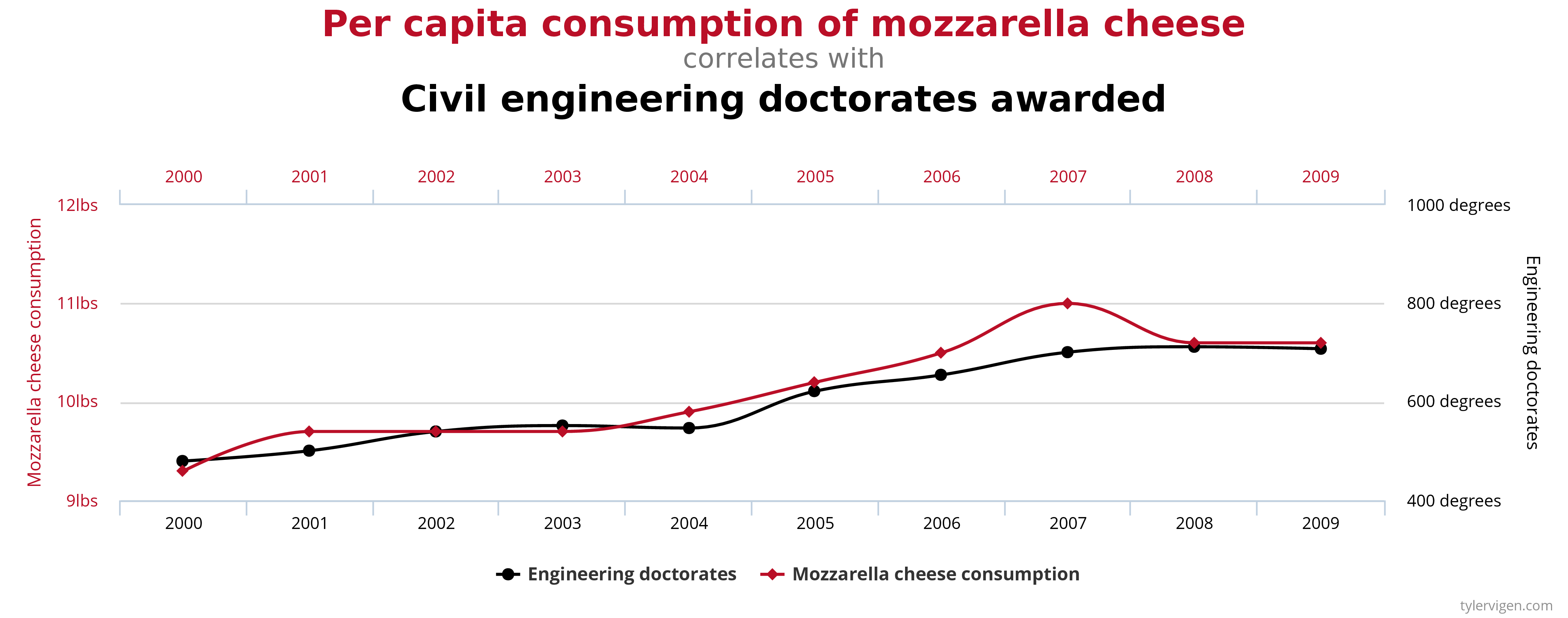
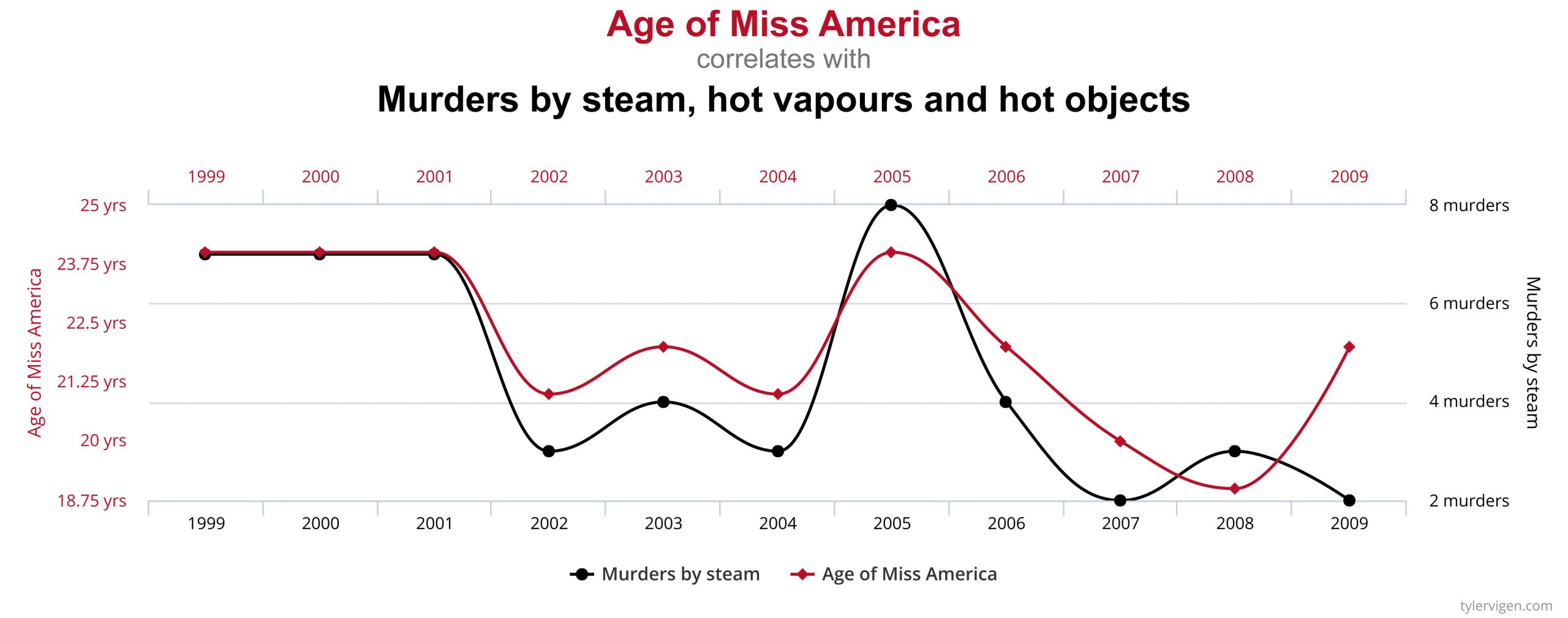
An actual example of the correlation-causation fallacy occurred during the latter half of the 20th century. Numerous studies showed that women taking hormone replacement therapy (HRT) to treat menopausal symptoms also had a lower-than-average incidence of coronary heart disease (CHD). This correlation was misinterpreted as evidence that HRT protects women against CHD. Subsequent studies that controlled other factors related to CHD disproved this presumed causal connection. The studies found that women taking HRT were more likely to come from higher socio-economic groups, with better-than-average diets and exercise regimens. Rather than HRT causing lower CHD incidence, these studies concluded that HRT and lower CHD were both effects of higher socio-economic status and related lifestyle factors.
Check out this “Rough Guide to Spotting Bad Science” infographic from Compound Interest:
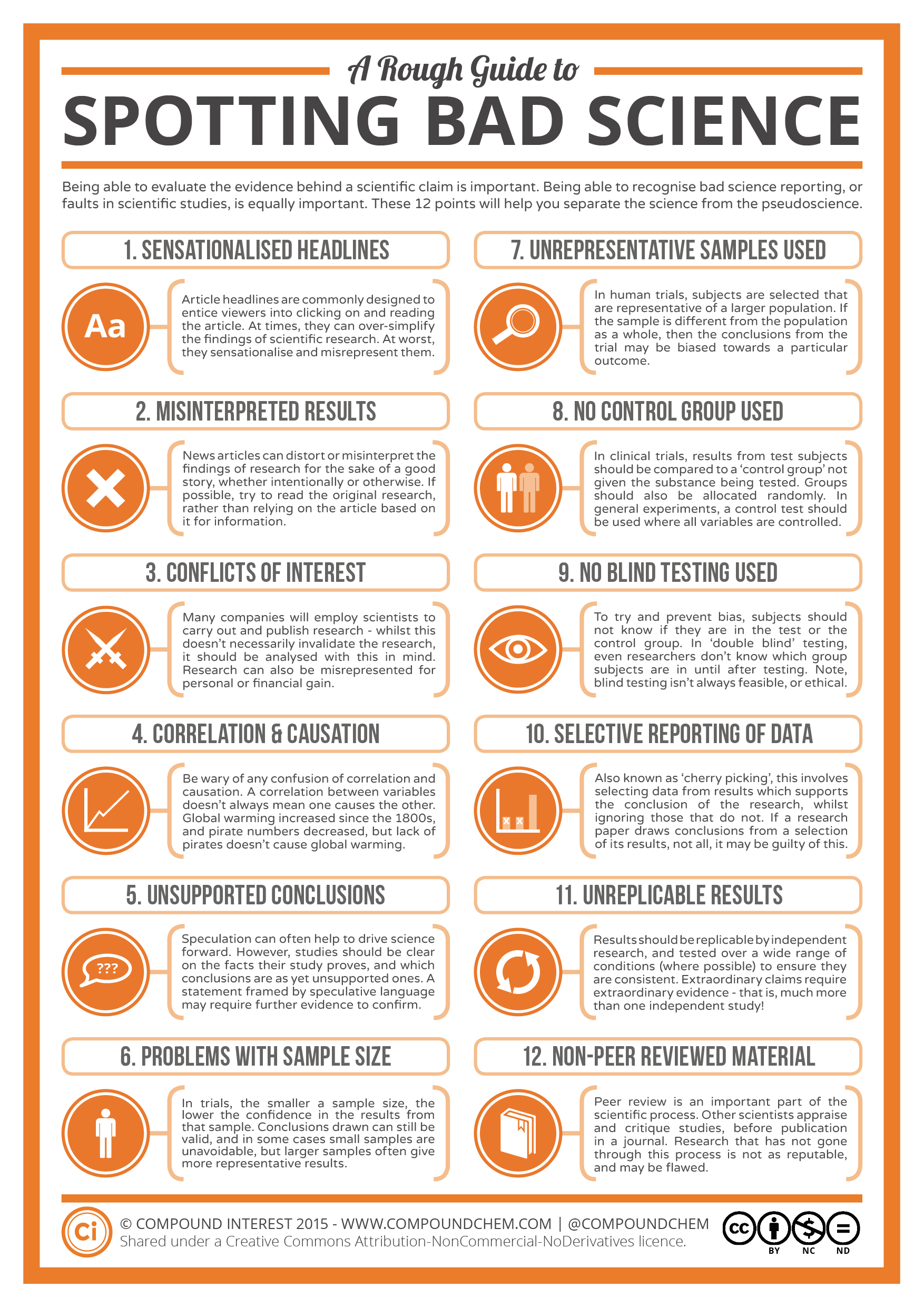
1.7 Summary
- Pseudoscience is a claim, belief, or practice that is presented as scientific, but does not adhere to scientific standards and methods.
- Indicators of pseudoscience include untestable claims, lack of openness to testing by experts, absence of progress in advancing knowledge, and attacks on the motives and character of critics.
- Some pseudosciences, including astrology, remain popular. This suggests that many people do not possess the scientific literacy needed to distinguish pseudoscience from true science, or to be convinced by scientific arguments against them.
- Belief in a pseudoscience such as astrology is unlikely to cause harm, but belief in pseudoscientific medical treatments may be harmful.
- In addition to pseudoscience, other examples of the misuse of science include scientific hoaxes (such as the Piltdown hoax), scientific frauds (such as the MMR vaccine-autism fraud), and scientific fallacies (such as the correlation-causation fallacy).
1.7 Review Questions
- Define pseudoscience. Give three examples.
- What are some indicators that a claim, belief, or practice might be pseudoscience rather than true science?
- Astrology was once considered a science, and it was common in academic circles. Why did its status change from a science to a pseudoscience?
- What are possible reasons that some pseudosciences remain popular even after they have been shown to have no scientific validity or explanatory power?
- List three other ways besides pseudoscience that science can be misused, and identify an example of each.
- Explain how misuses of science may waste money and effort. How can they potentially cause harm to the public?
- Many claims made by pseudoscience cannot be tested with evidence. From a scientific perspective, why is it important that claims be testable?
- What do you think is the difference between pseudoscience and belief?
- If you see a website that claims that an herbal supplement causes weight loss and they use a lot of scientific terms to explain how it works, can you be assured that the drug is scientifically proven to work? If not, what are some steps you can take to determine whether or not the drug does in fact work?
- Why do you think it was problematic that Andrew Wakefield received funding from a group of people who were suing vaccine manufacturers?
- What do you think it says about the 1998 Wakefield paper that ten of the 12 coauthors formally retracted their conclusions?
1.7 Explore More
https://www.youtube.com/watch?v=E91bGT9BjYk
How to spot a misleading graph - Lea Gaslowitz, TED-Ed, 2017.
https://www.youtube.com/watch?v=sxYrzzy3cq8
How statistics can be misleading - Mark Liddell, TED-Ed, 2016.
Attributions
Figure 1.7.1
Zodiac Signs Cancer Aquarius Aries Gemini Leo from Max Pixel, is used under a CC0 1.0 Universal Public Domain Dedication license (https://creativecommons.org/publicdomain/zero/1.0/deed.en).
Figure 1.7.2
Piltdown Man - McGregor model, by James Howard McGregor on Wikimedia Commons is in the public domain (https://en.wikipedia.org/wiki/Public_domain).
Figure 1.7.3
Sterkfontein Piltdown man, by Anrie on Wikimedia Commons is used under a CC BY-SA 3.0 (https://creativecommons.org/licenses/by-sa/3.0) license.
Figure 1.7.4
Spurious Correlations (Causation Fallacy) - Consumption of mozzarella cheese and awarded Doctorates by Tyler Vigen on Tylervigen.com is used under a CC BY 4.0 (https://creativecommons.org/licenses/by/4.0/) license.
Figure 1.7.5
Spurious Correlations (Causation Fallacy) - Miss America and Murder, by Tyler Vigen, is used under a CC BY 4.0 (https://creativecommons.org/licenses/by/4.0/) license.
Figure 1.7.6
A rough guide to spotting bad science, by Compound Interest, is used under a CC BY-NC-ND 2.0 (https://creativecommons.org/licenses/by-nc-nd/2.0/ca/) license
References
TED-Ed. (2017, July 6). How to spot a misleading graph - Lea Gaslowitz. YouTube. https://www.youtube.com/watch?v=E91bGT9BjYk&feature=youtu.be
Wakefield, A.J., Murch, S.H., Anthony, A., Linnell, J., Casson, D.M., Malik, M., et al. (1998). Ileal-lymphoid-nodular hyperplasia, non-specific colitis, and pervasive developmental disorder in children. Lancet, 351: 637–41.
Wikipedia contributors. (2020, June 18). Andrew Wakefield. Wikipedia. https://en.wikipedia.org/w/index.php?title=Andrew_Wakefield&oldid=963243135
The central nervous system organ inside the skull that is the control center of the nervous system.
Created by CK-12/Adapted by Christine Miller
Case Study: Our Invisible Inhabitants
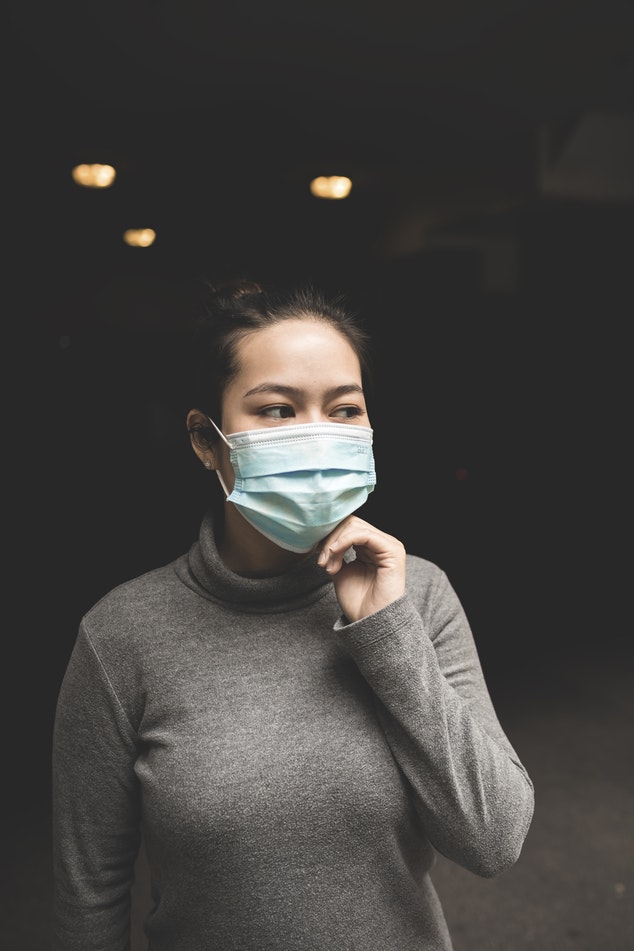
Lanying is suffering from a fever, body aches, and a painful sore throat that feels worse when she swallows. She visits her doctor, who examines her and performs a throat culture. When the results come back, he tells her that she has strep throat, which is caused by the bacteria Streptococcus pyogenes. He prescribes an antibiotic that will either kill the bacteria or stop it from reproducing, and advises her to take the full course of the treatment even if she is feeling better earlier. Stopping early can cause an increase in bacteria that are resistant to antibiotics.
Lanying takes the antibiotic as prescribed. Toward the end of the course, her throat is feeling much better — but she can’t say the same for other parts of her body! She has developed diarrhea and an itchy vaginal yeast infection. She calls her doctor, who suspects that the antibiotic treatment has caused both the digestive distress and the yeast infection. He explains that our bodies are home to many different kinds of microorganisms, some of which are actually beneficial to us because they help us digest our food and minimize the population of harmful microorganisms. When we take an antibiotic, many of these “good” bacteria are killed along with the “bad,” disease-causing bacteria, which can result in diarrhea and yeast infections.
Lanying's doctor prescribes an antifungal medication for her yeast infection. He also recommends that she eat yogurt with live cultures, which will help replace the beneficial bacteria in her gut. Our bodies contain a delicate balance of inhabitants that are invisible without a microscope, and changes in that balance can cause unpleasant health effects.
What Is Human Biology?
As you read the rest of this book, you'll learn more amazing facts about the human organism, and you'll get a better sense of how biology relates to your health. Human biology is the scientific study of the human species, which includes the fascinating story of human evolution and a detailed account of our genetics, anatomy, physiology, and ecology. In short, the study focuses on how we got here, how we function, and the role we play in the natural world. This helps us to better understand human health, because we can learn how to stay healthy and how diseases and injuries can be treated. Human biology should be of personal interest to you to the extent that it can benefit your own health, as well as the health of your friends and family. This branch of science also has broader implications for society and the human species as a whole.
Chapter Overview: Living Organisms and Human Biology
In the rest of this chapter, you'll learn about the traits shared by all living things, the basic principles that underlie all of biology, the vast diversity of living organisms, what it means to be human, and our place in the animal kingdom. Specifically, you'll learn:
- The seven traits shared by all living things: homeostasis, or the maintenance of a more-or-less constant internal environment; multiple levels of organization consisting of one or more cells; the use of energy and metabolism; the ability to grow and develop; the ability to evolve adaptations to the environment; the ability to detect and respond to environmental stimuli; and the ability to reproduce.
- The basic principles that unify all fields of biology, including gene theory, homeostasis, and evolutionary theory.
- The diversity of life (including the different kinds of biodiversity), the definition of a species, the classification and naming systems for living organisms, and how evolutionary relationships can be represented through diagrams, such as phylogenetic trees.
- How the human species is classified and how we've evolved from our close relatives and ancestors.
- The physical traits and social behaviors that humans share with other primates.
As you read this chapter, consider the following questions about Lanying's situation:
- What do single-celled organisms (such as the bacteria and yeast living in and on Lanying) have in common with humans?
- How are bacteria, yeast, and humans classified?
- How do the concepts of homeostasis and biodiversity apply to Lanying’s situation?
- Why can stopping antibiotics early cause the development of antibiotic-resistant bacteria?
Attribution
Figure 2.1.1
Photo (face mask) by Michael Amadeus, on Unsplash is used under the Unsplash license (https://unsplash.com/license).
Reference
Mayo Clinic Staff (n.d.). Strep throat [online article]. MayoClinic.org. https://www.mayoclinic.org/diseases-conditions/strep-throat/symptoms-causes/syc-20350338
Created by CK-12 Foundation/Adapted by Christine Miller

Bathing in Sunshine
Summer sun may feel good on your body, but its invisible UV rays wreak havoc on your skin. Exposing the skin to UV light causes photo-aging: premature wrinkling, brown discolourations, and other unattractive signs of sun exposure. Even worse, UV light increases your risk of skin cancer.
What Is Skin Cancer?
Skin cancer is a disease in which skin cells grow out of control. It is caused mainly by excessive exposure to UV light, which damages DNA. Therefore, skin cancer most often develops on areas of the skin that are frequently exposed to UV light. However, it can also occur on areas that are rarely exposed to UV light. Skin cancer affects people of all skin colours, including those with dark skin. It also affects more people altogether than all other cancers combined. One in five Canadians develops skin cancer in his or her lifetime.
Types of Skin Cancer
Skin cancer begins in the outer layer of skin, the epidermis. There are three common types of skin cancer: basal cell carcinoma, squamous cell carcinoma, and melanoma.
Basal Cell Carcinoma
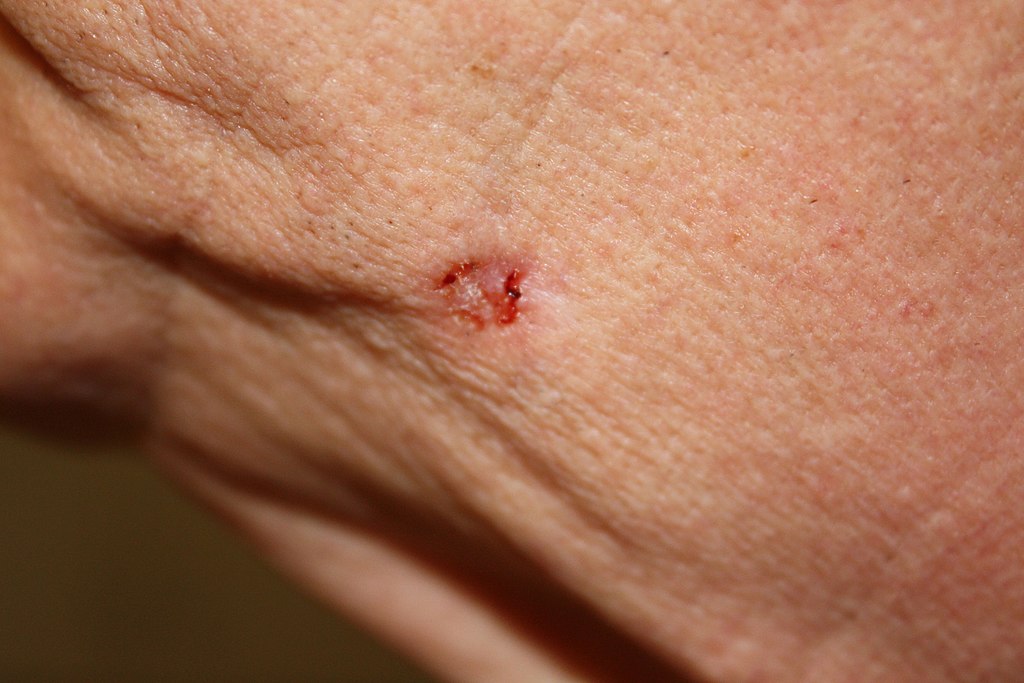
Basal cell carcinoma occurs in basal cells of the epidermis. Basal cells are stem cells in the stratum basale layer that divide to form all the keratinocytes of the epidermis. Basal cell carcinoma is the most common form of skin cancer and 1 in 8 Canadians will develop basal cell carcinoma during their lifetime. A basal cell carcinoma may appear as a pearly or waxy sore, like the one shown in Figure 10.7.2. Basal cell carcinomas rarely spread (or undergo metastasis), so they can generally be cured with a biopsy, in which the lesion is cut out of the skin and analyzed in a medical lab.
Squamous Cell Carcinoma
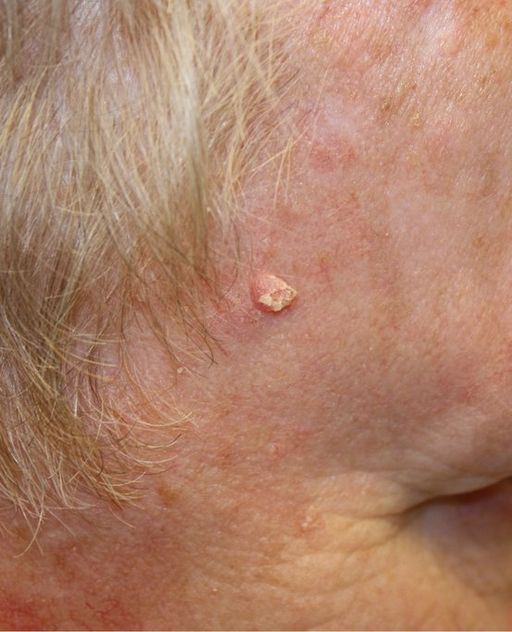
Squamous cell carcinoma occurs in squamous cells of the epidermis. Squamous cells are flattened, keratin-filled cells in upper layers of the epidermis. Squamous cell carcinoma is the second most common form of skin cancer. More than two million cases occur in the United States each year. A squamous cell carcinoma may appear as a firm, red nodule, or as a flat lesion with a scaly or crusty surface, like the one pictured in Figure 10.7.3. Squamous cell carcinomas are generally localized and unlikely to metastasize, so they are usually curable surgically.
Melanoma

Melanoma occurs in melanocytes of the epidermis. Melanocytes are the melanin-producing cells in the stratum basale of the epidermis. Melanoma is the rarest type of skin cancer, accounting for less than one per cent of all skin cancer cases. Melanoma, however, is the most deadly type of skin cancer. It causes the vast majority of skin cancer deaths, because melanoma is malignant. If not treated, it will metastasize and spread to other parts of the body. If melanoma is detected early and while it is still localized in the skin, most patients survive for at least five years. If melanoma is discovered only after it has already metastasized to distant organs, there is only a 17% of patients surviving for five years. You can see an example of a melanoma in Figure 10.7.4.
Melanoma can develop anywhere on the body. It may develop in otherwise normal skin, or an existing mole may become cancerous. Signs of melanoma may include a:
- Mole that changes in size, feel, or colour.
- Mole that bleeds.
- Large brown spot on the skin sprinkled with darker specks.
- Small lesion with an irregular border and parts that appear red, white, blue, or blue-black.
- Dark lesion on the palms, soles, fingertips, toes, or mucous membranes.
Skin Cancer Risk Factors
Exposure to UV radiation causes about 90 per cent of all skin cancer cases. The connection between skin cancer and UV light is so strong that the World Health Organization has classified UV radiation (whether from tanning beds or the sun) as a Group 1 carcinogen (cancer-causing agent). Group 1 carcinogens are those carcinogens that are known with virtual certainty to cause cancer. In addition to UV light, Group 1 carcinogens include tobacco and plutonium. In terms of numbers of cancers caused, UV radiation is far worse than tobacco. More people develop skin cancer because of UV light exposure than develop lung cancer because of smoking. The increase in cancer risk due to UV light is especially great if you have ever had blistering sunburns as a child or teen.
Besides UV light exposure, other risk factors for skin cancer include:
- Having light coloured skin.
- Having a lot of moles.
- Being diagnosed with precancerous skin lesions.
- Having a family history of skin cancer.
- Having a personal history of skin cancer.
- Having a weakened immune system.
- Being exposed to other forms of radiation or to certain toxic substances such as arsenic.
Feature: My Human Body
As with most types of cancer, skin cancer is easiest to treat and most likely to be cured the earlier it is detected. The skin is one of the few organs that you can monitor for cancer yourself, as long as you know what to look for. A brown spot on the skin is likely to be a harmless mole, but it could be a sign of skin cancer. As shown in Figure 10.7.5 below, unlike moles, skin cancers may be asymmetrical, have irregular borders, may be very dark in colour, and may have a relatively great diameter. These characteristics can be remembered with the acronym ABCD.

With the help of mirrors, you should check all of your skin regularly. Look for new skin growths or changes in any existing moles, freckles, bumps, or birthmarks. Report anything suspicious or different to your doctor.
If you have risk factors for skin cancer, it’s a good idea to have an annual skin check by a dermatologist. This helps ensure that cancerous or precancerous lesions will be detected before they grow too large and become difficult to cure, or in the case of melanoma, before they metastasize.
10.7 Summary
- Skin cancer is a disease in which skin cells grow out of control. It is caused mainly by excessive exposure to UV light, which damages DNA. Skin cancer affects more Canadians than all other cancers combined. There are three common types of skin cancer: basal cell carcinoma, squamous cell carcinoma, and melanoma. Carcinomas are more common and unlikely to metastasize. Melanoma is rare and likely to metastasize. It causes most skin cancer deaths.
- Besides exposure to UV light, risk factors for skin cancer include having light coloured skin, having lots of moles, and a family history of skin cancer, among several others.
10.7 Review Questions
- What is skin cancer?
- How common is skin cancer?
-
- Compare and contrast the three common types of skin cancer.
- Identify factors that increase the risk of skin cancer.
- How does exposure to UV light cause skin cancer?
- In which layer of the skin does skin cancer normally start?
- Which two skin cancers described in this section start in the same sub-layer? Include the name of the sub-layer and the cells affected in each of these cancers.
- Which type of skin cancer is most likely to spread to other organs? Explain your answer.
- Which form of skin cancer is the most deadly?
- What are some ways people can reduce their risk of getting skin cancer? Explain your answer.
10.7 Explore More
https://www.youtube.com/watch?v=60e-t4zglBk&feature=emb_logo
The skin 'beauty' and the sun 'beast': Charareh Pourzand at TEDxBathUniveristy, TEDx Talks, 2014.
https://www.youtube.com/watch?v=ID-O-Ion3EQ&feature=emb_logo
Cancer of the Vulva, Robert Miller, 2014.
https://www.youtube.com/watch?v=BmFEoCFDi-w
How do cancer cells behave differently from healthy ones? - George Zaidan, TED-Ed, 2012.
Attributions
Figure 10.7.1
Stolen_Moment_in_the_Sun by Angie Garrett on Wikimedia Commons is used under a CC BY 2.0 (https://creativecommons.org/licenses/by/2.0) license.
Figure 10.7.2
Basal_cell_carcinoma,_ulcerated by Kelly Nelson (Photographer) from National Cancer Institute (part of the National Institutes of Health) with the ID 9237 on Wikimedia Commons was released into the public domain (https://en.wikipedia.org/wiki/Public_domain).
Figure 10.7.3
Squamous_cell_carcinoma_(1) by Kelly Nelson (Photographer) from National Cancer Institute (part of the National Institutes of Health) with the ID 9248 on Wikimedia Commons was released into the public domain (https://en.wikipedia.org/wiki/Public_domain).
Figure 10.7.4
Melanoma by Unknown author (Photographer) from National Cancer Institute (part of the National Institutes of Health) with the AV-8500-3850/ ID 9186 on Wikimedia Commons was released into the public domain (https://en.wikipedia.org/wiki/Public_domain).
Figure 10.7.5
ABCDs of skin cancer by CK-12 Foundation is used under a CC BY-NC 3.0 (https://creativecommons.org/licenses/by-nc/3.0/) license. (Original images courtesy of NCI: ID numbers 2362; 2363; 2364; and 2184)
References
Brainard, J/ CK-12 Foundation. (2016). Figure 5 ABCDs of skin cancer[digital image]. In CK-12 College Human Biology (Section 12.7) [online Flexbook]. CK12.org. https://www.ck12.org/book/ck-12-college-human-biology/section/12.7/
Public Health Agency of Canada. (2019, December 9). Non melanoma skin cancer. Canada.ca. https://www.canada.ca/en/public-health/services/chronic-diseases/cancer/non-melanoma-skin-cancer.html
Robert Miller. (2014, July 22). Cancer of the vulva. YouTube. https://www.youtube.com/watch?v=ID-O-Ion3EQ
TED-Ed. (2012, December 5). How do cancer cells behave differently from healthy ones? - George Zaidan. YouTube. https://www.youtube.com/watch?v=BmFEoCFDi-w
TEDx Talks. (2014, March 28). The skin 'beauty' and the sun 'beast': Charareh Pourzand at TEDxBathUniveristy. YouTube. https://www.youtube.com/watch?v=60e-t4zglBk
Created by CK-12 Foundation/Adapted by Christine Miller
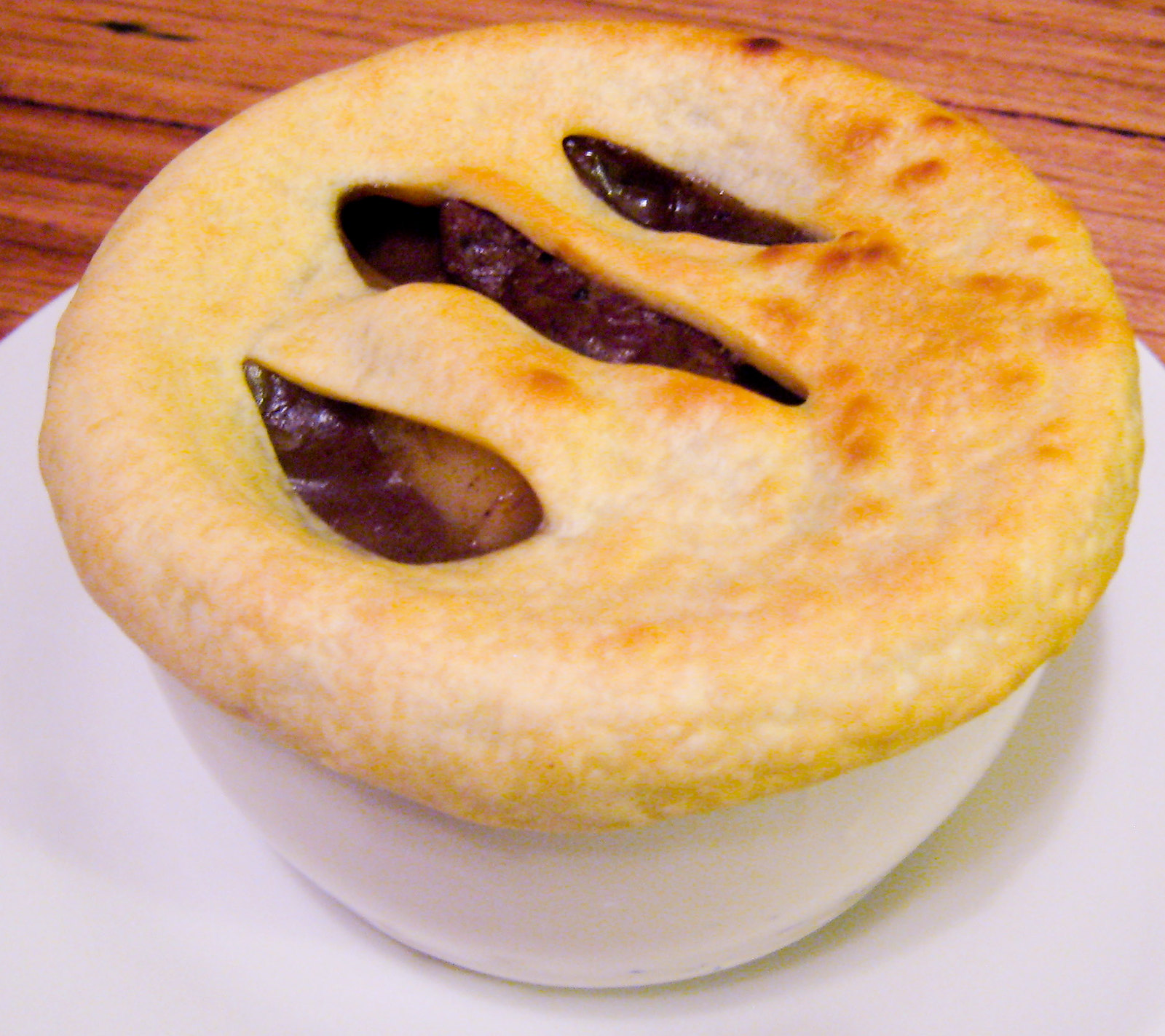
Kidneys on the Menu
Pictured in Figure 16.4.1 is a steak and kidney pie; this savory dish is a British favorite. When kidneys are on a menu, they typically come from sheep, pigs, or cows. In these animals (as in the human animal), kidneys are the main organs of excretion.
Location of the Kidneys
The two bean-shaped kidneys are located high in the back of the abdominal cavity, one on each side of the spine. Both kidneys sit just below the diaphragm, the large breathing muscle that separates the abdominal and thoracic cavities. As you can see in the following figure, the right kidney is slightly smaller and lower than the left kidney. The right kidney is behind the liver, and the left kidney is behind the spleen. The location of the liver explains why the right kidney is smaller and lower than the left.
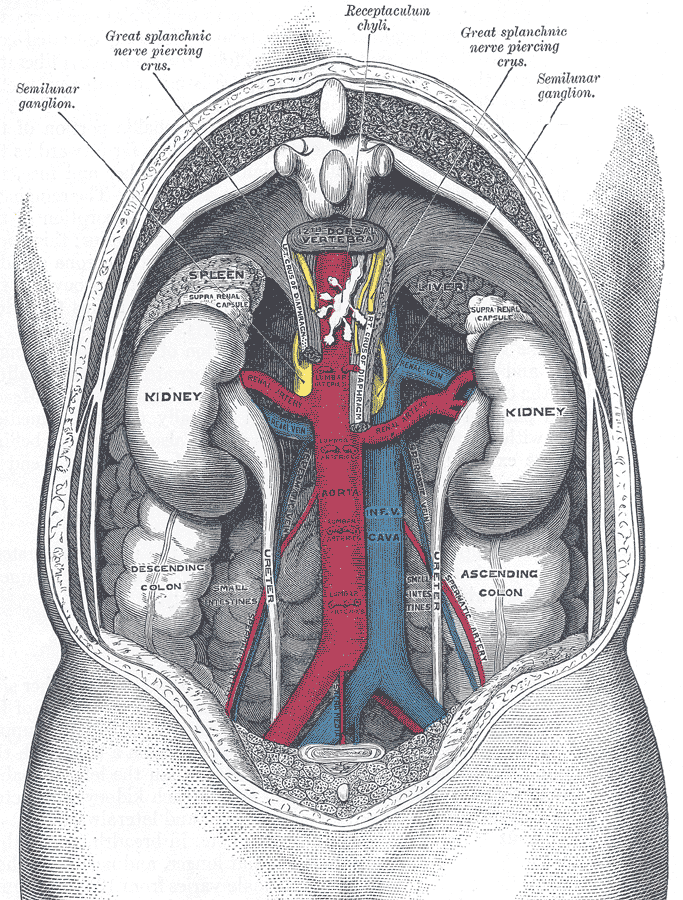
Kidney Anatomy
The shape of each kidney gives it a convex side (curving outward) and a concave side (curving inward). You can see this clearly in the detailed diagram of kidney anatomy shown in Figure 16.4.3. The concave side is where the renal artery enters the kidney, as well as where the renal vein and ureter leave the kidney. This area of the kidney is called the hilum. The entire kidney is surrounded by tough fibrous tissue — called the renal capsule — which, in turn, is surrounded by two layers of protective, cushioning fat.
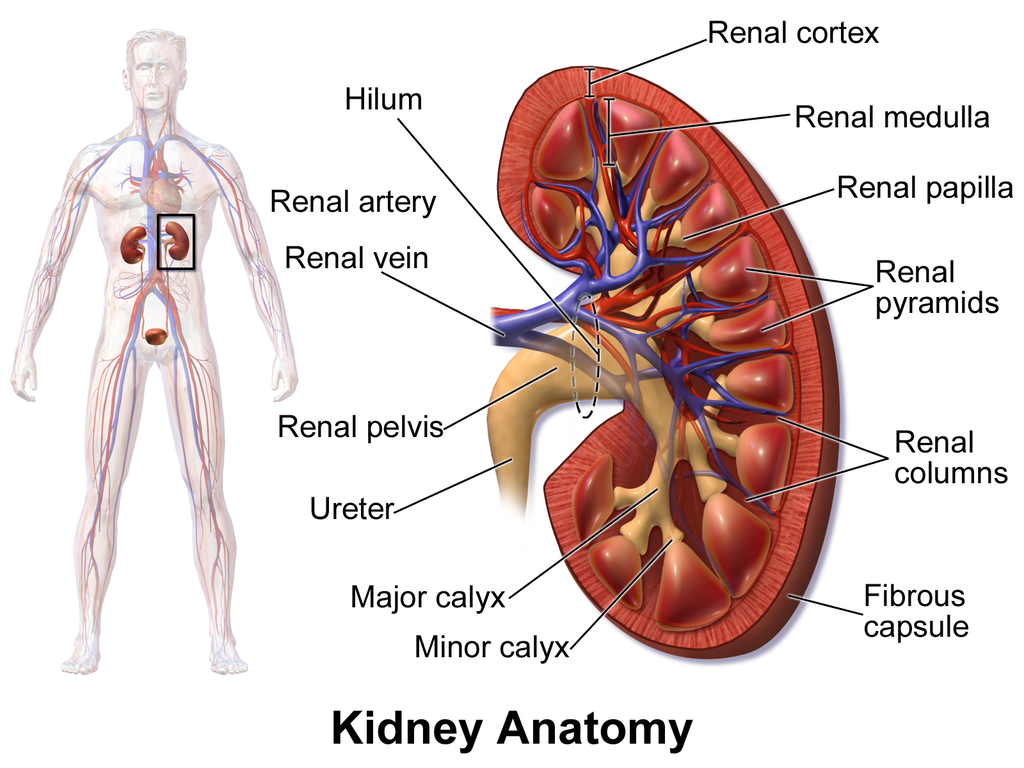
Internally, each kidney is divided into two major layers: the outer renal cortex and the inner renal medulla (see Figure 16.4.3 above). These layers take the shape of many cone-shaped renal lobules, each containing renal cortex surrounding a portion of medulla called a renal pyramid. Within the renal pyramids are the structural and functional units of the kidneys, the tiny nephrons. Between the renal pyramids are projections of cortex called renal columns. The tip, or papilla, of each pyramid empties urine into a minor calyx (chamber). Several minor calyces empty into a major calyx, and the latter empty into the funnel-shaped cavity called the renal pelvis, which becomes the ureter as it leaves the kidney.
Renal Circulation
The renal circulation is an important part of the kidney’s primary function of filtering waste products from the blood. Blood is supplied to the kidneys via the renal arteries. The right renal artery supplies the right kidney, and the left renal artery supplies the left kidney. These two arteries branch directly from the aorta, which is the largest artery in the body. Each kidney is only about 11 cm (4.4 in) long, and has a mass of just 150 grams (5.3 oz), yet it receives about ten per cent of the total output of blood from the heart. Blood is filtered through the kidneys every 3 minutes, 24 hours a day, every day of your life.
As indicated in Figure 16.4.4, each renal artery carries blood with waste products into the kidney. Within the kidney, the renal artery branches into increasingly smaller arteries that extend through the renal columns between the renal pyramids. These arteries, in turn, branch into arterioles that penetrate the renal pyramids. Blood in the arterioles passes through nephrons, the structures that actually filter the blood. After blood passes through the nephrons and is filtered, the clean blood moves through a network of venules that converge into small veins. Small veins merge into increasingly larger ones, and ultimately into the renal vein, which carries clean blood away from the kidney to the inferior vena cava.
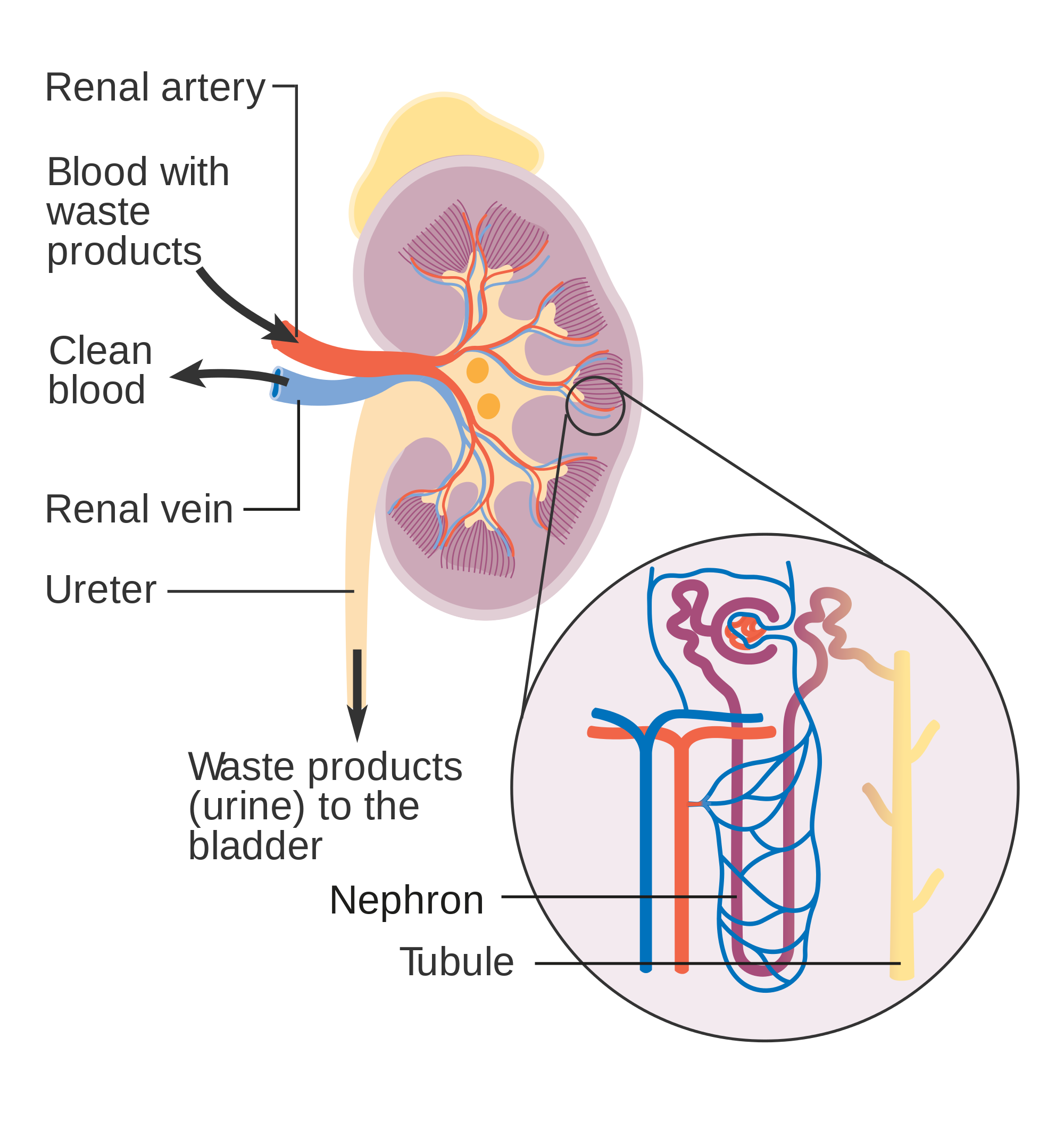
Nephron Structure and Function
Figure 16.4.4 gives an indication of the complex structure of a nephron. The nephron is the basic structural and functional unit of the kidney, and each kidney typically contains at least a million of them. As blood flows through a nephron, many materials are filtered out of the blood, needed materials are returned to the blood, and the remaining materials form urine. Most of the waste products removed from the blood and excreted in urine are byproducts of metabolism. At least half of the waste is urea, a waste product produced by protein catabolism. Another important waste is uric acid, produced in nucleic acid catabolism.
Components of a Nephron
Figure 16.4.5 shows in greater detail the components of a nephron. Each nephron is composed of an initial filtering component that consists of a network of capillaries called the glomerulus (plural, glomeruli), which is surrounded by a space within a structure called glomerular capsule (also known as the Bowman's capsule). Extending from glomerular capsule is the renal tubule. The proximal end (nearest glomerular capsule) of the renal tubule is called the proximal convoluted (coiled) tubule. From here, the renal tubule continues as a loop (known as the loop of Henle) (also known as the loop of the nephron), which in turn becomes the distal convoluted tubule. The latter finally joins with a collecting duct. As you can see in the diagram, arterioles surround the total length of the renal tubule in a mesh called the peritubular capillary network.

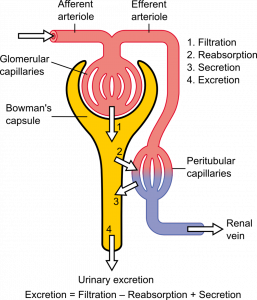
Function of a Nephron
The simplified diagram of a nephron in Figure 16.4.6 shows an overview of how the nephron functions. Blood enters the nephron through an arteriole called the afferent arteriole. Next, some of the blood passes through the capillaries of the glomerulus. Any blood that doesn’t pass through the glomerulus — as well as blood after it passes through the glomerular capillaries — continues on through an arteriole called the efferent arteriole. The efferent arteriole follows the renal tubule of the nephron, where it continues playing a role in nephron functioning.
Filtration
As blood from the afferent arteriole flows through the glomerular capillaries, it is under pressure. Because of the pressure, water and solutes are filtered out of the blood and into the space made by glomerular capsule, almost like the water you cook pasta is is filtered out through a strainer. This is the filtration stage of nephron function. The filtered substances — called filtrate — pass into glomerular capsule, and from there into the proximal end of the renal tubule. Anything too large to move through the pores in the glomerulus, such as blood cells, large proteins, etc., stay in the cardiovascular system. At this stage, filtrate (fluid in the nephron) includes water, salts, organic solids (such as nutrients), and waste products of metabolism (such as urea).
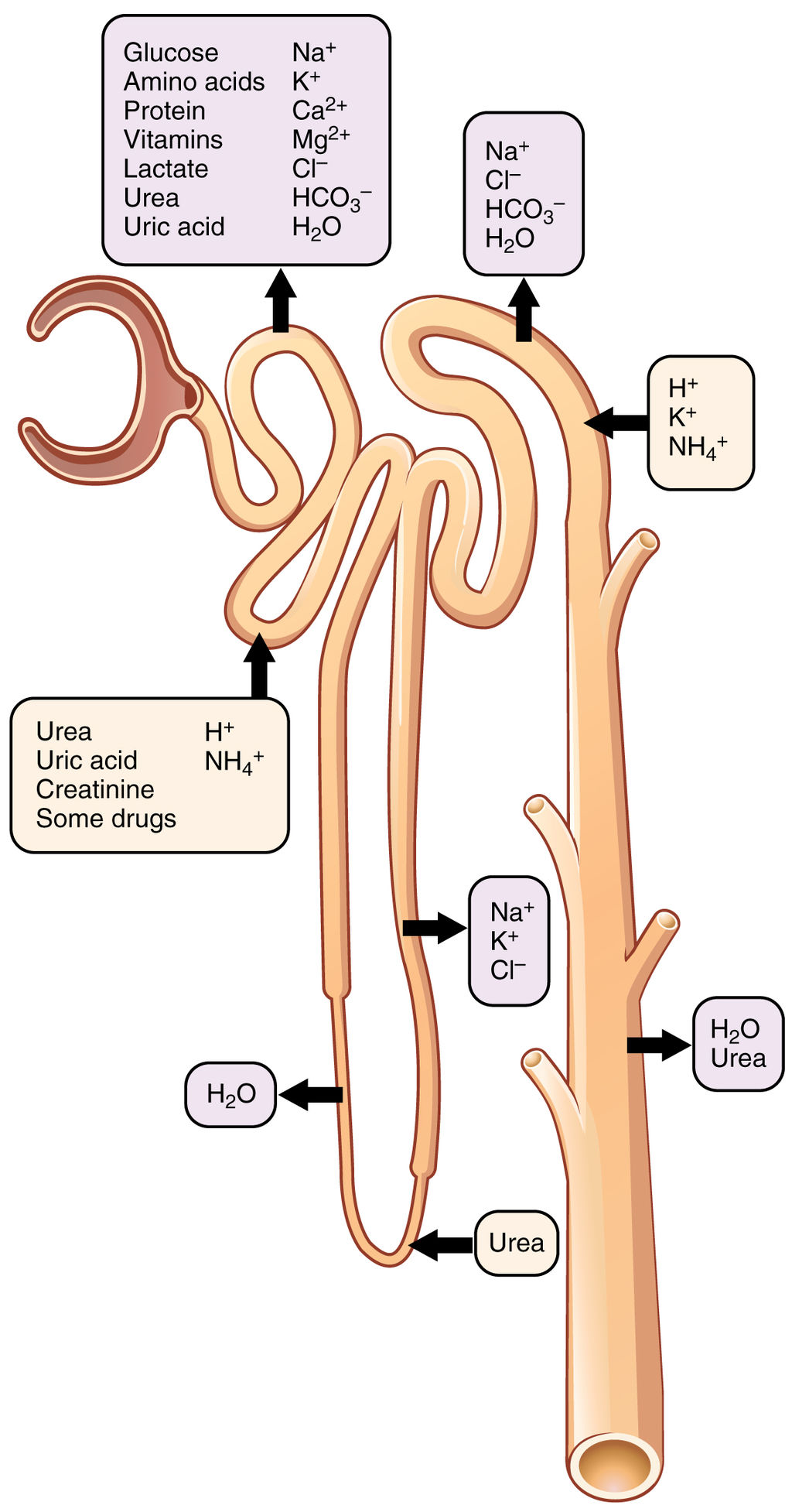
Reabsorption and Secretion
As filtrate moves through the renal tubule, some of the substances it contains are reabsorbed from the filtrate back into the blood in the efferent arteriole (via peritubular capillary network). This is the reabsorption stage of nephron function and it is about returning "the good stuff" back to the blood so that it doesn't exit the body in urine. About two-thirds of the filtered salts and water, and all of the filtered organic solutes (mainly glucose and amino acids) are reabsorbed from the filtrate by the blood in the peritubular capillary network. Reabsorption occurs mainly in the proximal convoluted tubule and the loop of Henle, as seen in Figure 16.4.7.
At the distal end of the renal tubule, some additional reabsorption generally occurs. This is also the region of the tubule where other substances from the blood are added to the filtrate in the tubule. The addition of other substances to the filtrate from the blood is called secretion. Both reabsorption and secretion (shown in Figure 16.4.7) in the distal convoluted tubule are largely under the control of endocrine hormones that maintain homeostasis of water and mineral salts in the blood. These hormones work by controlling what is reabsorbed into the blood from the filtrate and what is secreted from the blood into the filtrate to become urine. For example, parathyroid hormone causes more calcium to be reabsorbed into the blood and more phosphorus to be secreted into the filtrate.
Collection of Urine and Excretion
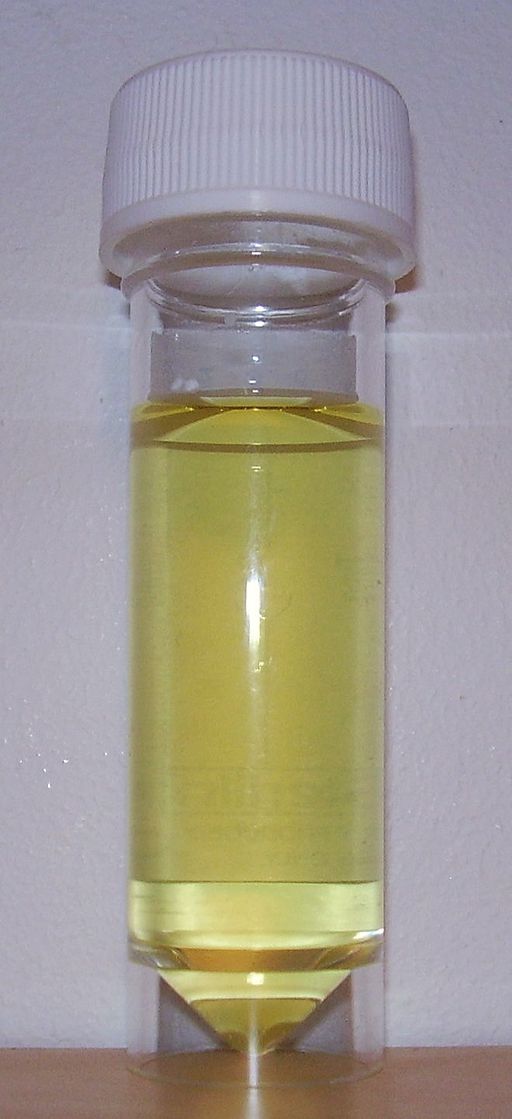
By the time the filtrate has passed through the entire renal tubule, it has become the liquid waste known as urine. Urine empties from the distal end of the renal tubule into a collecting duct. From there, the urine flows into increasingly larger collecting ducts. As urine flows through the system of collecting ducts, more water may be reabsorbed from it. This will occur in the presence of antidiuretic hormone from the posterior pituitary gland. This hormone makes the collecting ducts permeable to water, allowing water molecules to pass through them into capillaries by osmosis, while preventing the passage of ions or other solutes. As much as 75% of the water may be reabsorbed from urine in the collecting ducts, making the urine more concentrated.
Urine finally exits the largest collecting ducts through the renal papillae. It empties into the renal calyces, and finally into the renal pelvis. From there, it travels through the ureter to the urinary bladder for eventual excretion from the body. An average of roughly 1.5 litres (a little over 6 cups) of urine is excreted each day. Normally, urine is yellow or amber in colour (see Figure 16.4.8). The darker the colour, generally speaking, the more concentrated the urine is.
Besides filtering blood and forming urine for excretion of soluble wastes, the kidneys have several vital functions in maintaining body-wide homeostasis. Most of these functions are related to the composition or volume of urine formed by the kidneys. The kidneys must maintain the proper balance of water and salts in the body, normal blood pressure, and the correct range of blood pH. Through the processes of absorption and secretion by nephrons, more or less water, salt ions, acids, or bases are returned to the blood or excreted in urine, as needed, to maintain homeostasis.
Blood Pressure Regulation
The kidneys do not control homeostasis all alone. As indicated above, endocrine hormones are also involved. Consider the regulation of blood pressure by the kidneys. Blood pressure is the pressure exerted by blood on the walls of the arteries. The regulation of blood pressure is part of a complex system, called the renin-angiotensin-aldosterone system. This system regulates the concentration of sodium in the blood to control blood pressure.
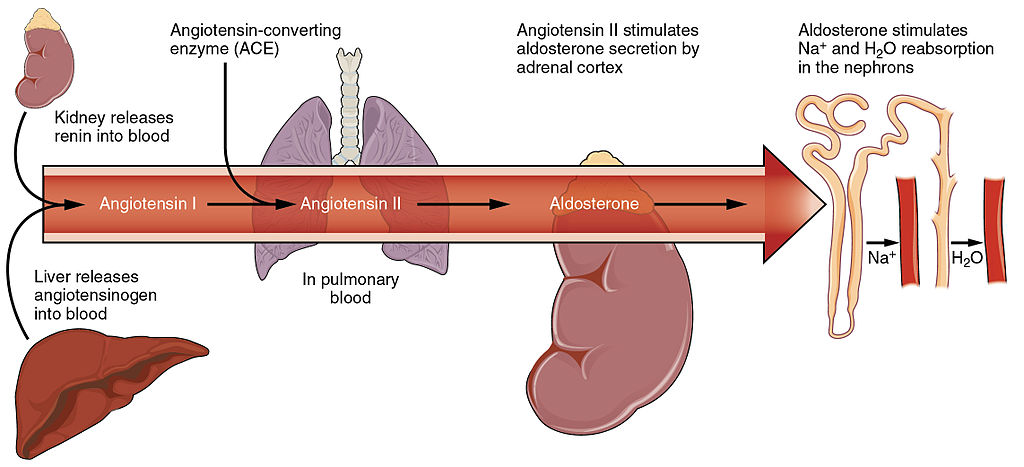
The renin-angiotensin-aldosterone system is put into play when the concentration of sodium ions in the blood falls lower than normal. This causes the kidneys to secrete an enzyme called renin into the blood. It also causes the liver to secrete a protein called angiotensinogen. Renin changes angiotensinogen into a proto-hormone called angiotensin I. This is converted to angiotensin II by an enzyme (angiotensin-converting enzyme) in lung capillaries.
Angiotensin II is a potent hormone that causes arterioles to constrict. This, in turn, increases blood pressure. Angiotensin II also stimulates the secretion of the hormone aldosterone from the adrenal cortex. Aldosterone causes the kidneys to increase the reabsorption of sodium ions and water from the filtrate into the blood. This returns the concentration of sodium ions in the blood to normal. The increased water in the blood also increases blood volume and blood pressure.
Other Kidney Hormones
Hormones other than renin are also produced and secreted by the kidneys. These include calcitriol and erythropoietin.
- Calcitriol is secreted by the kidneys in response to low levels of calcium in the blood. This hormone stimulates uptake of calcium by the intestine, thus raising blood levels of calcium.
- Erythropoietin is secreted by the kidneys in response to low levels of oxygen in the blood. This hormone stimulates erythropoiesis, which is the production of erythrocytes in bone marrow. Extra red blood cells increase the level of oxygen carried in the blood.
Feature: Human Biology in the News
Kidney failure is a complication of common disorders including diabetes mellitus and hypertension. It is estimated that approximately 12.5% of Canadians have some form of kidney disease. If the disease is serious, the patient must either receive a donated kidney or have frequent hemodialysis, a medical procedure in which the blood is artificially filtered through a machine. Transplant generally results in better outcomes than hemodialysis, but demand for organs far outstrips the supply. The average time on the organ donation waitlist for a kidney is four years. There are over 3,000 Canadians on the wait list for a kidney transplant and some will die waiting for a kidney to become available.
For the past decade, Dr. William Fissell, a kidney specialist at Vanderbilt University, has been working to create an implantable part-biological and part-artificial kidney. Using microchips like those used in computers, he has produced an artificial kidney small enough to implant in the patient’s body in place of the failed kidney. According to Dr. Fissell, the artificial kidney is “... a bio-hybrid device that can mimic a kidney to remove enough waste products, salt, and water to keep a patient off [hemo]dialysis.”
The filtration system in the artificial kidney consists of a stack of 15 microchips. Tiny pores in the microchips act as a scaffold for the growth of living kidney cells that can mimic the natural functions of the kidney. The living cells form a membrane to filter the patient’s blood as a biological kidney would, but with less risk of rejection by the patient’s immune system, because they are embedded within the device. The new kidney doesn’t need a power source, because it uses the natural pressure of blood flowing through arteries to push the blood through the filtration system. A major part of the design of the artificial organ was devoted to fine tuning the fluid dynamics so blood flows through the device without clotting.
Because of the potential life-saving benefits of the device, the implantable kidney was given fast-track approval for testing in people by the U.S. Food and Drug Administration. The artificial kidney is expected to be tested in pilot trials by 2018. Dr. Fissell says he has a long list of patients eager to volunteer for the trials.
16.4 Summary
- The two bean-shaped kidneys are located high in the back of the abdominal cavity on either side of the spine. A renal artery connects each kidney with the aorta, and transports unfiltered blood to the kidney. A renal vein connects each kidney with the inferior vena cava and transports filtered blood back to the circulation.
- The kidney has two main layers involved in the filtration of blood and formation of urine: the outer cortex and inner medulla. At least a million nephrons — which are the tiny functional units of the kidney — span the cortex and medulla. The entire kidney is surrounded by a fibrous capsule and protective fat layers.
- As blood flows through a nephron, many materials are filtered out of the blood, needed materials are returned to the blood, and the remaining materials are used to form urine.
- In each nephron, the glomerulus and surrounding Bowman’s capsule form the unit that filters blood. From Bowman’s capsule, the material filtered from blood (called filtrate) passes through the long renal tubule. As it does, some substances are reabsorbed into the blood, and other substances are secreted from the blood into the filtrate, finally forming urine. The urine empties into collecting ducts, where more water may be reabsorbed.
- The kidneys control homeostasis with the help of endocrine hormones. The kidneys, for example, are part of the renin-angiotensin-aldosterone system that regulates the concentration of sodium in the blood to control blood pressure. In this system, the enzyme renin secreted by the kidneys works with hormones from the liver and adrenal gland to stimulate nephrons to reabsorb more sodium and water from urine.
- The kidneys also secrete endocrine hormones, including calcitriol — which helps control the level of calcium in the blood — and erythropoietin, which stimulates bone marrow to produce red blood cells.
16.4 Review Questions
-
- Contrast the renal artery and renal vein.
- Identify the functions of a nephron. Describe in detail what happens to fluids (blood, filtrate, and urine) as they pass through the parts of a nephron.
- Identify two endocrine hormones secreted by the kidneys, along with the functions they control.
- Name two regions in the kidney where water is reabsorbed.
- Is the blood in the glomerular capillaries more or less filtered than the blood in the peritubular capillaries? Explain your answer.
- What do you think would happen if blood flow to the kidneys is blocked?
16.4 Explore More
https://youtu.be/FN3MFhYPWWo
How do your kidneys work? - Emma Bryce, TED-Ed, 2015.
https://youtu.be/es-t8lO1KpA
Urine Formation, Hamada Abass, 2013.
https://youtu.be/bX3C201O4MA
Printing a human kidney - Anthony Atala, TED-Ed, 2013.
Attributions
Figure 16.4.1
Steak and Kidney Pie by Charles Haynes on Flickr is used under a CC BY-SA 2.0 (https://creativecommons.org/licenses/by-sa/2.0/) license.
Figure 16.4.2
Gray Kidneys by Henry Vandyke Carter (1831-1897) on Wikimedia Commons is in the public domain (https://en.wikipedia.org/wiki/public_domain). (Bartleby.com: Gray’s Anatomy, Plate 1120).
Figure 16.4.3
Blausen_0592_KidneyAnatomy_01 by BruceBlaus on Wikimedia Commons is used under a CC BY 3.0 (https://creativecommons.org/licenses/by/3.0) license.
Figure 16.4.4
Diagram_showing_how_the_kidneys_work_CRUK_138.svg by Cancer Research UK on Wikimedia Commons is used under a CC BY-SA 4.0 (https://creativecommons.org/licenses/by-sa/4.0) license.
Figure 16.4.5
Blood_Flow_in_the_Nephron by OpenStax College on Wikimedia Commons is used under a CC BY 3.0 (https://creativecommons.org/licenses/by/3.0) license.
Figure 16.4.6
1024px-Physiology_of_Nephron by Madhero88 on Wikimedia Commons is used under a CC BY 3.0 (https://creativecommons.org/licenses/by/3.0) license.
Figure 16.4.7
Nephron_Secretion_Reabsorption by OpenStax College on Wikimedia Commons is used under a CC BY 3.0 (https://creativecommons.org/licenses/by/3.0) license.
Figure 16.4.8
Urine by User:Markhamilton at English Wikipedia on Wikimedia Commons is in the public domain (https://en.wikipedia.org/wiki/Public_domain).
Figure 16.4.9
Renin_Angiotensin_System-01 by OpenStax College on Wikimedia Commons is used under a CC BY 3.0 (https://creativecommons.org/licenses/by/3.0) license.
References
Betts, J. G., Young, K.A., Wise, J.A., Johnson, E., Poe, B., Kruse, D.H., Korol, O., Johnson, J.E., Womble, M., DeSaix, P. (2013, June 19). Figure 25.10 Blood flow in the nephron [digital image]. In Anatomy and Physiology (Section 25.3). OpenStax. https://openstax.org/books/anatomy-and-physiology/pages/25-3-gross-anatomy-of-the-kidney
Betts, J. G., Young, K.A., Wise, J.A., Johnson, E., Poe, B., Kruse, D.H., Korol, O., Johnson, J.E., Womble, M., DeSaix, P. (2013, June 19). Figure 25.17 Locations of secretion and reabsorption in the nephron [digital image]. In Anatomy and Physiology (Section 25.6). OpenStax. https://openstax.org/books/anatomy-and-physiology/pages/25-6-tubular-reabsorption
Betts, J. G., Young, K.A., Wise, J.A., Johnson, E., Poe, B., Kruse, D.H., Korol, O., Johnson, J.E., Womble, M., DeSaix, P. (2013, June 19). Figure 26.14 The renin-angiotensin system [digital image]. In Anatomy and Physiology (Section 26.3). OpenStax. https://openstax.org/books/anatomy-and-physiology/pages/26-3-electrolyte-balance
Blausen.com Staff. (2014). Medical gallery of Blausen Medical 2014. WikiJournal of Medicine 1 (2). DOI:10.15347/wjm/2014.010. ISSN 2002-4436
Hamada Abass. (2013). Urine formation. YouTube. https://www.youtube.com/watch?v=es-t8lO1KpA&feature=youtu.be
TED-Ed. (2015, February 9). How do your kidneys work? - Emma Bryce. YouTube. https://www.youtube.com/watch?v=FN3MFhYPWWo&feature=youtu.be
TED-Ed. (2013, March 15). Printing a human kidney - Anthony Atala. YouTube. https://www.youtube.com/watch?v=bX3C201O4MA&feature=youtu.be
bony “cage” enclosing the thoracic cavity and consisting of the ribs, thoracic vertebrae, and sternum
Created by CK-12 Foundation/Adapted by Christine Miller
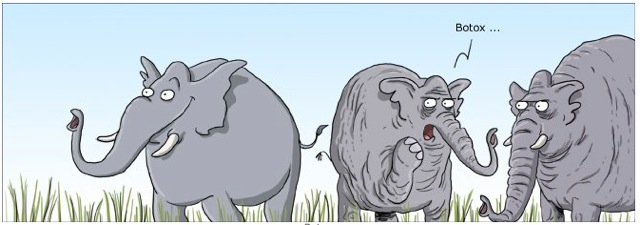
Case Study Conclusion: Needing to Relax
As you learned in the beginning of this chapter, botulinum toxin — one form of which is sold under the brand name Botox — does much more than smooth out wrinkles. It can be used to treat a number of disorders involving excessive muscle contraction, including cervical dystonia. You also learned that cervical dystonia, which Edward suffers from, causes abnormal, involuntary muscle contractions of the neck. This results in jerky movements of the head and neck, and/or a sustained abnormal tilt to the head. It is often painful and can significantly interfere with a person’s life.

How could a toxin actually help treat a muscular disorder? The botulinum toxin is produced by the soil bacterium, Clostridium botulinum, and it is the cause of the potentially deadly disease called botulism. Botulism is often a foodborne illness, commonly caused by foods that are improperly canned. Other forms of botulism are caused by wound infections, or occur when infants consume spores of the bacteria from soil or honey.
Botulism can be life-threatening, because it paralyzes muscles throughout the body, including those involved in breathing. When a very small amount of botulinum toxin is injected carefully into specific muscles by a trained medical professional, however, it can be useful in inhibiting unwanted muscle contractions.
For cosmetic purposes, botulinum toxin injected into the facial muscles relaxes them to reduce the appearance of wrinkles. When used to treat cervical dystonia, it is injected into the muscles of the neck to inhibit excessive muscle contractions. For many patients, this helps relieve the abnormal positioning, movements, and pain associated with the disorder. The effect is temporary, so the injections must be repeated every three to four months to keep the symptoms under control.
How does botulinum toxin inhibit muscle contraction? First, recall how skeletal muscle contraction works. A motor neuron instructs skeletal muscle fibres to contract at a synapse between them called the neuromuscular junction. A nerve impulse called an action potential travels down to the axon terminal of the motor neuron, where it causes the release of the neurotransmitter acetylcholine (ACh) from synaptic vesicles. The ACh travels across the synaptic cleft and binds to ACh receptors on the muscle fibre, signaling the muscle fibre to contract. According to the sliding filament theory, the contraction of the muscle fibre occurs due to the sliding of myosin and actin filaments across each other. This causes the Z discs of the sacromeres to move closer together, shortening the sacromeres and causing the muscle fibre to contract.
If you wanted to inhibit muscle contraction, at what points could you theoretically interfere with this process? Inhibiting the action potential in the motor neuron, the release of ACh, the activity of ACh receptors, or the sliding filament process in the muscle fibre would all theoretically impair this process and inhibit muscle contraction. For example, in the disease myasthenia gravis, the function of the ACh receptors is impaired, causing a lack of sufficient muscle contraction. As you have learned, this results in muscle weakness that can eventually become life-threatening. Botulinum toxin works by inhibiting the release of ACh from the motor neurons, thereby removing the signal instructing the muscles to contract.
Fortunately, Edward’s excessive muscle contractions and associated pain improved significantly thanks to botulinum toxin injections. Although cervical dystonia cannot currently be cured, botulinum toxin injections have improved the quality of life for many patients with this and other disorders involving excessive involuntary muscle contractions.
As you have learned in this chapter, our muscular system allows us to do things like make voluntary movements, digest our food, and pump blood through our bodies. Whether they are in your arm, heart, stomach, or blood vessels, muscle tissue works by contracting. But as you have seen here, too much contraction can be a very bad thing. Fortunately, scientists and physicians have found a way to put a potentially deadly toxin — and wrinkle-reducing treatment — to excellent use as a medical treatment for some muscular system disorders.
Chapter 12 Summary
In this chapter, you learned about the muscular system. Specifically, you learned that:
- The muscular system consists of all the muscles of the body. There are three types of muscle: skeletal muscle (which is attached to bones by tendons and enables voluntary body movements), cardiac muscle (which makes up the walls of the heart and makes it beat) and smooth muscle (which is found in the walls of internal organs and other internal structures and controls their movements).
- Muscles are organs composed mainly of muscle cells, which may also be called muscle fibres or myocytes. Muscle cells are specialized for the function of contracting, which occurs when protein filaments inside the cells slide over one another using energy from ATP. Muscle tissue is the only type of tissue that has cells with the ability to contract.
- Muscles can grow larger, or hypertrophy. This generally occurs through increased use, although hormonal or other influences can also play a role. Muscles can also grow smaller, or atrophy. This may occur through lack of use, starvation, certain diseases, or aging. In both hypertrophy and atrophy, the size — but not the number — of muscle fibres changes. The size of muscles is the main determinant of muscle strength.
- Skeletal muscles need the stimulus of motor neurons to contract, and to move the body, they need the skeletal system to act upon.
- Skeletal muscle is the most common type of muscle tissue in the human body. To move bones in opposite directions, skeletal muscles often consist of pairs of muscles that work in opposition to one another to move bones in different directions at joints.
- Skeletal muscle fibres are bundled together in units called muscle fascicles, which are bundled together to form individual skeletal muscles. Skeletal muscles also have connective tissue supporting and protecting the muscle tissue.
-
- Each skeletal muscle fibre consists of a bundle of myofibrils, which are bundles of protein filaments. The filaments are arranged in repeating units called sarcomeres, which are the basic functional units of skeletal muscles. Skeletal muscle tissue is striated, because of the pattern of sarcomeres in its fibres.
- Skeletal muscle fibres can be divided into two types, called slow-twitch and fast-twitch fibres. Slow-twitch fibres are used mainly in aerobic endurance activities (such as long-distance running). Fast-twitch fibres are used mainly for non-aerobic, strenuous activities (such as sprinting). Proportions of the two types of fibres vary from muscle to muscle and person to person.
- Smooth muscle tissue is found in the walls of internal organs and vessels. When smooth muscles contract, they help the organs and vessels carry out their functions. The pattern of smooth muscle contraction to move substances through body tubes is called peristalsis. Contractions of smooth muscles are involuntary and controlled by the autonomic nervous system, hormones, and other substances.
-
- Cells of smooth muscle tissue are not striated because they lack sarcomeres, but the cells contract in the same basic way as striated muscle cells. Unlike striated muscle, smooth muscle can sustain very long-term contractions and maintain its contractile function, even when stretched.
- Cardiac muscle tissue is found only in the wall of the heart. When cardiac muscle contracts, the heart beats and pumps blood. Contractions of cardiac muscle are involuntary, like those of smooth muscles. They are controlled by electrical impulses from specialized cardiac cells.
-
- Like skeletal muscle, cardiac muscle is striated because its filaments are arranged in sarcomeres. The exact arrangement, however, differs, making cardiac and skeletal muscle tissues look different from one another.
- The heart is the muscle that performs the greatest amount of physical work in the course of a lifetime. Its cells contain a great many mitochondria to produce ATP for energy and to help the heart resist fatigue.
- A muscle contraction is an increase in the tension or a decrease in the length of a muscle. A muscle contraction is isometric if muscle tension changes, but muscle length remains the same. It is isotonic if muscle length changes, but muscle tension remains the same.
-
- A skeletal muscle contraction begins with electrochemical stimulation of a muscle fibre by a motor neuron. This occurs at a chemical synapse called a neuromuscular junction. The neurotransmitter acetylcholine diffuses across the synaptic cleft and binds to receptors on the muscle fibre. This initiates a muscle contraction.
- Once stimulated, the protein filaments within the skeletal muscle fibre slide past each other to produce a contraction. The sliding filament theory is the most widely accepted explanation for how this occurs. According to this theory, thick myosin filaments repeatedly attach to and pull on thin actin filaments, thus shortening sarcomeres.
- Crossbridge cycling is a cycle of molecular events that underlies the sliding filament theory. Using energy in ATP, myosin heads repeatedly bind with and pull on actin filaments. This moves the actin filaments toward the center of a sarcomere, shortening the sarcomere and causing a muscle contraction.
- The ATP needed for a muscle contraction comes first from ATP already available in the cell, and more is generated from creatine phosphate. These sources are quickly used up. Glucose and glycogen can be broken down to form ATP and pyruvate. Pyruvate can then be used to produce ATP in aerobic respiration if oxygen is available, or it can be used in anaerobic respiration if oxygen is not available.
- Physical exercise is defined as any bodily activity that enhances or maintains physical fitness and overall health. Activities such as household chores may even count as physical exercise! Current recommendations for adults are 30 minutes of moderate exercise a day.
- Aerobic exercise is any physical activity that uses muscles at less than their maximum contraction strength, but for long periods of time. This type of exercise uses a relatively high percentage of slow-twitch muscle fibres that consume large amounts of oxygen. Aerobic exercises increase cardiovascular endurance, and include cycling and brisk walking.
- Anaerobic exercise is any physical activity that uses muscles at close to their maximum contraction strength, but for short periods of time. This type of exercise uses a relatively high percentage of fast-twitch muscle fibres that consume small amounts of oxygen. Anaerobic exercises increase muscle and bone mass and strength, and they include push-ups and sprinting.
- Flexibility exercise is any physical activity that stretches and lengthens muscles, thereby improving range of motion and reducing risk of injury. Examples include stretching and yoga.
- Many studies have shown that physical exercise is positively correlated with a diversity of physical, mental, and emotional health benefits. Physical exercise also increases quality of life and life expectancy.
-
- Many of the benefits of exercise may come about because contracting muscles release hormones called myokines, which promote tissue repair and growth and have anti-inflammatory effects.
- Physical exercise can reduce risk factors for cardiovascular disease, including hypertension and excess body weight. Physical exercise can also increase factors associated with cardiovascular health, such as mechanical efficiency of the heart.
- Physical exercise has been shown to offer protection from dementia and other cognitive problems, perhaps because it increases blood flow or neurotransmitters in the brain, among other potential effects.
- Numerous studies suggest that regular aerobic exercise works as well as pharmaceutical antidepressants in treating mild-to-moderate depression, possibly because it increases synthesis of natural euphoriants in the brain.
- Research shows that physical exercise generally improves sleep for most people, and helps sleep disorders, such as insomnia. Other health benefits of physical exercise include better immune system function and reduced risk of type 2 diabetes and obesity.
- There is great variation in individual responses to exercise, partly due to genetic differences in proportions of slow-twitch and fast-twitch muscle fibres. People with more slow-twitch fibres may be able to develop greater endurance from aerobic exercise, whereas people with more fast-twitch fibres may be able to develop greater muscle size and strength from anaerobic exercise.
- Some adverse effects may occur if exercise is extremely intense and the body is not given proper rest between exercise sessions. Many people who overwork their muscles develop delayed onset muscle soreness (DOMS), which may be caused by tiny tears in muscle fibres.
- Musculoskeletal disorders are injuries that occur in muscles or associated tissues (such as tendons) because of biomechanical stresses. The disorders may be caused by sudden exertion, over-exertion, repetitive motions, and similar stresses.
-
- A muscle strain is an injury in which muscle fibres tear as a result of overstretching. First aid for a muscle strain includes the five steps represented by the acronym PRICE (protection, rest, ice, compression, and elevation). Medications for inflammation and pain (such as NSAIDs) may also be used.
- Tendinitis is inflammation of a tendon that occurs when it is over-extended or worked too hard without rest. Tendinitis may also be treated with PRICE and NSAIDs.
- Carpal tunnel syndrome is a biomechanical problem that occurs in the wrist when the median nerve becomes compressed between carpal bones. It may occur with repetitive use, a tumor, or trauma to the wrist. It may cause pain, numbness, and eventually — if untreated — muscle wasting in the thumb and first two fingers of the hand.
- Neuromuscular disorders are systemic disorders that occur because of problems with the nervous control of muscle contractions, or with the muscle cells themselves.
-
- Muscular dystrophy is a genetic disorder caused by defective proteins in muscle cells. It is characterized by progressive skeletal muscle weakness and death of muscle tissues.
- Myasthenia gravis is a genetic neuromuscular disorder characterized by fluctuating muscle weakness and fatigue. More muscles are affected, and muscles become increasingly weakened as the disorder progresses. Myasthenia gravis most often occurs because immune system antibodies block acetylcholine receptors on muscle cells, and because of the actual loss of acetylcholine receptors.
- Parkinson’s disease is a degenerative disorder of the central nervous system that mainly affects the muscular system and movement. It occurs because of the death of neurons in the midbrain. Characteristic signs of the disorder are muscle tremor, muscle rigidity, slowness of movement, and postural instability. Dementia and depression also often characterize advanced stages of the disease.
As you saw in this chapter, muscles need oxygen to provide enough ATP for most of their activities. In fact, all of the body’s systems require oxygen, and also need to remove waste products, such as carbon dioxide. In the next chapter, you will learn about how the respiratory system obtains and distributes oxygen throughout the body, as well as how it removes wastes, such as carbon dioxide.
Chapter 12 Review
-
- What are tendons? Name a muscular system disorder involving tendons
- Describe the relationship between muscles, muscle fibres, and fascicles.
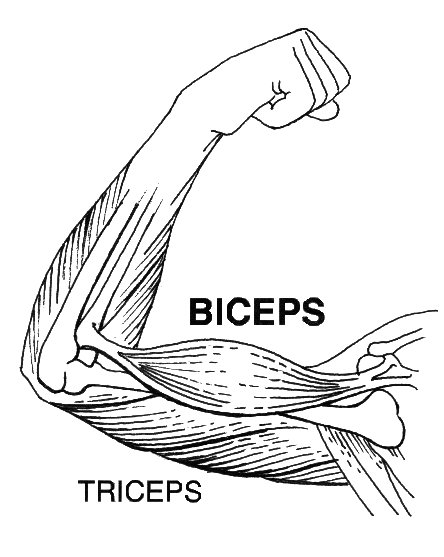
- The biceps and triceps muscles are shown above. Answer the following questions about these arm muscles.
- When the biceps contract and become shorter (as in the picture above), what kind of motion does this produce in the arm?
- Is the situation described in part (a) more likely to be an isometric or isotonic contraction? Explain your answer.
- If the triceps were to then contract, which way would the arm move?
- What are Z discs? What happens to them during muscle contraction?
- What is the function of mitochondria in muscle cells? Which type of muscle fibre has more mitochondria — slow-twitch or fast-twitch?
- What is the difference between primary and secondary Parkinson’s disease?
- Why can carpal tunnel syndrome cause muscle weakness in the hands?
Attributions
Figure 12.7.1
Botox, he whispered by Michael Reuter on Flickr is used under a CC BY 2.0 (https://creativecommons.org/licenses/by/2.0/) license.
Figure 12.7.2
botulism by jason wilson on Flickr is used under a CC BY 2.0 (https://creativecommons.org/licenses/by/2.0/) license.
Reference
Pearson Scott Foresman. (2020, April 14). File:Biceps (PSF).jpg [digital image]. Wikimedia Commons. https://commons.wikimedia.org/w/index.php?title=File:Biceps_(PSF).jpg&oldid=411251538. [Public Domain (https://en.wikipedia.org/wiki/Public_domain)]
Created by CK-12 Foundation/Adapted by Christine Miller

Oxygen Bar
Belly up to the bar and get your favorite... oxygen? That’s right — in some cities, you can get a shot of pure oxygen, with or without your choice of added flavors. Bar patrons inhale oxygen through a plastic tube inserted into their nostrils, paying up to a dollar per minute to inhale the pure gas. Proponents of the practice claim that breathing in extra oxygen will remove toxins from the body, strengthen the immune system, enhance concentration and alertness, increase energy, and even cure cancer! These claims, however, have not been substantiated by controlled scientific studies. Normally, blood leaving the lungs is almost completely saturated with oxygen, even without the use of extra oxygen, so it’s unlikely that a higher concentration of oxygen in air inside the lungs would lead to significantly greater oxygenation of the blood. Oxygen enters the blood in the lungs as part of the process of gas exchange.
What is Gas Exchange?
Gas exchange is the biological process through which gases are transferred across cell membranes to either enter or leave the blood. Oxygen is constantly needed by cells for aerobic cellular respiration, and the same process continually produces carbon dioxide as a waste product. Gas exchange takes place between the blood and cells throughout the body, with oxygen leaving the blood and entering the cells, and carbon dioxide leaving the cells and entering the blood. Gas exchange also takes place between the blood and the air in the lungs, with oxygen entering the blood from the inhaled air inside the lungs, and carbon dioxide leaving the blood and entering the air to be exhaled from the lungs.
Gas Exchange in the Lungs
Alveoli are the basic functional units of the lungs where gas exchange takes place between the air and the blood. Alveoli (singular, alveolus) are tiny air sacs that consist of connective and epithelial tissues. The connective tissue includes elastic fibres that allow alveoli to stretch and expand as they fill with air during inhalation. During exhalation, the fibres allow the alveoli to spring back and expel the air. Special cells in the walls of the alveoli secrete a film of fatty substances called surfactant. This substance prevents the alveolar walls from collapsing and sticking together when air is expelled. Other cells in alveoli include macrophages, which are mobile scavengers that engulf and destroy foreign particles that manage to reach the lungs in inhaled air.
As shown in Figure 13.4.2, alveoli are arranged in groups like clusters of grapes. Each alveolus is covered with epithelium that is just one cell thick. It is surrounded by a bed of pulmonary capillaries, each of which has a wall of epithelium just one cell thick. As a result, gases must cross through only two cells to pass between an alveolus and its surrounding capillaries.

The pulmonary artery (also shown in Figure 13.4.2) carries deoxygenated blood from the heart to the lungs. Then, the blood travels through the pulmonary capillary beds, where it picks up oxygen and releases carbon dioxide. The oxygenated blood then leaves the lungs and travels back to the heart through pulmonary veins. There are four pulmonary veins (two for each lung), and all four carry oxygenated blood to the heart. From the heart, the oxygenated blood is then pumped to cells throughout the body.
Mechanism of Gas Exchange
Gas exchange occurs by diffusion across cell membranes. Gas molecules naturally move down a concentration gradient from an area of higher concentration to an area of lower concentration. This is a passive process that requires no energy. To diffuse across cell membranes, gases must first be dissolved in a liquid. Oxygen and carbon dioxide are transported around the body dissolved in blood. Both gases bind to the protein hemoglobin in red blood cells, although oxygen does so more effectively than carbon dioxide. Some carbon dioxide also dissolves in blood plasma.
As shown in Figure 13.4.3, oxygen in inhaled air diffuses into a pulmonary capillary from the alveolus. Carbon dioxide in the blood diffuses in the opposite direction. The carbon dioxide can then be exhaled from the body.
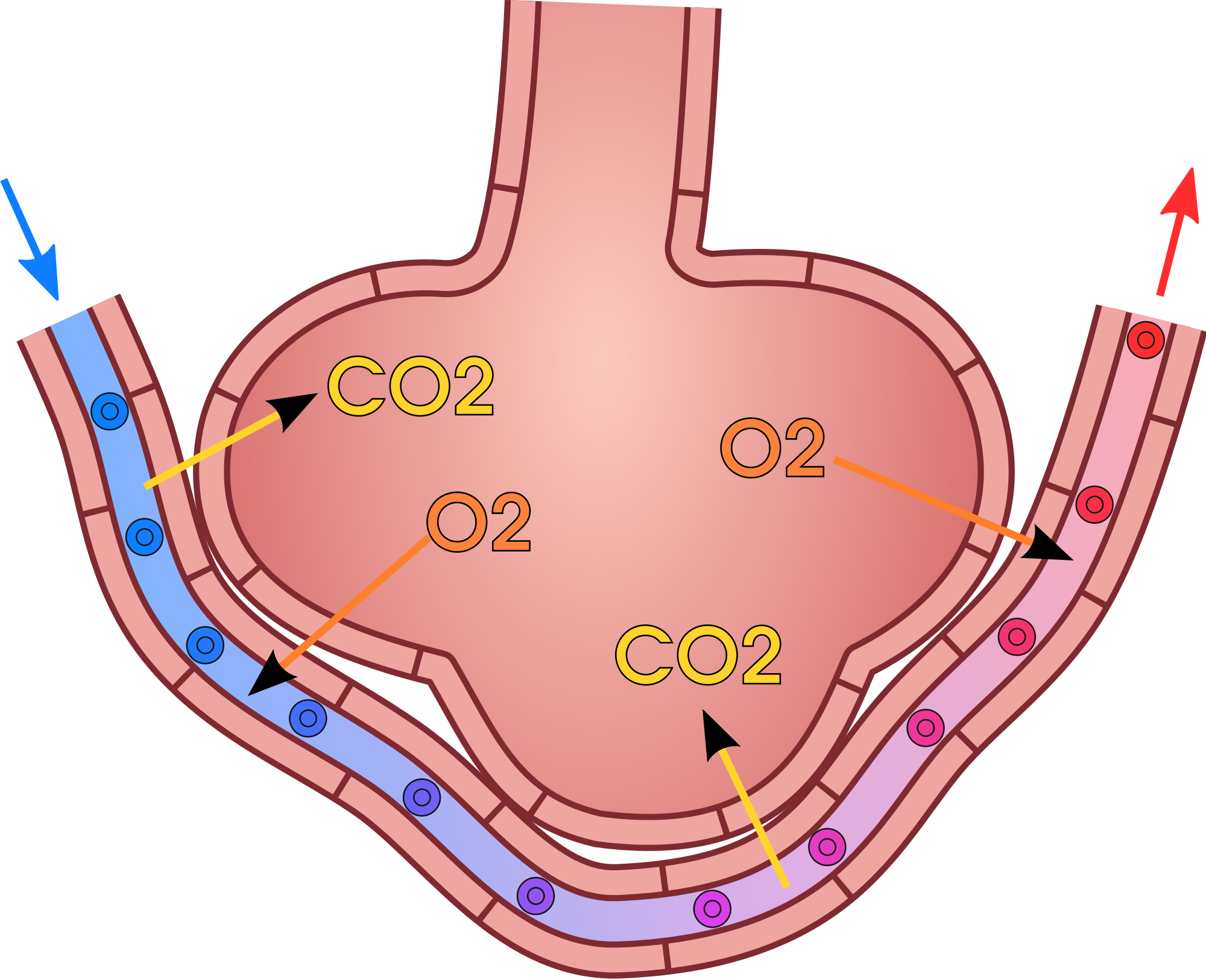
Gas exchange by diffusion depends on having a large surface area through which gases can pass. Although each alveolus is tiny, there are hundreds of millions of them in the lungs of a healthy adult, so the total surface area for gas exchange is huge. It is estimated that this surface area may be as great as 100 m2 (or approximately 1,076 ft²). Often we think of lungs as balloons, but this type of structure would have very limited surface area and there wouldn't be enough space for blood to interface with the air in the alveoli. The structure alveoli take in the lungs is more like a giant mass of soap bubbles — millions of tiny little chambers making up one large mass — this is what increases surface area giving blood lots of space to come into close enough contact to exchange gases by diffusion.
Gas exchange by diffusion also depends on maintaining a steep concentration gradient for oxygen and carbon dioxide. Continuous blood flow in the capillaries and constant breathing maintain this gradient.
- Each time you inhale, there is a greater concentration of oxygen in the air in the alveoli than there is in the blood in the pulmonary capillaries. As a result, oxygen diffuses from the air inside the alveoli into the blood in the capillaries. Carbon dioxide, in contrast, is more concentrated in the blood in the pulmonary capillaries than it is in the air inside the alveoli. As a result, carbon dioxide diffuses in the opposite direction.
- The cells of the body have a much lower concentration of oxygen than does the oxygenated blood that reaches them in peripheral capillaries, which are the capillaries that supply tissues throughout the body. As a result, oxygen diffuses from the peripheral capillaries into body cells. The opposite is true of carbon dioxide. It has a much higher concentration in body cells than it does in the blood of the peripheral capillaries. Thus, carbon dioxide diffuses from body cells into the peripheral capillaries.
13.4 Summary
- Gas exchange is the biological process through which gases are transferred across cell membranes to either enter or leave the blood. Gas exchange takes place continuously between the blood and cells throughout the body, and also between the blood and the air inside the lungs.
- Gas exchange in the lungs takes place in alveoli, which are tiny air sacs surrounded by networks of capillaries. The pulmonary artery carries deoxygenated blood from the heart to the lungs, where it travels through pulmonary capillaries, picking up oxygen and releasing carbon dioxide. The oxygenated blood then leaves the lungs through pulmonary veins.
- Gas exchange occurs by diffusion across cell membranes. Gas molecules naturally move down a concentration gradient from an area of higher concentration to an area of lower concentration. This is a passive process that requires no energy.
- Gas exchange by diffusion depends on the large surface area provided by the hundreds of millions of alveoli in the lungs. It also depends on a steep concentration gradient for oxygen and carbon dioxide. This gradient is maintained by continuous blood flow and constant breathing.
13.4 Review Questions
- What is gas exchange?
- Summarize the flow of blood into and out of the lungs for gas exchange.
-
- Describe the mechanism by which gas exchange takes place.
- Identify the two main factors upon which gas exchange by diffusion depends.
- If the concentration of oxygen were higher inside of a cell than outside of it, which way would the oxygen flow? Explain your answer.
- Why is it important that the walls of the alveoli are only one cell thick?
13.4 Explore More
https://www.youtube.com/watch?v=nRpwdwm06Ic&feature=emb_logo
Oxygen movement from alveoli to capillaries | NCLEX-RN | Khan Academy, khanacademymedicine, 2013.
https://www.youtube.com/watch?v=KmgIqVwytwA&feature=emb_logo
About Carbon Monoxide and Carbon Monoxide Poisoning, EMDPrepare, 2009.
https://www.youtube.com/watch?v=GVU_zANtroE
Oxygen’s surprisingly complex journey through your body - Enda Butler, TED-Ed, 2017.
Attributions
Figure 13.4.1
Oxygen Bar by Farrukh on Flickr is used under a CC BY-NC 2.0 (https://creativecommons.org/licenses/by-nc/2.0/) license.
Figure 13.4.2
Alveolus_diagram.svg by Mariana Ruiz Villarreal [LadyofHats] on Wikimedia Commons is released into the public domain (https://en.wikipedia.org/wiki/Public_domain).
Figure 13.4.3
Gas_exchange_in_the_aveolus.svg by domdomegg on Wikimedia Commons is used under a CC BY 4.0 (https://creativecommons.org/licenses/by/4.0) license.
References
EMDPrepare. (2009, December 21). About carbon monoxide and carbon monoxide poisoning. YouTube. https://www.youtube.com/watch?v=KmgIqVwytwA&feature=youtu.be
khanacademymedicine. (2013, February 25). Oxygen movement from alveoli to capillaries | NCLEX-RN | Khan Academy. YouTube. https://www.youtube.com/watch?v=nRpwdwm06Ic&feature=youtu.be
TED-Ed. (2017, April 13). Oxygen’s surprisingly complex journey through your body - Enda Butler. YouTube. https://www.youtube.com/watch?v=GVU_zANtroE&feature=youtu.be
A hollow, tube-like structure through which blood flows in the cardiovascular system; vein, artery, or capillary.
Created by CK-12/Adapted by Christine Miller
So Many Species!
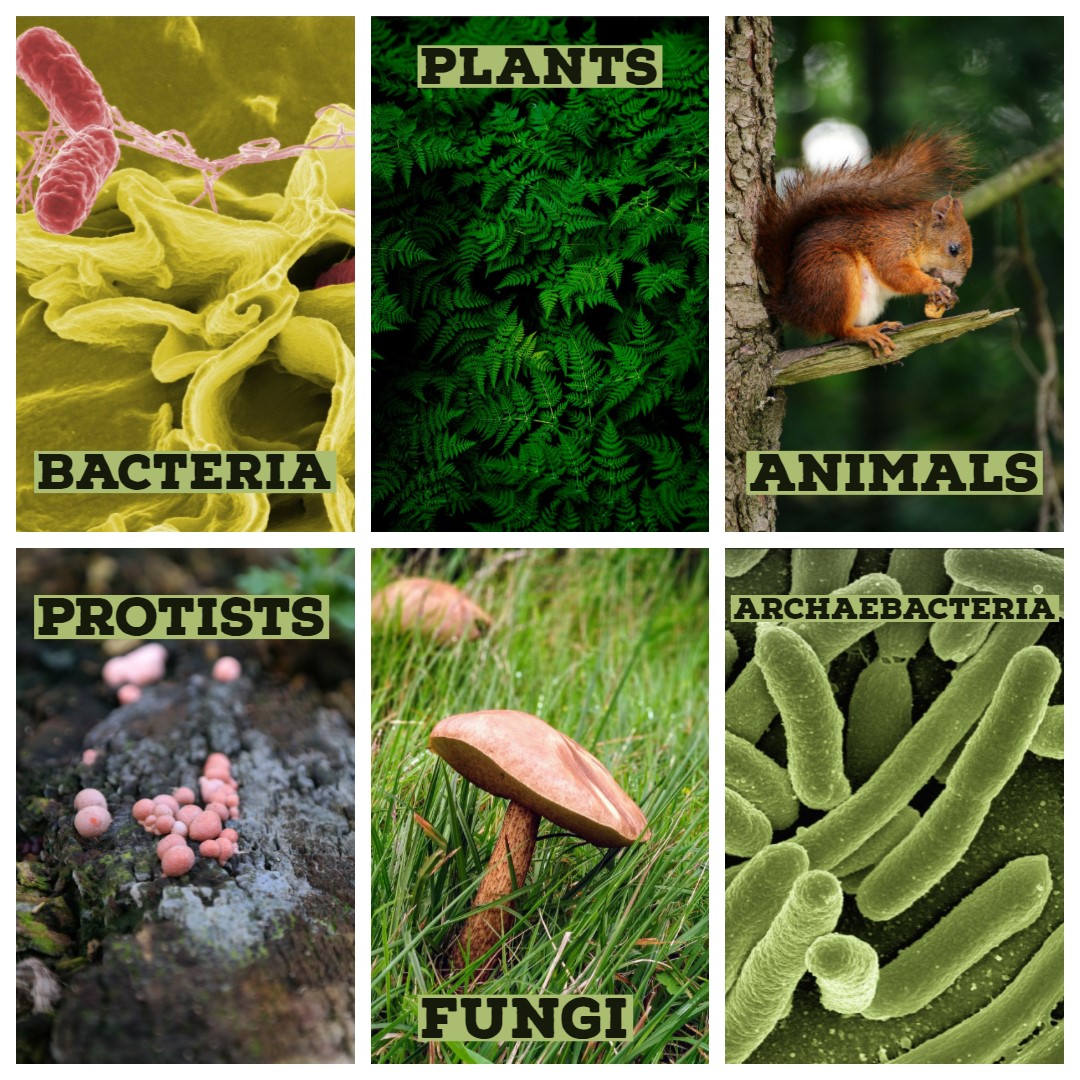
The collage shows a single species in each of the six kingdoms into which all of Earth's living things are commonly classified. How many species are there in each kingdom? In a word: millions. A total of almost two million living species have already been identified, and new species are being discovered all the time. Scientists estimate that there may be as many as 30 million unique species alive on Earth today! Clearly, there is a tremendous variety of life on Earth.
What Is Biodiversity?
Biological diversity, or biodiversity, refers to all of the variety of life that exists on Earth. Biodiversity can be described and measured at three different levels: species diversity, genetic diversity, and ecosystem diversity.
- Species diversity refers to the number of different species in an ecosystem or on Earth as a whole. This is the most common way to measure biodiversity. Current estimates for Earth's total number of living species range from 5 to 30 million species.
- Genetic diversity refers to the variation in genes within all of these species.
- Ecosystem diversity refers to the variety of ecosystems on Earth. An ecosystem is a system formed by populations of many different species interacting with each other and their environment.
https://www.youtube.com/watch?v=GK_vRtHJZu4
Why is Biodiversity So Important? - Kim Preshoff, TEDEd, 2015
Defining a Species
Biodiversity is most often measured by counting species, but what is a species? The answer to that question is not as straightforward as you might think. Formally, a species is defined as a group of actually or potentially interbreeding organisms. This means that members of the same species are similar enough to each other to produce fertile offspring together. By this definition of species, all human beings alive today belong to one species, Homo sapiens. All humans can potentially interbreed with each other, but not with members of any other species.
In the real world, it isn't always possible to make the observations necessary to determine whether or not different organisms can interbreed. For one thing, many species reproduce asexually, so individuals never interbreed — even with members of their own species. When studying extinct species represented by fossils, it is usually impossible to know if different organisms could interbreed. Keep in mind that 99 per cent of all species that have ever existed are now extinct! In practice, many biologists and virtually all paleontologists generally define species on the basis of morphology, rather than breeding behavior. Morphology refers to the form and structure of organisms. For classification purposes, it generally refers to relatively obvious physical traits. Typically, the more similar to one another different organisms appear, the greater the chance that they will be classified in the same species.
Classifying Living Things
People have been trying to classify the tremendous diversity of life on Earth for more than two thousand years. The science of classifying organisms is called taxonomy. Classification is an important step in understanding the present diversity and past evolutionary history of life on Earth. It helps us make sense of the overwhelming diversity of living things.
Linnaean Classification
All modern classification systems have their roots in the Linnaean classification system, which was developed by Swedish botanist Carolus Linnaeus in the 1700s. He tried to classify all living things known in his time by grouping together organisms that s
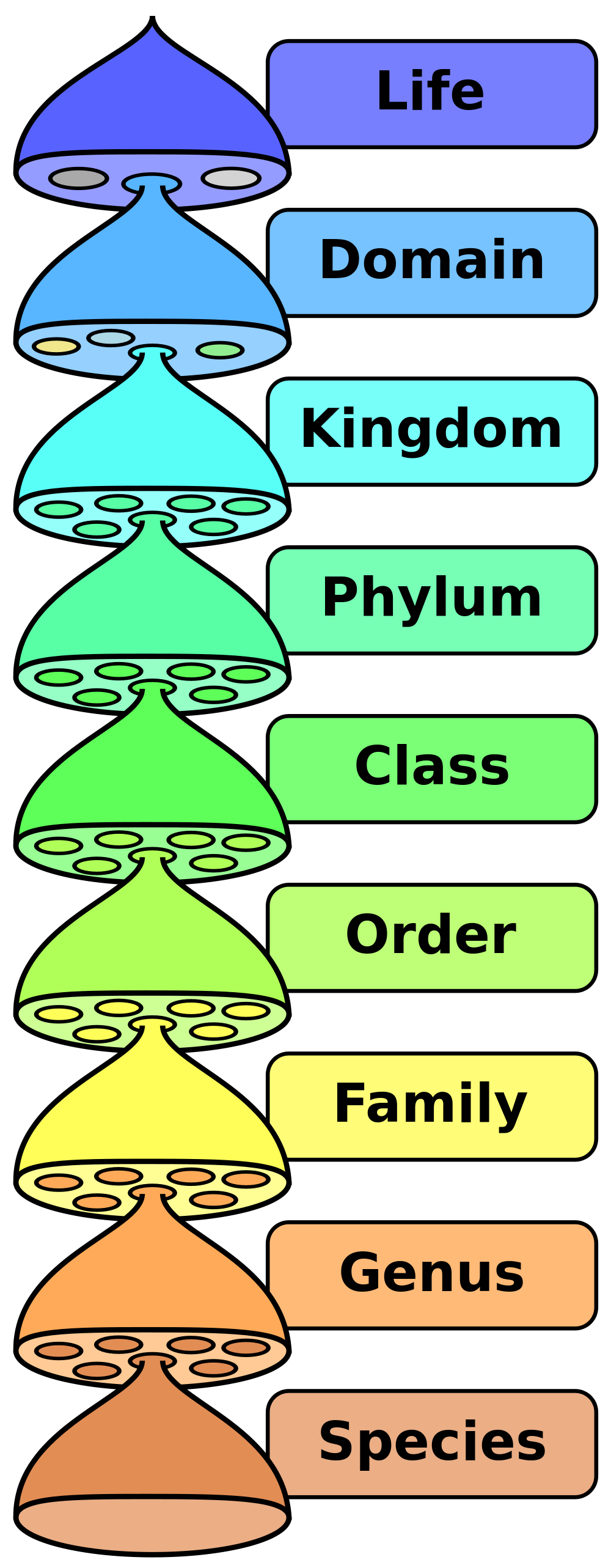
hared obvious morphological traits, such as number of legs or shape of leaves. For his contribution, Linnaeus is known as the “father of taxonomy.”
The Linnaean system of classification consists of a hierarchy of groupings, called taxa (singular, taxon). In the original system, taxa ranged from the kingdom to the species. The kingdom (ex. plant kingdom, animal kingdom) is the largest and most inclusive grouping. It consists of organisms that share just a few basic similarities. The species is the smallest and most exclusive grouping. Ideally, it consists of organisms that are similar enough to interbreed, as discussed above. Similar species are classified together in the same genus (plural, genera), then similar genera are classified together in the same family, and so on, all the way up to the kingdom.
A phrase to help you remember the order of the groupings is shown below. The first letter of each word is the first letter of the level of classification.
Dad Keeps Pots Clean Or Family Gets Sick
The hierarchy of taxa in the original Linnaean system of taxonomy included taxa from the species to the kingdom. The domain was added later.
Binomial Nomenclature
Perhaps the single greatest contribution Linnaeus made to science was his method of naming species. This method, called binomial nomenclature, gives each species a unique, two-word Latin name consisting of the genus name followed by a specific species identifier. An example is Homo sapiens, the two-word Latin name for humans. It literally means “wise human.” This is a reference to our big brains.
Why is having two names so important? It is similar to people having a first and a last name. You may know several people with the first name Michael, but adding Michael’s last name usually pins down exactly which Michael you mean. In the same way, having two names for a species helps to uniquely identify it.
Revisions in the Linnaean Classification
Linnaeus published his classification system in the 1700s. Since then, many new species have been discovered. Scientists can also now classify organisms on the basis of their biochemical and genetic similarities and differences, and not just their outward morphology. These changes have led to revisions in the original Linnaean system of classification.
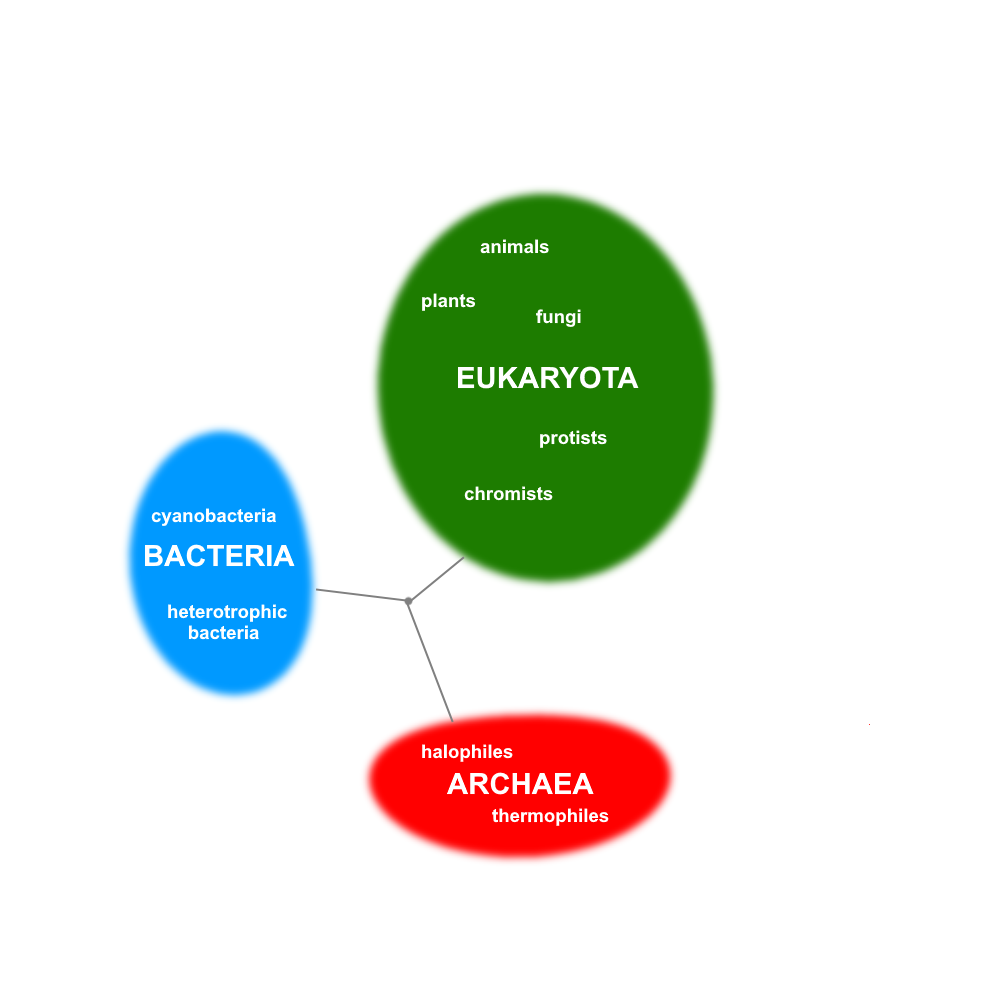
A major change to the Linnaean system is the addition of a new taxon called the domain. The domain is a taxon that is larger and more inclusive than the kingdom, as shown in the figure above. Most biologists agree that there are three domains of life on Earth: Bacteria, Archaea, and Eukarya . Both the Bacteria and the Archaea domains consist of single-celled organisms that lack a nucleus. This means that their genetic material is not enclosed within a membrane inside the cell. The Eukarya domain, in contrast, consists of all organisms whose cells do have a nucleus, so that their genetic material is enclosed within a membrane inside the cell. The Eukarya domain is made up of both single-celled and multicellular organisms. This domain includes several kingdoms, including the animal, plant, fungus, and protist kingdoms.
The three domains of life, as well as how they are related to each other and to a common ancestor. There are several theories about how the three domains are related and which arose first, or from another.
Phylogenetic Classification
Linnaeus classified organisms based on morphology. Basically, organisms were grouped together if they looked alike. After Darwin published his theory of evolution in the 1800s, scientists looked for a way to classify organisms that accounted for phylogeny. Phylogeny is the evolutionary history of a group of related organisms. It is represented by a phylogenetic tree, or some other tree-like diagram, like the one shown above to illustrate the three domains. A phylogenetic tree shows how closely related different groups of organisms are to one another. Each branching point represents a common ancestor of the branching groups.
2.4 Summary
- Biodiversity refers to the variety of life that exists on Earth. It includes species diversity, genetic diversity (within species), and ecosystem diversity.
- The formal biological definition of species is a group of actually or potentially interbreeding organisms. Our own species, Homo sapiens,is an example. In reality, organisms are often classified into species on the basis of morphology.
- A system for classifying living things was introduced by Linnaeus in the 1700s. It includes taxa from the species (least inclusive) to the kingdom (most inclusive). Linnaeus also introduced a system of naming species, which is called binomial nomenclature.
- The domain — a taxon higher than the kingdom — was later added to the Linnaean system. Living things are generally grouped into three domains: Bacteria, Archaea, and Eukarya. The human species and other animal species are placed in the Eukarya domain.
- Modern systems of classification take into account phylogenies, or evolutionary histories of related organisms, rather than just morphological similarities and differences. These relationships are often represented by phylogenetic trees or other tree-like diagrams
2.4 Review Questions
- What is biodiversity? Identify three ways that biodiversity may be measured.
- Define biological species. Why is this definition often difficult to apply?
- Explain why it is important to classify living things, and outline the Linnaean system of classification.
- What is binomial nomenclature? Give an example.
-
- Contrast the Linnaean and phylogenetic systems of classification.
- Describe the taxon called the domain, and compare the three widely recognized domains of living things.
- Based on the phylogenetic tree for the three domains of life above, explain whether you think Bacteria are more closely related to Archaea or Eukarya.
- A scientist discovers a new single-celled organism. Answer the following questions about this discovery.
- If this is all you know, can you place the organism into a particular domain? If so, what is the domain? If not, why not?
- What is one type of information that could help the scientist classify the organism?
- Define morphology. Give an example of a morphological trait in humans.
- Which type of biodiversity is represented in the differences between humans?
- Why do you think it is important to the definition of a species that members of a species can produce fertile offspring?
- Go to the A-Z Animals Animal Classification Page. In the search box, put in your favorite animal and write out it's classification.
2.4 Explore More
https://youtu.be/DVouQRAKxYo
Classification, Amoeba Sisters, 2013.
Attributions
Figure 2.4.1 (6 Kingdoms collage)
- Salmonella, by unknown/ NIAID on Wikimedia Commons is in the public domain (https://en.wikipedia.org/wiki/Public_domain).
- Fern from pxhere, is used under a CC0 1.0 universal public domain dedication license (https://creativecommons.org/publicdomain/zero/1.0/deed.en).
- Photo [squirrel] , by Radoslaw Prekurat on Unsplash is used under the Unsplash License (https://unsplash.com/license).
- Blood Milk Mushroom by Hans on Pixabay is used under the Pixabay License (https://pixabay.com/de/service/license/).
- Fungi by Ste Wright on Unsplash is used under the Unsplash License (https://unsplash.com/license).
- EscherichiaColi NIAID [adapted], by Rocky Mountain Laboratories, ca:NIAID, ca:NIH on Wikimedia Commons is in the public domain (https://en.wikipedia.org/wiki/Public_domain).
Figure 2.4.2
Biological classification, by Pengo [Peter Halasz] on Wikimedia Commons is in the public domain (https://en.wikipedia.org/wiki/Public_domain).
Figure 2.4.3
The three domains of life and major groups within, by C. Miller, 2019, is in the public domain (https://en.wikipedia.org/wiki/Public_domain).
References
Amoeba Sisters. (2017, March 8). Classification. YouTube. https://www.youtube.com/watch?v=DVouQRAKxYo&feature=youtu.be
A-Z Animals. (2008, December 1). Animal classification. https://a-z-animals.com/reference/animal-classification/
TED-Ed. (2015, April 20). Why is biodiversity so important? - Kim Preshoff. YouTube. https://www.youtube.com/watch?v=GK_vRtHJZu4
Wikipedia contributors. (2020, June 21). Carl Linnaeus. Wikipedia. https://en.wikipedia.org/w/index.php?title=Carl_Linnaeus&oldid=963767022
Created by CK-12/Adapted by Christine Miller
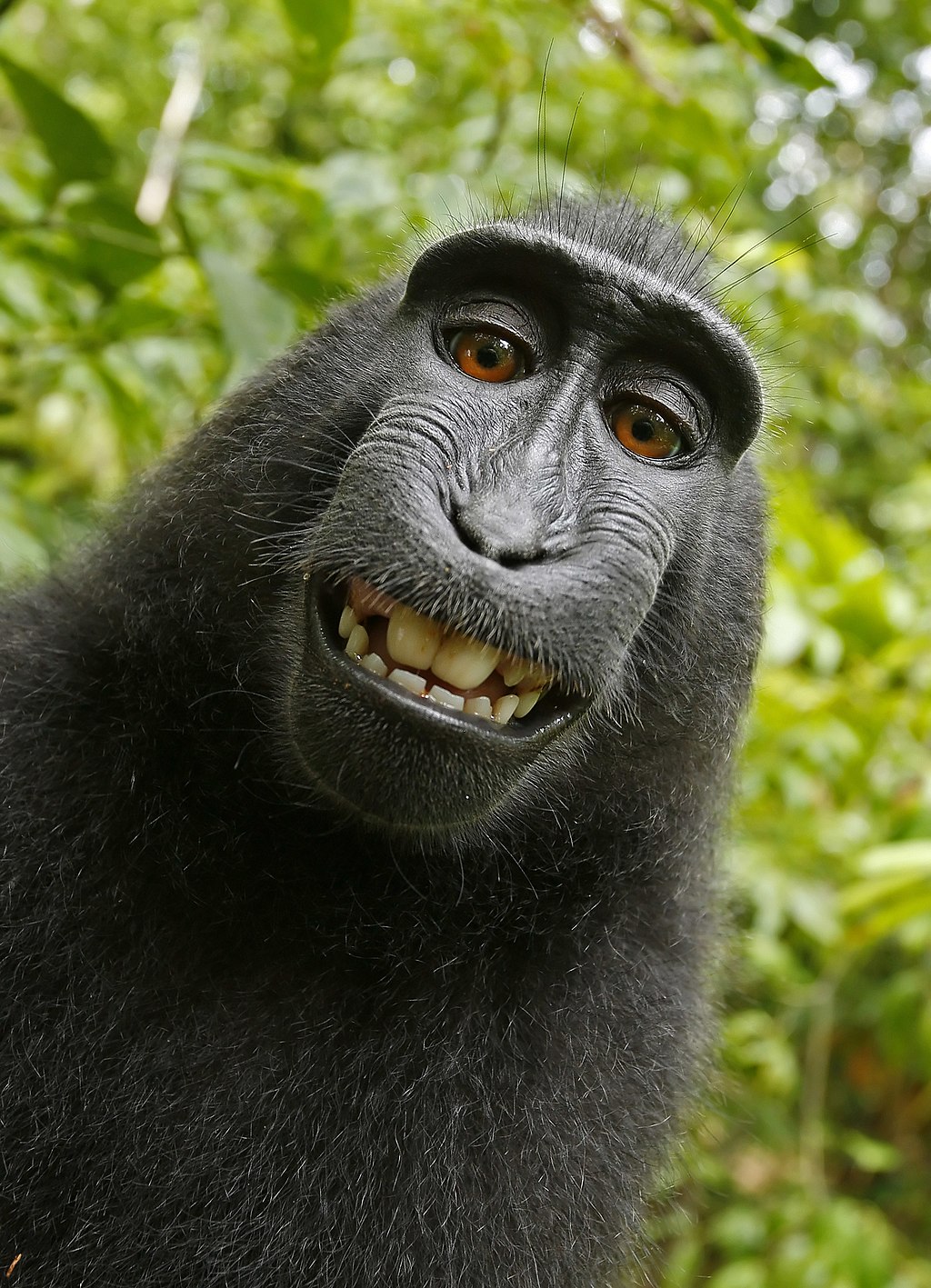
Primate Pals
Figure 2.5.1 Humans and monkeys share an evolutionary past. Humans belong to the animal kingdom, which includes small organisms — like insects — and larger organisms, like humans and monkeys. From genes to morphology to behavior, humans and monkeys are similar in many ways because they share an evolutionary past. Humans and monkeys also both belong to the order Primate, which means they have more traits in common with each other than with insects.
How Humans Are Classified

You probably know that modern humans are members of the species Homo sapiens. But what is our place in nature? How is our species classified? A simple classification is represented in the taxonomic diagram below, along with some representative characteristics.
Let's start at the bottom of the chart, with the kingdom. Among other animal characteristics, humans can move on their own, so they are placed in the animal kingdom. Further, humans belong to the animal phylum known as chordates, because we have a backbone. The human animal has hair and milk glands, so we are placed in the class of mammals. Within the mammal class, humans are placed in the primate order.
Humans as Primates
Living members of the primate order include monkeys, apes, and humans. At some point in the distant past, we shared ape-like ancestors with all of these modern groups of primates. We share between 93 and 99 per cent of our DNA sequences with them, which provides hard evidence that we have relatively recent common ancestors. Besides genes, what traits do we share with other primates?
Primates are considered generalists among the mammals. A generalist is an organism that can thrive in a wide variety of environmental conditions. Generalists also make use of a variety of different resources; for example, they consume many types of food. Although primates exhibit a wide range of characteristics, there are several traits shared by most primates.
Primate Traits
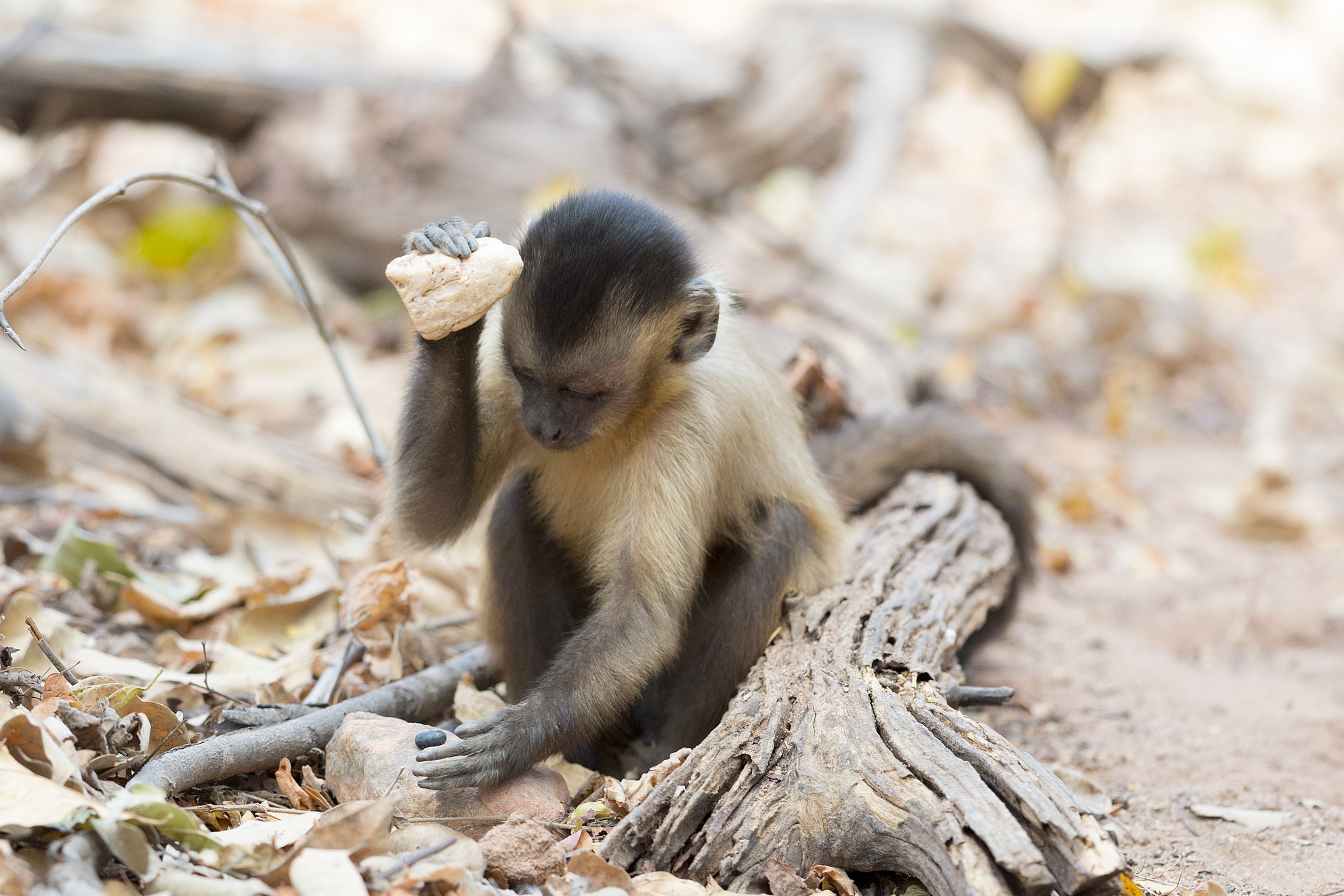
Primates have pentadactylism, or five digits (fingers or toes) on each extremity (hand or foot). The fingers and toes have nails instead of claws and are covered with sensitive tactile pads. The thumbs (and in many species, the big toes, as well) are opposable, which means they can be brought into opposition with the other digits, allowing both a power grasp and a precision grip. You can see these features of the primate extremities in the capuchin monkey pictured in Figure 2.15.
The five fingers, opposable thumb, and other primate features of the hand give this capuchin monkey great manual dexterity. This is the primary reason these primates are trained to assist quadraplegic human beings with daily tasks.
The primate body is generally semi-erect or erect, and primates have one of several modes of locomotion, including walking on all four legs (quadrupedalism), vertical clinging and leaping, swinging from branch to branch in trees (brachiation), or walking on two legs (bipedalism, which today only applies to humans). The primate shoulder girdle has a collar bone (clavicle), which is associated with a wide range of motion of the upper limbs.
Relative to other mammals, primates rely less on their sense of smell. They have a reduced snout and relatively small area in the brain for processing olfactory (odor) information. Primates rely more on their sense of vision, which shows several improvements over that of other mammals. Most primates can see in colour. Primates also tend to have large eyes with forward placement in a relatively flat face. This results in an overlap of the visual fields of the two eyes, allowing stereoscopic (or three-dimensional) vision. Other indications of the importance of vision to primates is the protection given the eyes by a complete bony eye socket and the large size of the occipital lobe of the brain, where visual information is processed.
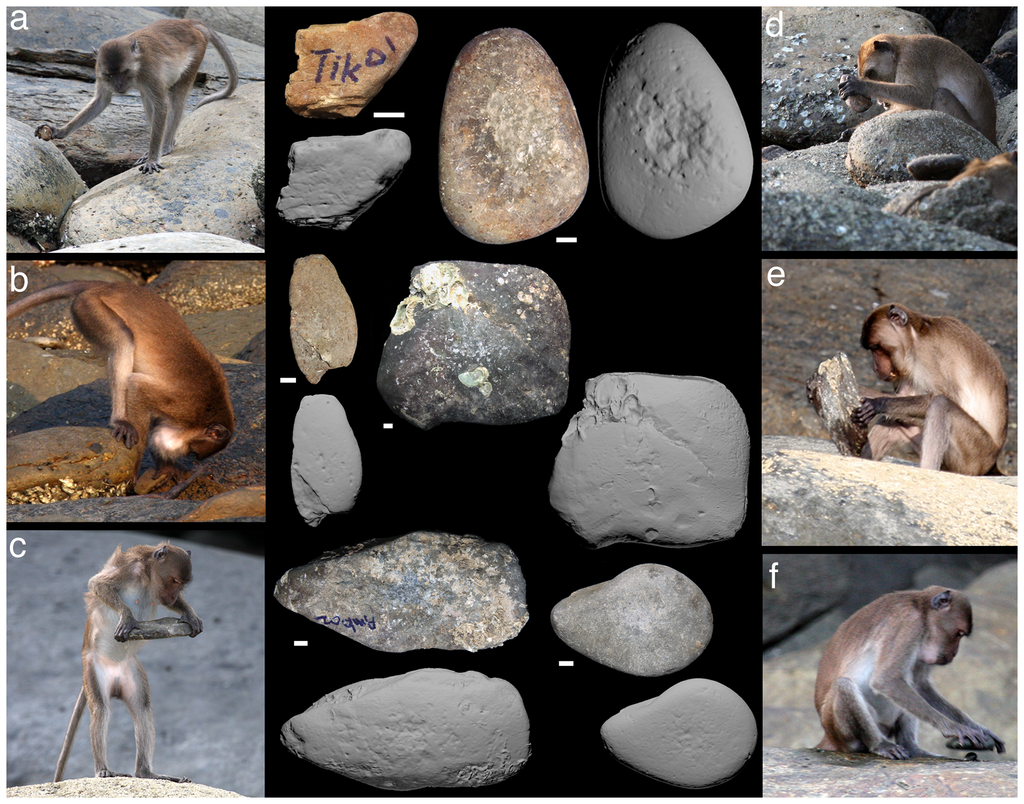
Primates are noted for their relatively large brains, high degree of intelligence, and complex behaviors. The part of the brain that is especially enlarged in primates is the cerebrum, which analyzes and synthesizes sensory information and transforms it to motor behaviors appropriate to the environment. Primates tend to have longer lifespans than most other mammals. In particular, there is a lengthening of the prenatal period and the postnatal period during which infants depend on adults, providing an extended opportunity for learning among juveniles. Most primates live in social groups. In fact, primates are among the most social of animals. Depending on the species, adult nonhuman primates may live in mated pairs or in groups with hundreds of members. Humans and some nonhuman primates can also make and use tools. The crab-eating macaques pictured below provide examples of tool use in nonhuman primates.
Life in the Trees
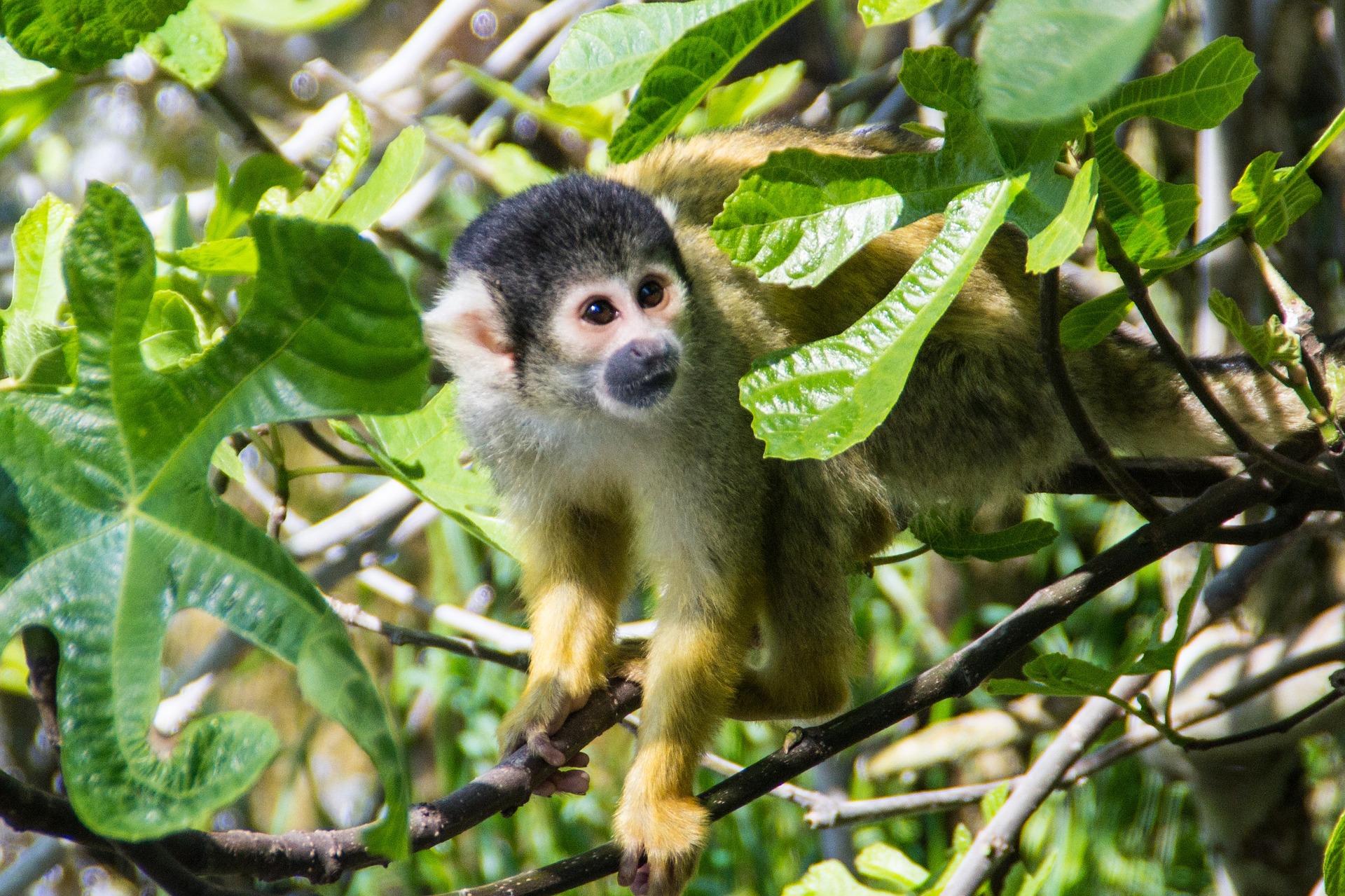
Scientists think that many primate traits are adaptations to an arboreal (or tree-dwelling) lifestyle. Primates are thought to have evolved in trees, and the majority of primates still live in trees. For life in the trees, the sense of vision trumps the sense of smell, and three-dimensional (3D) vision is especially important for grasping the next branch or limb. Having mobile limbs, a good grip, and manual dexterity are matters of life and death when one lives high above the ground. While some modern primates are mainly terrestrial (ground dwelling) rather than arboreal, all primates possess adaptations for life in the trees.
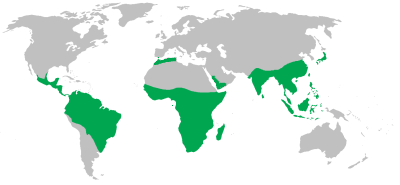
The map to the left shows the present distribution of nonhuman primates around the world. Tropical forests in Central and South America are home to many species of monkeys, including the squirrel monkey pictured above. Old World tropical forests in Africa and Asia are home to many other species of monkeys, including the crab-eating macaque pictured above, as well as all modern apes.
Humans as Hominids
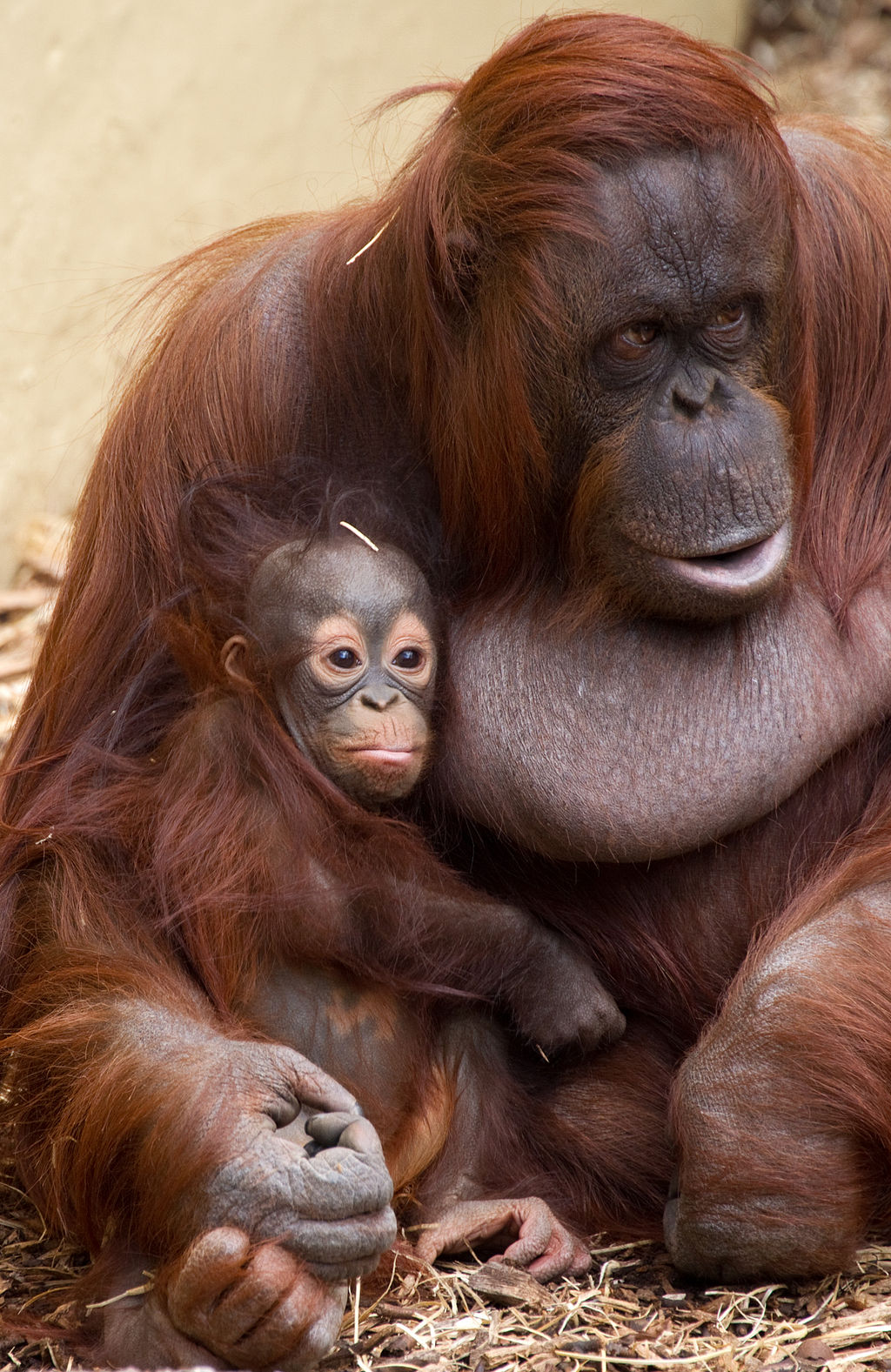
Who are our closest relatives in the primate order? We are placed in the family called Hominidae. Any member of this family is called a hominid. Hominids include four living genera: chimpanzees, gorillas, orangutans, and humans. Among these four genera are just seven living species: two in each genera, except humans, with our sole living species, Homo sapiens. The orangutan mother pictured cradling her child shows how similar these hominids are to us.
Hominids are relatively large, tailless primates, ranging in size from the bonobo (or pygmy chimpanzee) — which may weigh as little as 30 kg (66 lb) — to the eastern gorilla, which may weigh over 200 kg (440 lb). Most modern humans fall somewhere within that range. In all species of hominids, males are somewhat larger and stronger, on average, than females, but the differences may not be significant. Except for humans, hominids are mainly quadrupedal, although they can get around bipedally if need be to gather food or nesting materials. Humans are the only habitually bipedal species of living hominids.
The Human Genus
Within the hominid family, our species is placed in the genus Homo. Our species, Homo sapiens, is the only living species in this genus. Several earlier species of Homo existed, but have since gone extinct, including the species Homo erectus.
By about 2.8 million years ago, early Homo species such as Homo erectus were probably nearly as efficient at bipedal locomotion as modern humans. Relative to quadrupedal primates, they had a broader pelvis, longer legs, and arched feet. However, from the neck up, they were still quite different from us. They typically had bigger jaws and teeth, a sloping forehead, and a relatively small brain.
Homo sapiens
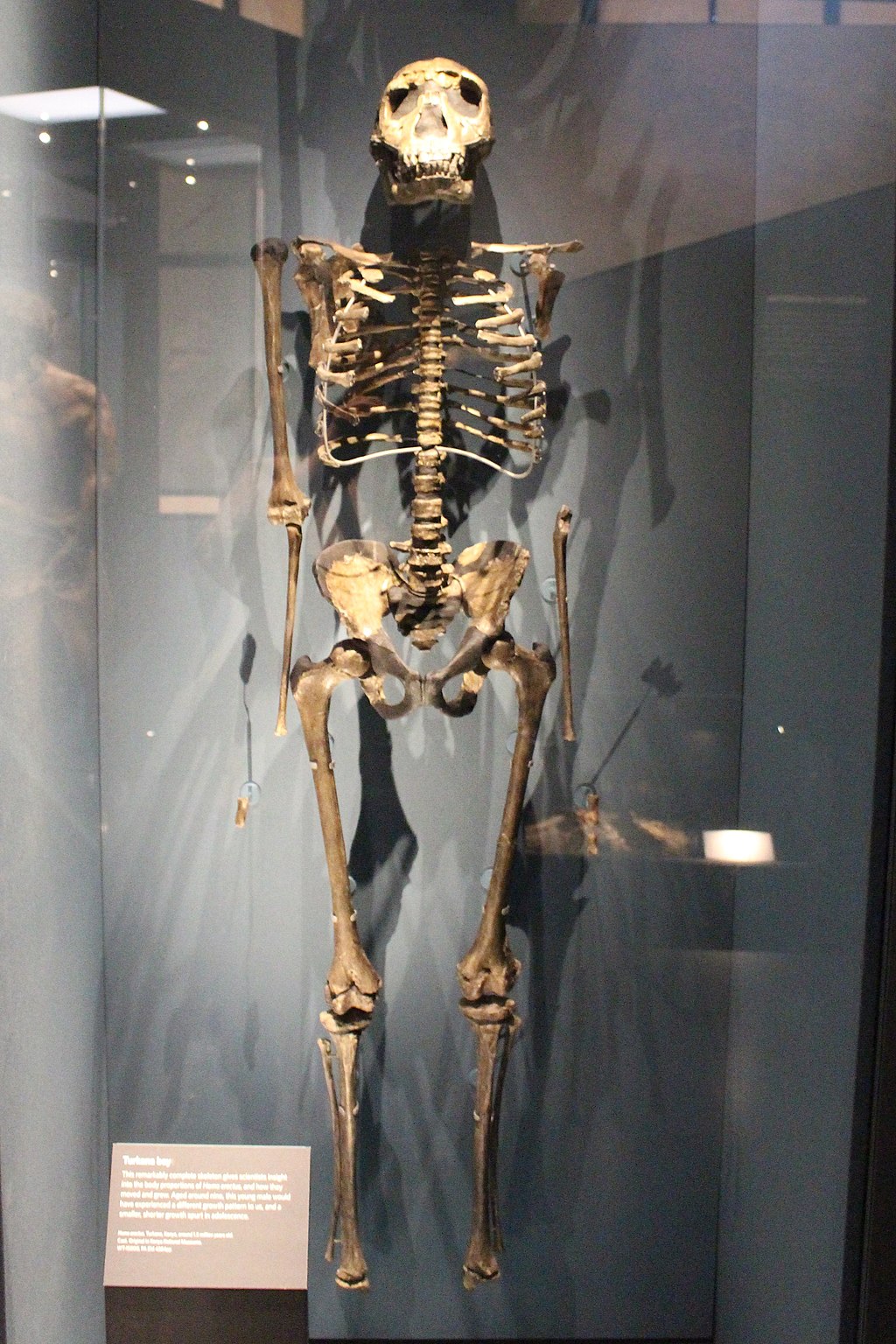
During the roughly 2.8 million years of the evolution of the Homo genus, the remaining features of Homo sapiens evolved. These features include:
- Small front teeth (incisors and canines) with relatively large molars, at least compared to other primates.
- A decrease in the size of the jaws and face and an increase in the size of the cranium, forming a nearly vertical forehead.
- A tremendous enlargement of the brain, especially in the cerebrum, which is the site of higher intellectual functions.
The increase in brain size occurred very rapidly as far as evolutionary change goes, between about 800 thousand and 100 thousand years ago. During this period, the size of the brain increased from about 600 cm3 to about 1400 cm3 when the earliest Homo sapiens appeared. This was also a period of rapid climate change, and many scientists think that climate change was a major impetus for the evolution of a larger, more complex brain. In this view, as the environment became more unpredictable, bigger and "smarter" brains helped our ancestors survive. Running parallel to the biological evolution of the brain was the development of culture and technology, which were adapted for the purpose of exploiting the environment. These developments, made possible by a big brain, allowed modern humans and their recent ancestors to occupy virtually the entire world and become the dominant land animals.
Our species Homo sapiens is the most recent iteration of the basic primate body plan. Because of our big, complex brain, we clearly have a much greater capacity for abstract thought and technological advances than any other primate — even chimpanzees, who are our closest living relatives. However, it is important to recognize that in other ways, we are not as adept as other living hominids around the world. We are physically weaker than gorillas, far less agile than orangutans, and arguably less well-mannered than bonobos.
Feature: Human Biology in the News
Imagine squeezing through a 7-inch slit in rock to enter a completely dark cave full of lots and lots of old bones. It might sound like a nightmare to most people, but it was a necessary part of a recent exploration of human origins in South Africa as reported in the New York Times in September 2015. The cave and its bones were actually first discovered by spelunkers in 2013, who reported it to paleontologists. An international research project was soon launched to explore the cave. The researchers would eventually conclude that the cave was a hiding place for the dead of a previously unknown early species of Homo, whom they called Homo naledi. Members of this species lived in South Africa around 2.5 to 2.8 million years ago.
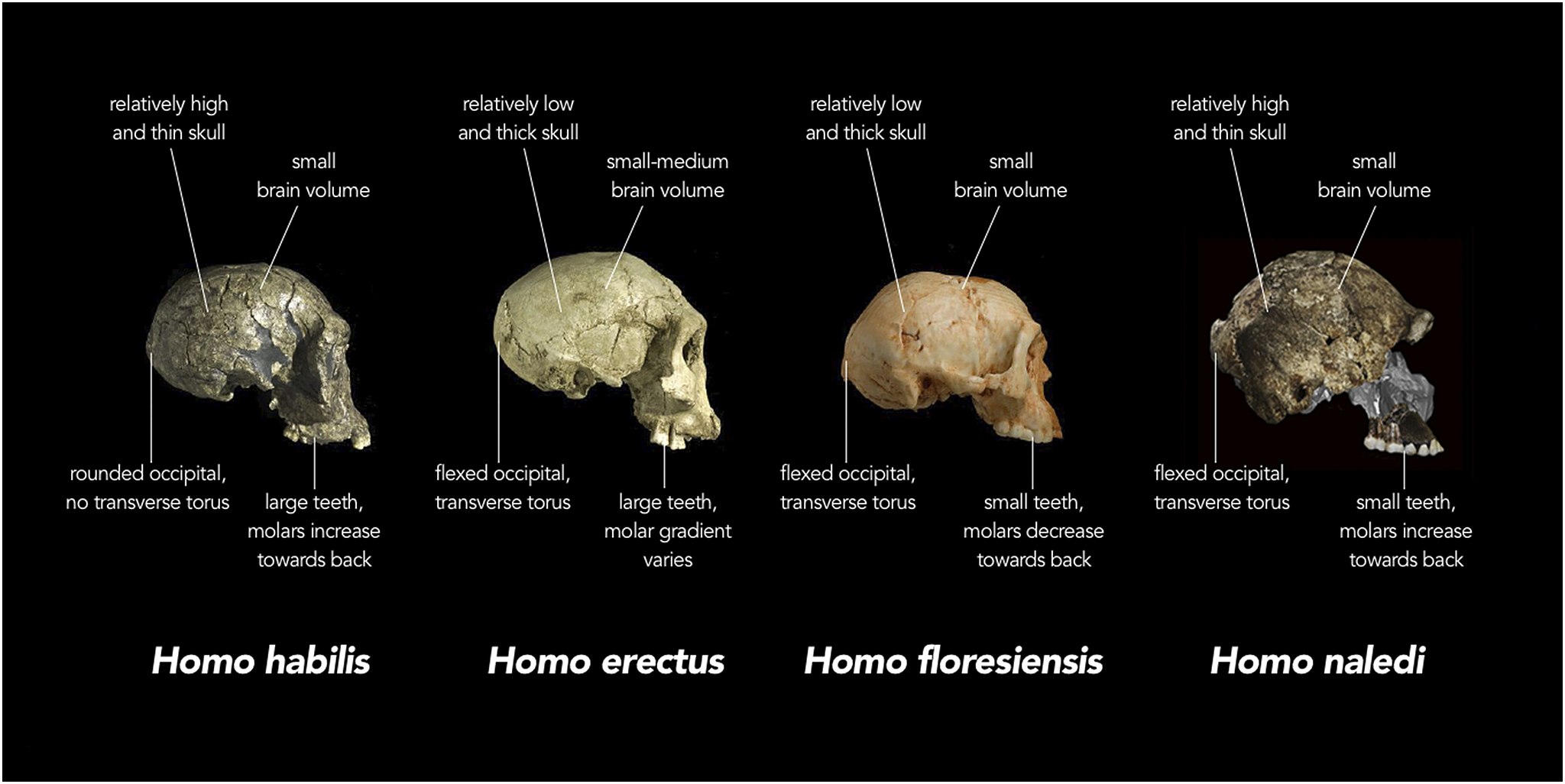
Homo naledi individuals were about 5 feet (about 1.5 metres) tall and weighed around 100 pounds (about 45 kilograms), so they probably had no trouble squeezing into the cave. Modern humans are considerably larger on average. In order to retrieve the fossilized bones from the cave, six slender researchers had to be found on social media. They were the only ones who could fit through the crack to access the cave. The work was difficult and dangerous, but also incredibly exciting. The site constitutes one of the largest samples of any extinct early Homo species anywhere in the world, and the fossils represent a completely new species of that genus. The site also suggests that early members of our genus were intentionally depositing their dead in a remote place. This behavior was previously thought to be limited to later humans.
Like other early Homo species, Homo naledi exhibits a mosaic of old and modern traits. From the neck down, these early hominins were well-adapted for upright walking. Their feet were virtually indistinguishable from modern human feet and their legs were also long like ours. Homo naledi had relatively small front teeth, but also a small brain, no larger than an average orange. Clearly, the spurt in brain growth in Homo did not occur in this species. The image to the left shows the different morphology of early human skulls.
Watch the news for more exciting updates about this early species of our genus. Paleontologists researching the cave site estimate that there are hundreds — if not thousands — of fossilized bones still remaining in the cave. There are sure to be many more discoveries reported in the news media about this extinct Homo species.
2.5 Summary
- The human species, Homo sapiens, is placed in the primate order of the class of mammals, which are chordates in the animal kingdom.
- Humans share many traits with other primates. They have five digits with nails and opposable thumbs; an excellent sense of vision, including the ability to see in colour and stereoscopic vision; a large brain, high degree of intelligence, and complex behaviors. Like most other primates, we also live in social groups. Many of our primate traits are adaptations to life in the trees.
- Within the primate order, our species is placed in the hominid family, which also includes chimpanzees, gorillas, and orangutans. All hominids are relatively large, tailless primates, in which males are generally bigger than females.
- The genus Homo first evolved about 2.8 million years ago. Early Homo species were fully bipedal, but had small brains. All are now extinct.
- During the last 800 thousand years, Homo sapiens evolved, with smaller faces, jaws, and front teeth, but much bigger brains than earlier Homo species.
2.5 Review Questions
- Outline how humans are classified. Name their taxa, starting with the kingdom and ending with the species.
- List several primate traits. Explain how they are related to a life in the trees.
-
- What are hominids? Describe how living hominids are classified.
- Discuss species in the genus Homo.
- Relate climatic changes to the evolution of the genus Homo over the last million years.
- Why is it significant that we share 93% to 99% of our DNA sequence with other primates?
- Which species do you think we are more likely to share a greater amount of DNA sequence with — non-primate mammals (i.e. horses) or non-mammalian chordates (i.e. frogs)? Explain your answer.
- What is the relationship between shared DNA and shared traits?
- Compared to other mammals, primates have a relatively small area of their brain dedicated to olfactory processing. What does this tell you about the sense of smell in primates compared to other mammals? Why?
- Why do you think it is interesting that nonhuman primates can use tools?
- Explain why the discovery of Homo naledi was exciting.
2.5 Explore More
https://www.youtube.com/watch?v=vRzp9O9Qc1o&feature=emb_logo
Helping Hands: Matching Capuchins with Those in Need, from BUToday, 2009.
https://www.youtube.com/watch?v=oxgnlSbYLSc&feature=emb_logo
New human ancestor discovered: homo naledi (EXCLUSIVE VIDEO)
by National Geographic, 2015.
Attributions
Figure 2.5.1
Macaca nigra self-portrait on Wikimedia Commons is in the public domain (https://en.wikipedia.org/wiki/Public_domain). (As the work was created from a non-human animal, it has no human author in whom copyright is vested - See the Wtop.com news article.)
Figure 2.5.2
Classification of the human species, by Christopher Auyeung (based on original image from Peter Halasz on Wikimedia Commons), CK-12 Foundation, is used under a CC BY-NC 3.0 (https://creativecommons.org/licenses/by-nc-sa/3.0/) license. (Original image in public domain).
Figure 2.5.3
Stone tool use by a capuchin monkey, by Tiago Falótico , is used under a CC BY-SA 4.0 (https://creativecommons.org/licenses/by-sa/4.0/) license.
Figure 2.5.4
Macaca fascicularis aurea stone tools, by Haslam M, Gumert MD, Biro D, Carvalho S, Malaivijitnond S, Figure 2, PLOS One, 2013, is used under a CC BY 2.5 (https://creativecommons.org/licenses/by/2.5/) license.
Figure 2.5.5
Squirrel monkey, on Max Pixel, is used under a CC0 1.0 (https://creativecommons.org/publicdomain/zero/1.0/deed.en) universal public domain dedication license.
Figure 2.5.6
Non-human primate range [map], by Jackhynes, 2008, is in the public domain (https://en.wikipedia.org/wiki/Public_domain).
Figure 2.5.7
Baby Orangutan 3, by Tony Hisgett, 2012, on Flickr, is used under a CC BY 2.0 (https://creativecommons.org/licenses/by/2.0/) license.
Figure 2.5.8
Homo erectus, by Emőke Dénes, is used under a CC BY-SA 4.0 (https://creativecommons.org/licenses/by-sa/4.0/) license.
Figure 2.5.9
Comparison of skull features of Homo naledi and other early human species, by Chris Stringer, Natural History Museum, United Kingdom, 2015, is used under a CC BY 4.0 (https://creativecommons.org/licenses/by/4.0/) license.
References
BUToday. (2009, October 5). Helping hands: matching capuchins with those in need. YouTube. https://www.youtube.com/watch?v=vRzp9O9Qc1o&feature=youtu.be
Kelleher, C. (2014, August 22). Monkey ‘selfie’ copyright issue settled [online article]. WTOP.com/News. https://wtop.com/news/2014/08/monkey-selfie-copyright-issue-settled/
National Geographic. (2015, September 5). New human ancestor discovered: homo naledi (EXCLUSIVE VIDEO) | National Geographic. YouTube. https://www.youtube.com/watch?v=oxgnlSbYLSc&feature=youtu.be
Created by CK-12/Adapted by Christine Miller
Case Study: Diet Dilemma
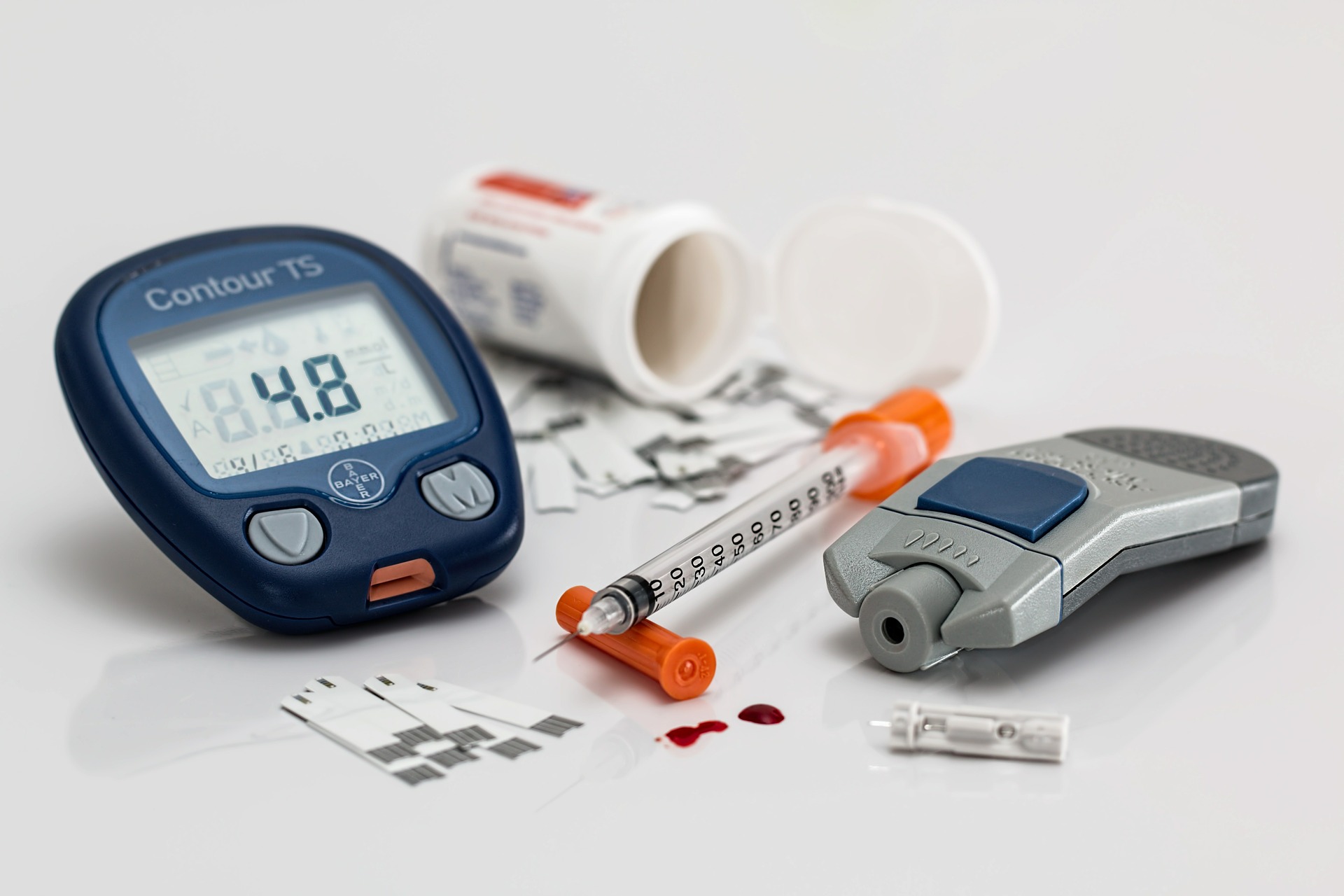
Joseph is a college student who has watched his father suffer from complications of type 2 diabetes for the past few years. For people with type 2 diabetes, the hormone insulin does not transmit its signal sufficiently. Insulin normally removes sugar from the bloodstream and brings it into the body’s cells. Diabetes prevents blood sugar levels from being properly regulated, and this can cause damage to the cells.
Diabetes can be treated with insulin injections, as shown above, as well as with dietary modifications, but complications can still occur. Joseph’s father has some nerve damage (or neuropathy) in his feet which makes his feet numb. He didn’t notice when he developed minor injuries to his feet which caused some serious infections.
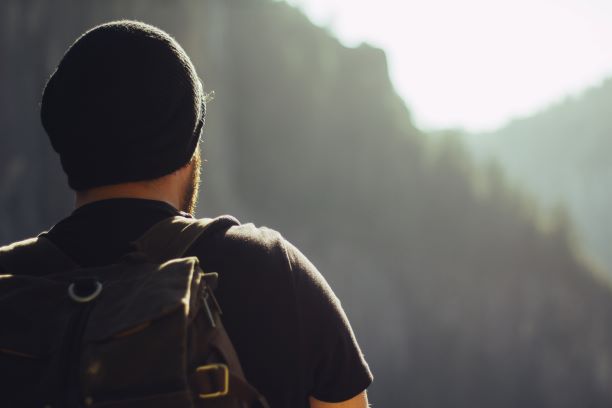
Joseph is obese and knows that his weight — along with a family history of diabetes — increases his risk of getting the disease himself. He wants to avoid the health issues that his father suffered, so he begins walking every day for exercise and starts to lose weight. Joseph also wants to improve his diet in order to lose more weight, lower his risk of diabetes, and improve his general health, but he is overwhelmed with all of the different dietary advice he reads online and hears from his friends and family.
Joseph’s father tells him to limit refined carbohydrates, such as white bread and rice, because that is what he does to help keep his blood sugar at an acceptable level, but Joseph’s friend tells him that eating a diet high in carbohydrates and low in fat is a good way to lose weight. Joseph reads online that “eating clean” by eating whole, unprocessed foods and avoiding food with “chemicals” can help with weight loss. One piece of advice that everyone seems to agree on is that drinking enough water is good for overall health.
All this dietary advice may sound confusing, but you can better understand health conditions, such as diabetes, and the role of diet and nutrition by understanding chemistry. Chemistry is much more than chemical reactions in test tubes in a lab — it is the atoms, molecules, and reactions that make us who we are and keep us alive and functioning properly. Our diets are one of the main ways our bodies take in raw materials that are needed for the important chemical reactions that take place inside of us.
Chapter Overview: Chemistry
As you read this chapter, you will learn more about how chemistry relates to our lives, health, and the foods we eat. Specifically, you will learn about:
- The nature of chemical substances, including elements, compounds, and their component atoms and molecules.
- The structures and functions of biochemical compounds, including carbohydrates, lipids, proteins, and nucleic acids (such as DNA and RNA).
- What chemical reactions are, how energy is involved in chemical reactions, how enzymes assist in chemical reactions, and some types of biochemical reactions in living organisms.
- Properties of water and the importance of water for most biochemical processes.
- What pH is, and why maintaining a proper pH in the body is important for biochemical reactions.
As you read the chapter, think about the following questions regarding Joseph’s situation, as well as how diabetes and diet relate to the chemistry of life:
- Why do you think Joseph’s father's diabetes increases Joseph's risk of getting diabetes?
- What is the difference between refined (simple) carbohydrates and complex carbohydrates? Why are refined carbohydrates particularly problematic for people with diabetes?
- Insulin is a peptide hormone. In which class of biochemical compounds would you categorize insulin?
- Why is drinking enough water important for overall health? Can you drink too much water?
- Sometimes “eating clean” is described as avoiding “chemicals” in food. Think about the definition of “chemicals” and how it relates to what we eat.
Attributions
Figure 3.1.1
Diabetes-equipment by Steve Buissinne [stevepb] on Pixabay is used under the Pixabay License (https://pixabay.com/de/service/license/).
Figure 3.1.2
Early Morning Hike, by Luke Pamer on Unsplash, is used under the Unsplash license (https://unsplash.com/license).
References
Mayo Clinic Staff. (n.d.). Peripheral neuropathy [online article]. MayoClinic.org. https://www.mayoclinic.org/diseases-conditions/peripheral-neuropathy/symptoms-causes/syc-20352061
Mayo Clinic Staff. (n.d.). Type 2 diabetes [online article]. MayoClinic.org. https://www.mayoclinic.org/diseases-conditions/type-2-diabetes/symptoms-causes/syc-20351193
Created by: CK-12/Adapted by Christine Miller
What Are You Made of?

Your entire body is made of cells and cells are made of molecules.If you look at your hand, what do you see? Of course, you see skin, which consists of cells. But what are skin cells made of? Like all living cells, they are made of matter. In fact, all things are made of matter. Matter is anything that takes up space and has mass. Matter, in turn, is made up of chemical substances. A chemical substance is matter that has a definite composition that is consistent throughout. A chemical substance may be either an element or a compound.
Elements and Atoms
An element is a pure substance. It cannot be broken down into other types of substances. Each element is made up of just one type of atom.
Structure of an Atom
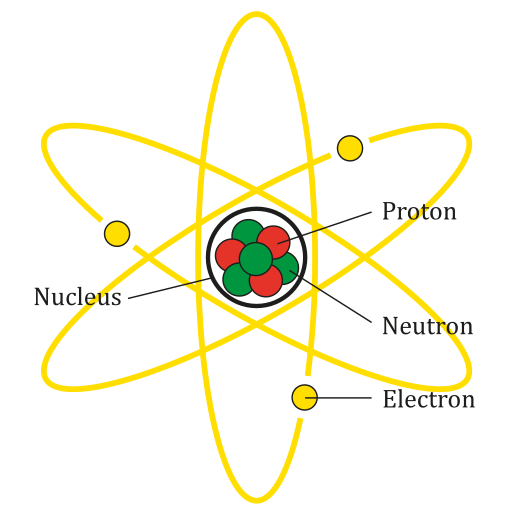
An atom is the smallest particle of an element that still has the properties of that element. Every substance is composed of atoms. Atoms are extremely small, typically about a ten-billionth of a metre in diametre. However, atoms do not have well-defined boundaries, as suggested by the atomic model shown below.
Every atom is composed of a central area — called the nucleus — and one or more subatomic particles called electrons, which move around the nucleus. The nucleus also consists of subatomic particles. It contains one or more protons and typically a similar number of neutrons. The number of protons in the nucleus determines the type of element an atom represents. An atom of hydrogen, for example, contains just one proton. Atoms of the same element may have different numbers of neutrons in the nucleus. Atoms of the same element with the same number of protons — but different numbers of neutrons — are called isotopes.
Protons have a positive electric charge and neutrons have no electric charge. Virtually all of an atom's mass is in the protons and neutrons in the nucleus. Electrons surrounding the nucleus have almost no mass, as well as a negative electric charge. If the number of protons and electrons in an atom are equal, then an atom is electrically neutral, because the positive and negative charges cancel each other out. If an atom has more or fewer electrons than protons, then it has an overall negative or positive charge, respectively, and it is called an ion.
The negatively-charged electrons of an atom are attracted to the positively-charged protons in the nucleus by a force called electromagnetic force, for which opposite charges attract. Electromagnetic force between protons in the nucleus causes these subatomic particles to repel each other, because they have the same charge. However, the protons and neutrons in the nucleus are attracted to each other by a different force, called nuclear force, which is usually stronger than the electromagnetic force. Nuclear force repels the positively-charged protons from each other.
Periodic Table of the Elements
There are almost 120 known elements. As you can see in the Periodic Table of the Elements shown below, the majority of elements are metals. Examples of metals are iron (Fe) and copper (Cu). Metals are shiny and good conductors of electricity and heat. Nonmetal elements are far fewer in number. They include hydrogen (H) and oxygen (O). They lack the properties of metals.
The periodic table of the elements arranges elements in groups based on their properties. The element most important to life is carbon (C). Find carbon in the table. What type of element is it: metal or nonmetal?
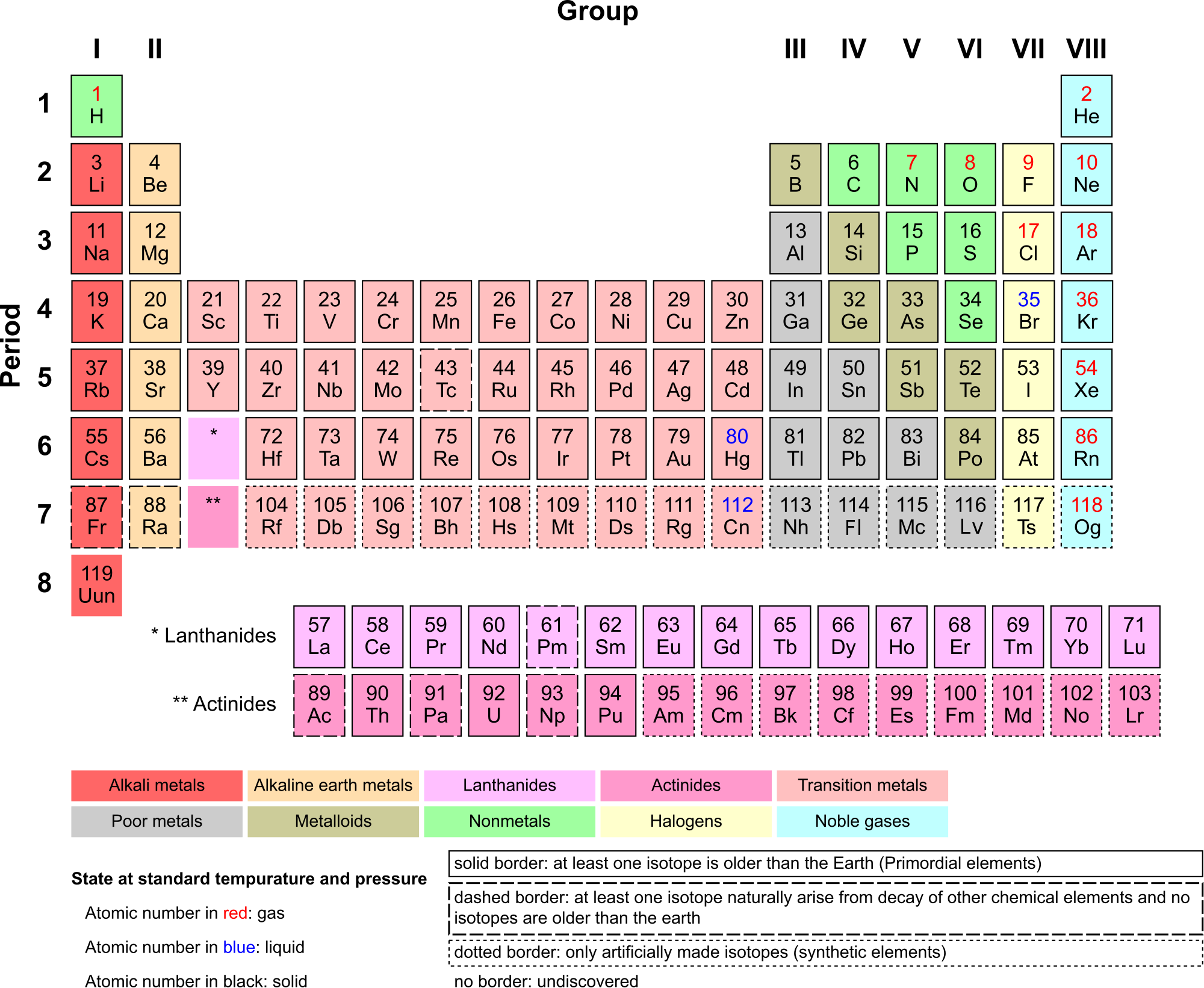
Compounds and Molecules
A compound is a unique substance that consists of two or more elements combined in fixed proportions. This means that the composition of a compound is always the same. The smallest particle of most compounds in living things is called a molecule.

Consider water as an example. A molecule of water always contains one atom of oxygen and two atoms of hydrogen. The composition of water is expressed by the chemical formula H2O. A model of a water molecule is shown in Figure 3.2.4.
What causes the atoms of a water molecule to “stick” together? The answer is chemical bonds. A chemical bond is a force that holds together the atoms of molecules. Bonds in molecules involve the sharing of electrons among atoms. New chemical bonds form when substances react with one another. A chemical reaction is a process that changes some chemical substances into others. A chemical reaction is needed to form a compound, and another chemical reaction is needed to separate the substances in that compound.
3.2 Summary
- All matter consists of chemical substances. A chemical substance has a definite composition which is consistent throughout. A chemical substance may be either an element or a compound.
- An element is a pure substance that cannot be broken down into other types of substances.
- An atom is the smallest particle of an element that still has the properties of that element. Atoms, in turn, are composed of subatomic particles, including negative electrons, positive protons, and neutral neutrons. The number of protons in an atom determines the element it represents.
- Atoms have equal numbers of electrons and protons, so they have no charge. Ions are atoms that have lost or gained electrons, and as a result have either a positive or negative charge. Atoms with the same number of protons — but different numbers of neutrons — are called isotopes.
- There are almost 120 known elements. The majority of elements are metals. A smaller number are nonmetals. The latter include carbon, hydrogen, and oxygen.
- A compound is a substance that consists of two or more elements in a unique composition. The smallest particle of a compound is called a molecule. Chemical bonds hold together the atoms of molecules. Compounds can form only in chemical reactions, and they can break down only in other chemical reactions.
3.2 Review Questions
-
- What is an element? Give three examples.
- Define compound. Explain how compounds form.
- Compare and contrast atoms and molecules.
- The compound called water can be broken down into its constituent elements by applying an electric current to it. What ratio of elements is produced in this process?
- Relate ions and isotopes to elements and atoms.
- What is the most important element to life?
- Iron oxide is often known as rust — the reddish substance you might find on corroded metal. The chemical formula for this type of iron oxide is Fe2O3. Answer the following questions about iron oxide and briefly explain each answer.
- Is iron oxide an element or a compound?
- Would one particle of iron oxide be considered a molecule or an atom?
- Describe the relative proportion of atoms in iron oxide.
- What causes the Fe and O to stick together in iron oxide?
- Is iron oxide made of metal atoms, metalloid atoms, nonmetal atoms, or a combination of any of these?
- 14C is an isotope of carbon used in the radiocarbon dating of organic material. The most common isotope of carbon is 12C. Do you think 14C and 12C have different numbers of neutrons or protons? Explain your answer.
- Explain why ions have a positive or negative charge.
- Name the three subatomic particles described in this section.
3.2 Explore More
https://www.youtube.com/watch?v=yQP4UJhNn0I&feature=emb_logo
Just how small is an atom? TED-Ed, 2012
Attributions
Figure 3.2.1
Man Sitting, by Gregory Culmer, on Unsplash, is used under the Unsplash license (https://unsplash.com/license).
Figure 3.2.2
Lithium Atom diagram, by AG Caesar, is used under a CC BY-SA 4.0 (https://creativecommons.org/licenses/by-sa/4.0/deed.en)
Figure 3.2.3
Periodic Table Armtuk3, by Armtuk, is used under a CC BY-SA 3.0 (https://creativecommons.org/licenses/by-sa/3.0/) license.
Figure 3.2.4
Water molecule, by Sakurambo, is released into the public domain (https://en.wikipedia.org/wiki/Public_domain).
References
TED-Ed. (2012, April 16). Just how small is an atom. YouTube. https://www.youtube.com/watch?v=yQP4UJhNn0I&feature=youtu.be
Created by: CK-12/Adapted by Christine Miller
The original version of this chapter contained H5P content. You may want to remove or replace this element.
Figure 3.3.1 Carbo-licious!
Carbs Galore
What do all of these foods have in common? All of them consist mainly of large compounds called carbohydrates, often referred to as "carbs." Contrary to popular belief, carbohydrates are an important part of a healthy diet. They are also one of four major classes of biological macromolecules.
Chemical Compounds in Living Things
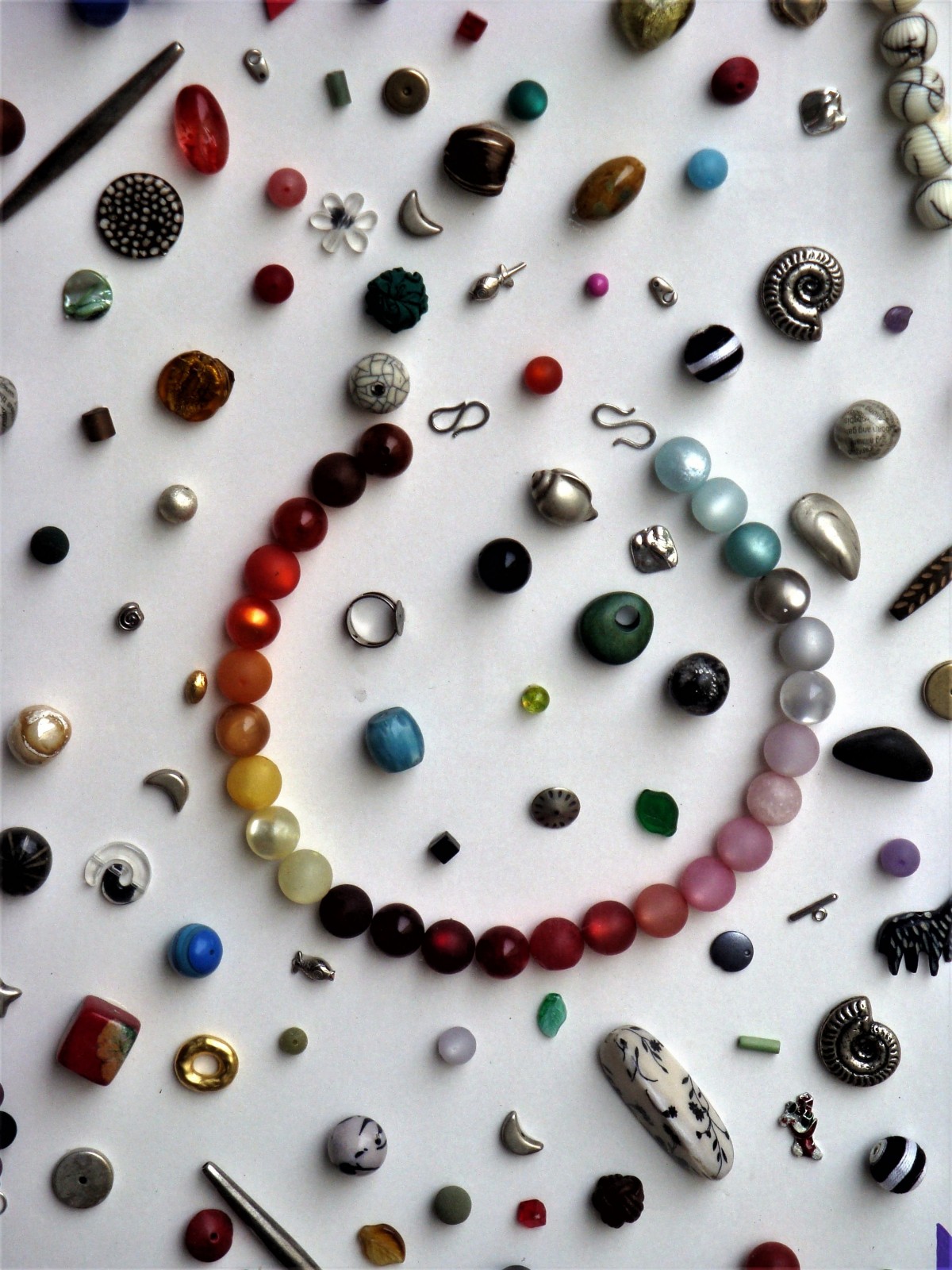
The compounds found in living things are known as biochemical compounds or biological molecules. Biochemical compounds make up the cells and other structures of organisms. They also carry out life processes. Carbon is the basis of all biochemical compounds, so carbon is essential to life on Earth. Without carbon, life as we know it could not exist.
Carbon is so basic to life because of its ability to form stable bonds with many elements, including itself. This property allows carbon to create a huge variety of very large and complex molecules. In fact, there are nearly 10 million carbon-based compounds in living things!
Most biochemical compounds are very large molecules called polymers. A polymer is built of repeating units of smaller compounds called monomers. Monomers are like the individual beads on a string of beads, and the whole string is the polymer. The individual beads (monomers) can do some jobs on their own, but sometimes you need a larger molecule, so the monomers can be connected to form polymers.
Classes of Biochemical Compounds
Although there are millions of different biochemical compounds in Earth's living things, all biochemical compounds contain the elements carbon, hydrogen, and oxygen. Some contain only these elements, while others contain additional elements, as well. The vast number of biochemical compounds can be grouped into just four major classes: carbohydrates, lipids, proteins, and nucleic acids.
Carbohydrates
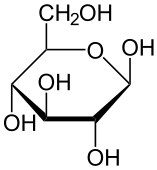
Carbohydrates include sugars and starches. These compounds contain only the elements carbon, hydrogen, and oxygen. In living things, carbohydrates provide energy to cells, store energy, and form certain structures (such as the cell walls of plants). The monomer that makes up large carbohydrate compounds is called a monosaccharide. The sugar glucose, represented by the chemical model in Figure 3.3.2, is a monosaccharide. It contains six carbon atoms (C), along with several atoms of hydrogen (H) and oxygen (O). Thousands of glucose molecules can join together to form a polysaccharide, such as starch.
Lipids
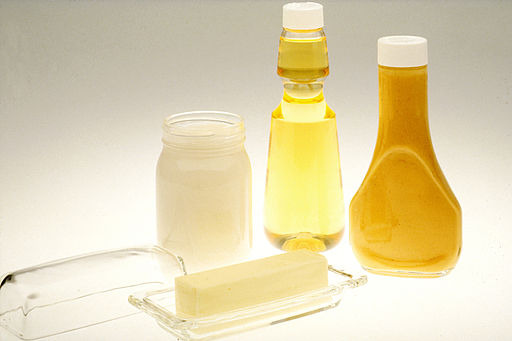
Lipids include fats and oils. They primarily contain the elements carbon, hydrogen, and oxygen, although some lipids contain additional elements, such as phosphorus. Lipids function in living things to store energy, form cell membranes, and carry messages. Lipids consist of repeating units that join together to form chains called fatty acids. Most naturally occurring fatty acids have an unbranched chain of an even number (generally between 4 and 28) of carbon atoms.
Proteins
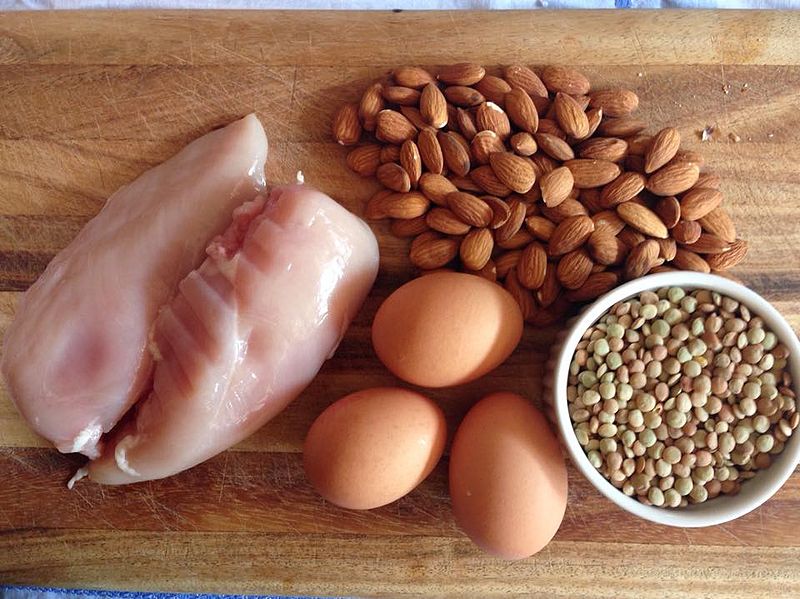
Proteins include enzymes, antibodies, and many other important compounds in living things. They contain the elements carbon, hydrogen, oxygen, nitrogen, and sulfur. Functions of proteins are very numerous. They help cells keep their shape, compose muscles, speed up chemical reactions, and carry messages and materials. The monomers that make up large protein compounds are called amino acids. There are 20 different amino acids that combine into long chains (called polypeptides) to form the building blocks of a vast array of proteins in living things.
Nucleic Acids
Nucleic acids include the molecules DNA (deoxyribonucleic acid) and RNA(ribonucleic acid). They contain the elements carbon, hydrogen, oxygen, nitrogen, and phosphorus. Their functions in living things are to encode instructions for making proteins, to help make proteins, and to pass instructions between parents and offspring. The monomer that makes up nucleic acids is the nucleotide. All nucleotides are the same, except for a component called a nitrogen base. There are four different nitrogen bases, and each nucleotide contains one of these four bases. The sequence of nitrogen bases in the chains of nucleotides in DNA and RNA makes up the code for protein synthesis, which is called the genetic code. The animation in Figure 3.3.5 represents the very complex structure of DNA, which consists of two chains of nucleotides.
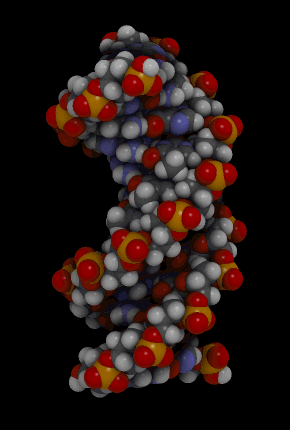
3.3 Summary
- Biochemical compounds are carbon-based compounds found in living things. They make up cells and other structures of organisms and carry out life processes. Most biochemical compounds are large molecules called polymers that consist of many repeating units of smaller molecules, which are called monomers.
- There are millions of biochemical compounds, but all of them fall into four major classes: carbohydrates, lipids, proteins, and nucleic acids.
- Carbohydrates include sugars and starches. They provide cells with energy, store energy, and make up organic structures, such as the cell walls of plants.
- Lipids include fats and oils. They store energy, form cell membranes, and carry messages.
- Proteins include enzymes, antibodies, and numerous other important compounds in living things. They have many functions — helping cells keep their shape, making up muscles, speeding up chemical reactions, and carrying messages and materials.
- Nucleic acids include DNA and RNA. They encode instructions for making proteins, help make proteins, and pass encoded instructions from parents to offspring.
3.3 Review Questions
- Why is carbon so important to life on Earth?
- What are biochemical compounds?
- Describe the diversity of biochemical compounds and explain how they are classified.
- Identify two types of carbohydrates. What are the main functions of this class of biochemical compounds?
- What roles are played by lipids in living things?
- The enzyme amylase is found in saliva. It helps break down starches in foods into simpler sugar molecules. What type of biochemical compound do you think amylase is?
- Explain how DNA and RNA contain the genetic code.
- What are the three elements present in every class of biochemical compound?
- Classify each of the following terms as a monomer or a polymer:
- Nucleic acid
- Amino acid
- Monosaccharide
- Protein
- Nucleotide
- Polysaccharide
- Match each of the above monomers with its correct polymer and identify which class of biochemical compound is represented by each monomer/polymer pair.
- Is glucose a monomer or a polymer? Explain your answer.
- What is one element contained in proteins and nucleic acids, but not in carbohydrates?
- Describe the relationship between proteins and nucleic acids.
- Why do you think it is important to eat a diet that contains a balance of carbohydrates, proteins, and fats?
- Examine the picture of the meal in Figure 3.3.6. What types of biochemical compounds can you identify?

3.3 Explore More
https://youtu.be/YO244P1e9QM
Biomolecules (updated), by the Amoeba Sisters, 2016.
Attributions
Figure 3.3.1
- Cinnamon buns by adamkontor on Pixabay is used under the Pixabay License (https://pixabay.com/de/service/license/).
- Sugar by Bru-nO on Pixabay is used under the Pixabay License (https://pixabay.com/de/service/license/).
- Potatoes by HolgersFotografie on Pixabay is used under the Pixabay License (https://pixabay.com/de/service/license/).
- Blueberries; oatmeal by iha31 on Pixabay is used under the Pixabay License (https://pixabay.com/de/service/license/).
- Bread by pics_pd on Pixnio is used under a public domain certification (https://creativecommons.org/licenses/publicdomain/).
- Spaghetti by RitaE on Pixabay is used under the Pixabay License (https://pixabay.com/de/service/license/).
Figure 3.3.2
jewellery_beads_stones_necklace-1200668 on Pxhere, is used under a CC0 1.0 universal public domain dedication license (https://creativecommons.org/publicdomain/zero/1.0/).
Figure 3.3.3
Glucose; Structure of beta-D-glucopyranose (Haworth projection), by NEUROtiker on Wikimedia Commons, has been released into the public domain (https://en.wikipedia.org/wiki/Public_domain).
Figure 3.3.4
Lipid Examples; Butter and Oil, by Bill Branson (photographer), on Wikimedia Commons is released into the public domain (https://en.wikipedia.org/wiki/Public_domain).
Figure 3.3.5
Protein-rich_Foods, by Smastronardo on Wikimedia Commons, is used under a CC BY-SA 4.0 (https://creativecommons.org/licenses/by-sa/4.0) license.
Figure 3.3.6
Bdna_cropped [gif], by Jahobr on Wikimedia Commons, is released into the public domain (https://en.wikipedia.org/wiki/Public_domain) (This is a derivative work from Bdna.gif by Spiffistan.)
Figure 3.3.7Dinner by Quốc Trung [@boeing] on Unsplash is used under the Unsplash License (https://unsplash.com/license).
Reference
Amoeba Sisters. (2016, February 11). Biomolecules (updated). YouTube. https://www.youtube.com/watch?v=YO244P1e9QM&feature=youtu.be
Created by: CK-12/Adapted by Christine Miller
The Cellulose of Our Lives
Created by: CK-12/Adapted by Christine Miller
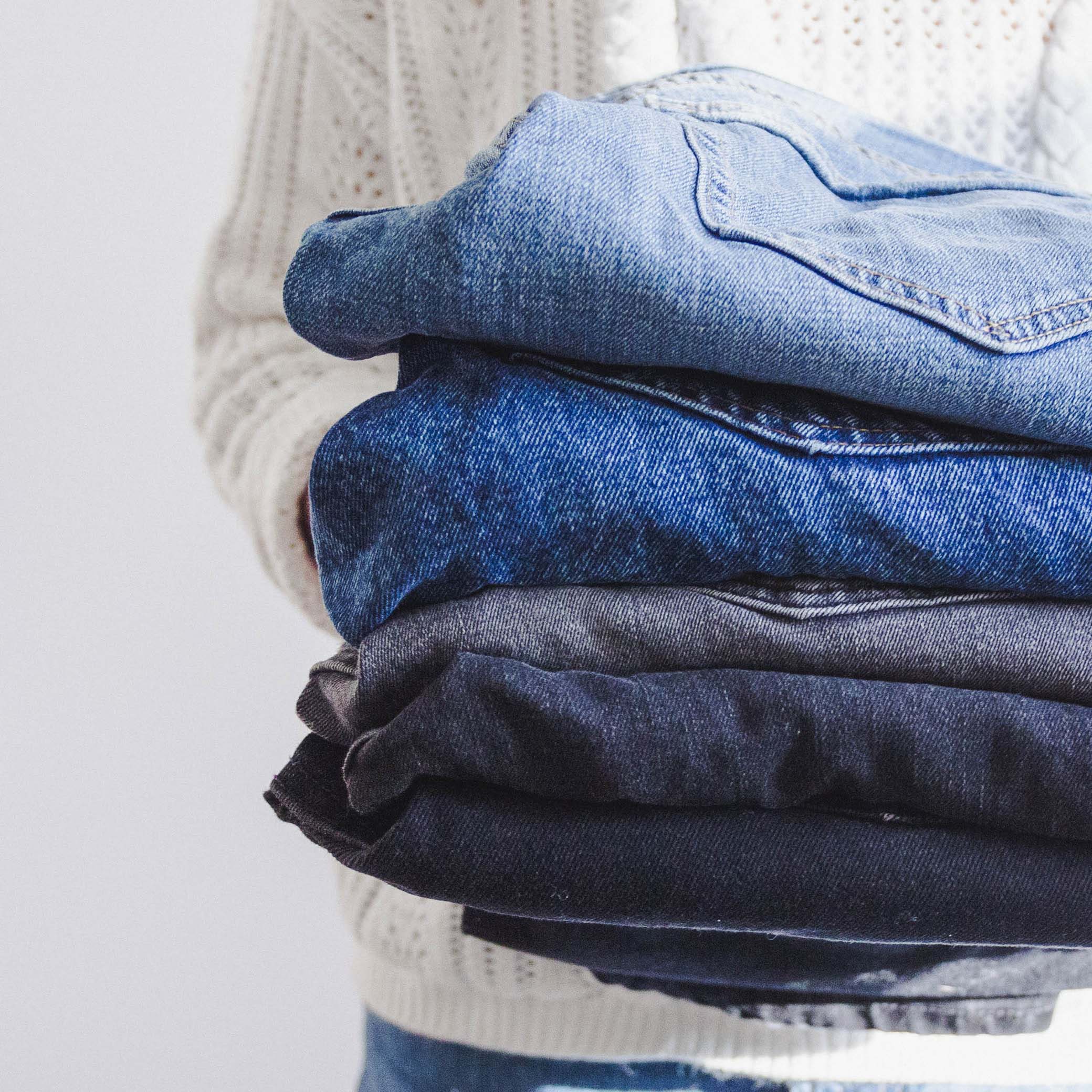
Where would we be without our jeans? They have been the go-to pants for many people for decades, and they are still as popular as ever. Jeans are made of denim, a type of cotton fabric. Cotton is a soft, fluffy fibre that grows in a protective case around the seeds of cotton plants. The fibre is almost pure cellulose. Cellulose is the single most abundant biochemical compound found in Earth's living things, and it's one of several types of carbohydrates.
What Are Carbohydrates?
Carbohydrates are the most common class of biochemical compounds. They include sugars and starches. Carbohydrates are used to provide or store energy, among other uses. Like most biochemical compounds, carbohydrates are built of small repeating units, or monomers, which form bonds with each other to make larger molecules, called polymers. In the case of carbohydrates, the small repeating units are known as monosaccharides. Each monosaccharide consists of six carbon atoms, as shown in the model of the monosaccharide glucose shown in Figure 3.4.2.
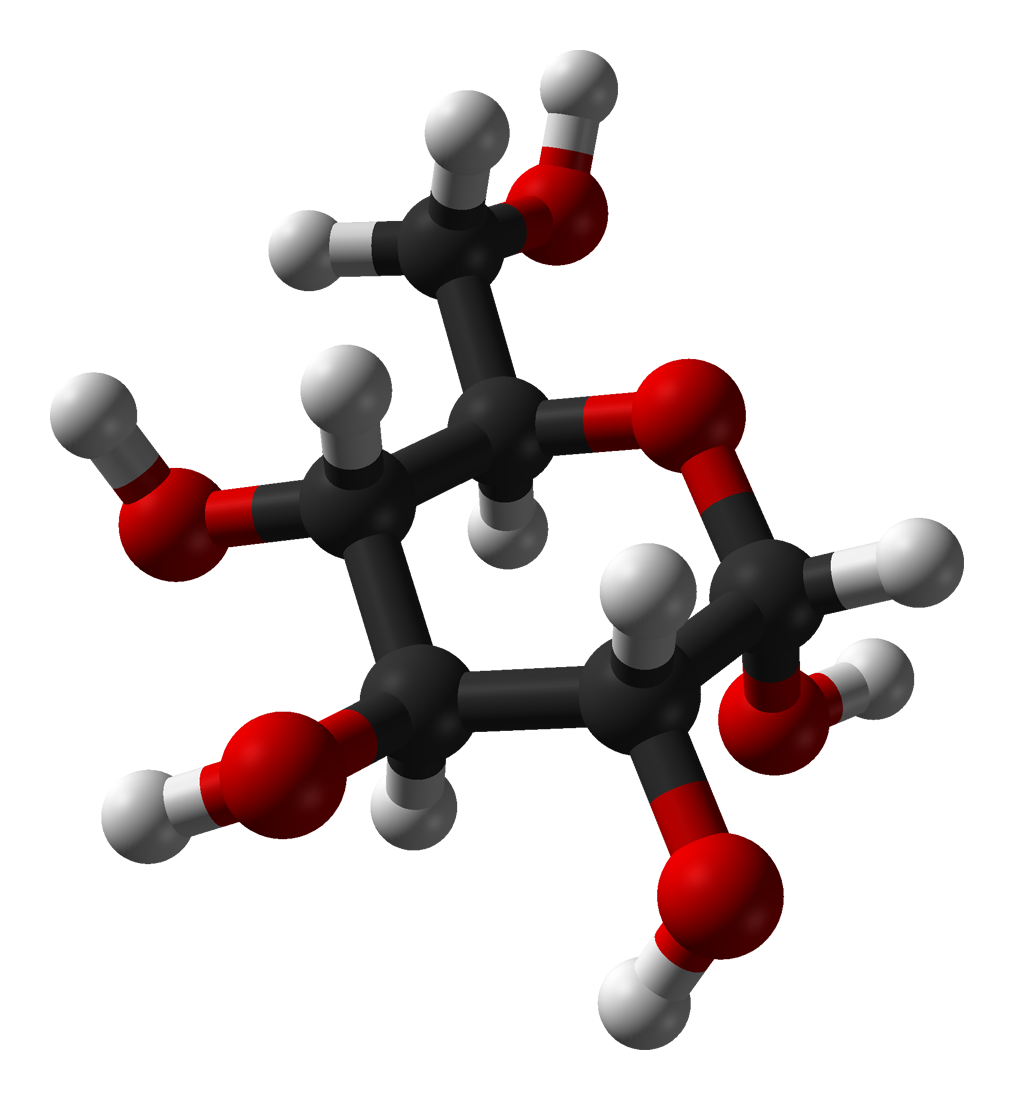
Sugars
Sugars are the general name for sweet, short-chain, soluble carbohydrates, which are found in many foods. Their function in living things is to provide energy. The simplest sugars consist of a single monosaccharide. They include glucose, fructose, and galactose. Glucose is a simple sugar that is used for energy by the cells of living things. Fructose is a simple sugar found in fruits, and galactose is a simple sugar found in milk. Their chemical structures are shown in Figure 3.4.3. All monosaccharides have the formula C6H12O6.
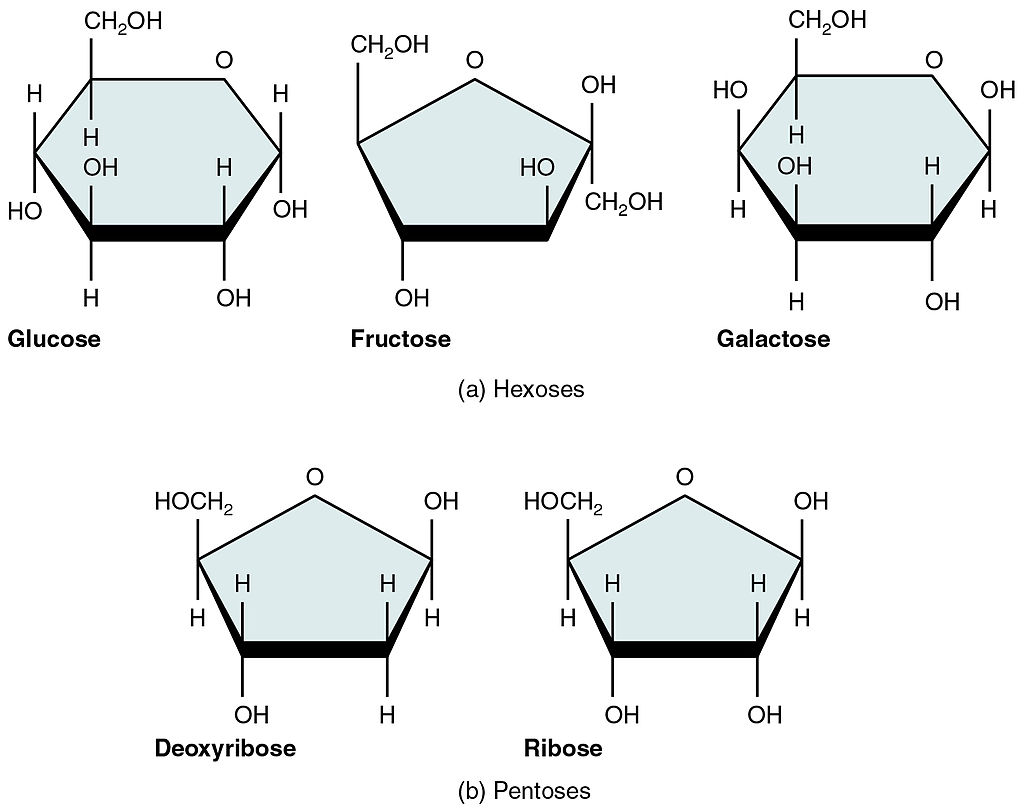
Other sugars contain two monosaccharide molecules and are called disaccharides. These include sucrose (table sugar), maltose, and lactose. Sucrose is composed of one fructose molecule and one glucose molecule, maltose is composed of two glucose molecules, and lactose is composed of one glucose molecule and one galactose molecule. Lactose occurs naturally in milk. Some people are lactose intolerant because they can't digest lactose. If they drink milk, it causes gas, cramps, and other unpleasant symptoms, unless the milk has been processed to remove the lactose.
Complex Carbohydrates
Some carbohydrates consist of hundreds — or even thousands! — of monosaccharides bonded together in long chains. These carbohydrates are called polysaccharides ("many saccharides"). Polysaccharides are also referred to as complex carbohydrates. Complex carbohydrates that are found in living things include starch, glycogen, cellulose, and chitin. Each type of complex carbohydrate has different functions in living organisms, but they generally either store energy or make up certain structures in living things.
Starch
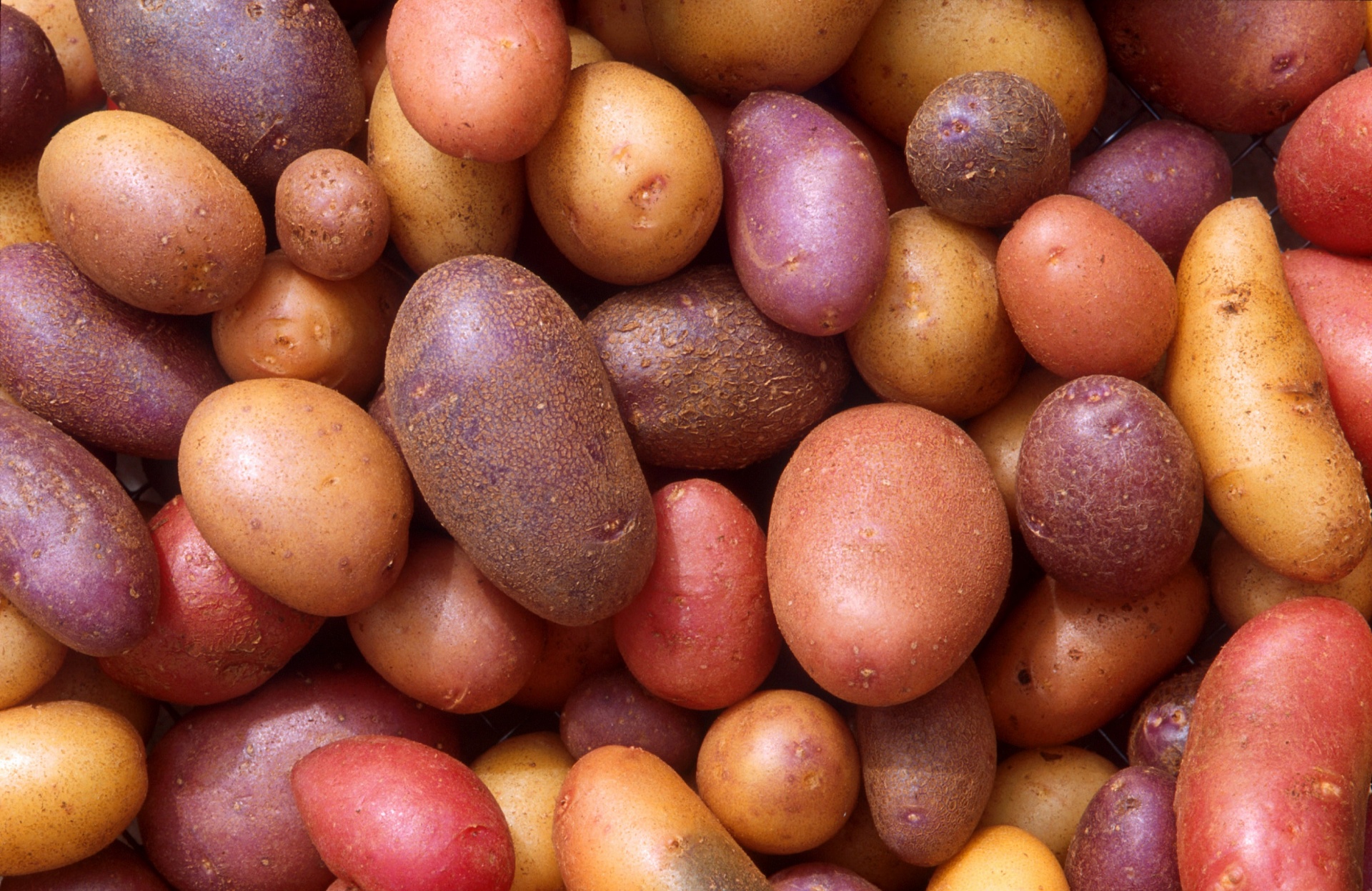
Starch is a complex carbohydrate that is made by plants to store energy. For example, the potatoes pictured in Figure 3.4.4 are packed full of starches that consist mainly of repeating units of glucose and other simple sugars. The leaves of potato plants make sugars by photosynthesis, and the sugars are carried to underground tubers where they are stored as starch. When we eat starchy foods such as potatoes, the starches are broken down by our digestive system into sugars, which provide our cells with energy. Starches are easily and quickly digested with the help of digestive enzymes such as amylase, which is found in the saliva. If you chew a starchy saltine cracker for several minutes, you may start to taste the sugars released as the starch is digested.
Glycogen
Animals do not store energy as starch. Instead, animals store extra energy as the complex carbohydrate glycogen. Glycogen is a polysaccharide of glucose. It serves as a form of energy storage in fungi (as well as animals), and it is the main storage form of glucose in the human body. In humans, glycogen is made and stored primarily in the cells of the liver and muscles. When energy is needed from either storage area, the glycogen is broken down to glucose for use by cells. Muscle glycogen is converted to glucose for use by muscle cells, and liver glycogen is converted to glucose for use throughout the rest of the body. Glycogen forms an energy reserve that can be quickly mobilized to meet a sudden need for glucose, but one that is less compact than the energy reserves of lipids, which are the primary form of energy storage in animals.
Glycogen plays a critical part in the homeostasis of glucose levels in the blood. When blood glucose levels rise too high, excess glucose can be stored in the liver by converting it to glycogen. When glucose levels in the blood fall too low, glycogen in the liver can be broken down to glucose and released into the blood.
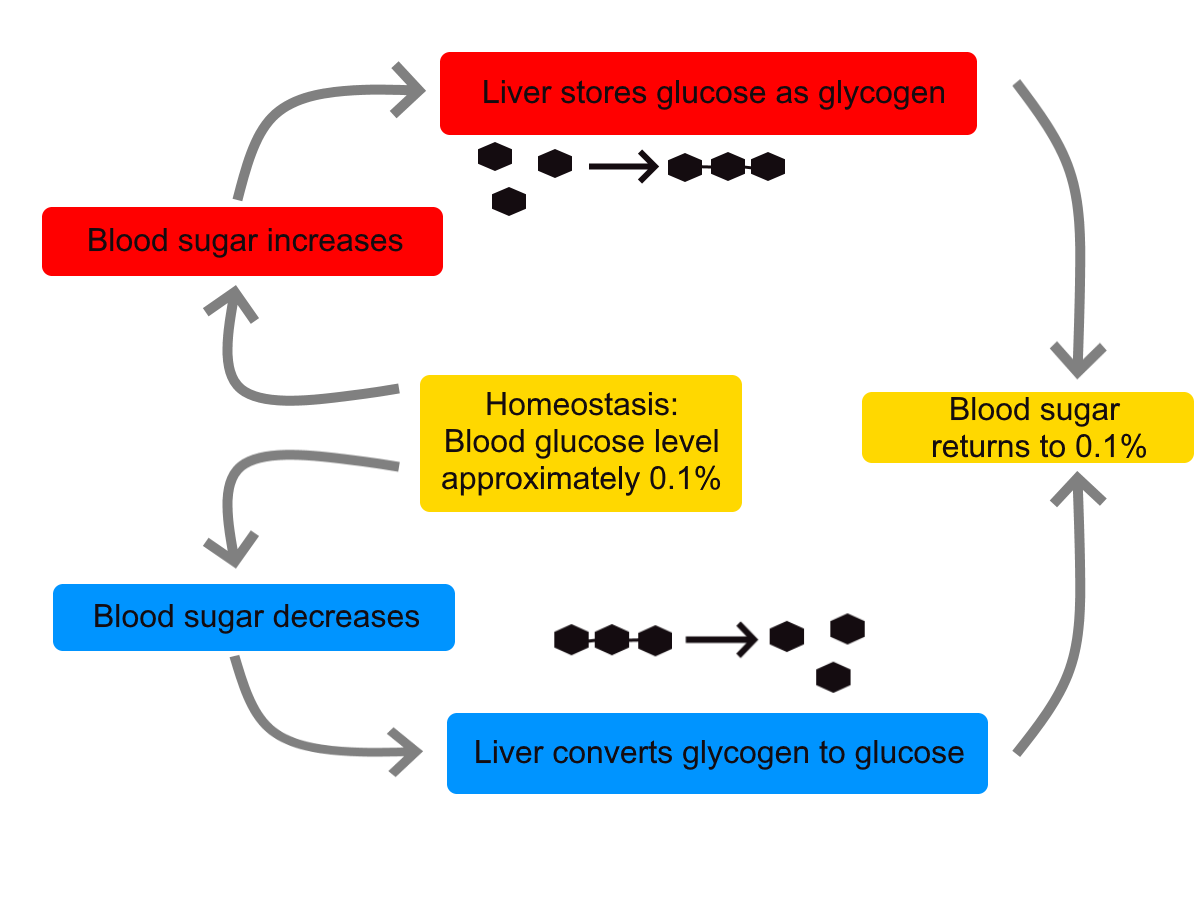
Cellulose
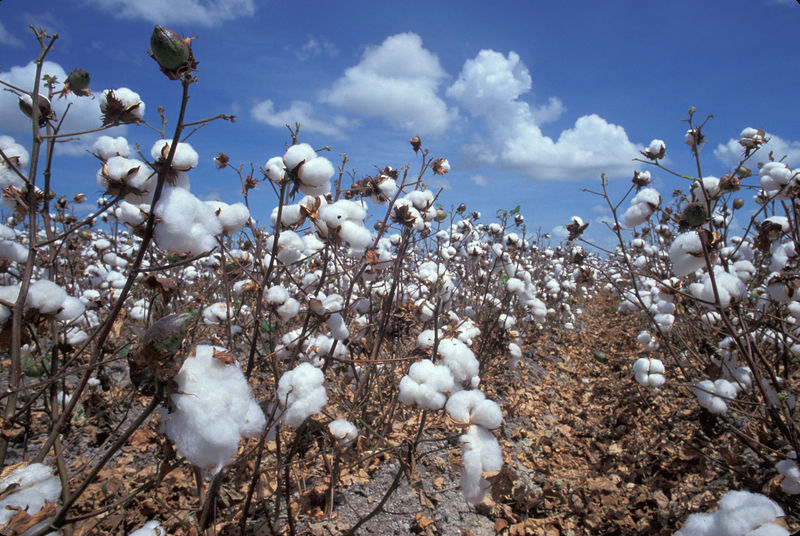
Cellulose is a polysaccharide consisting of a linear chain of several hundred to many thousands of linked glucose units. Cellulose is an important structural component of the cell walls of plants and many algae. Human uses of cellulose include the production of cardboard and paper, which consist mostly of cellulose from wood and cotton. The cotton fibres pictured are about 90 per cent cellulose.
Certain animals, including termites and ruminants such as cows, can digest cellulose with the help of microorganisms that live in their gut. Humans cannot digest cellulose, but it nonetheless plays an important role in our diet. It acts as a water-attracting bulking agent for feces in the digestive tract and is often referred to as "dietary fibre." In simpler terms, it helps you poop.
Chitin
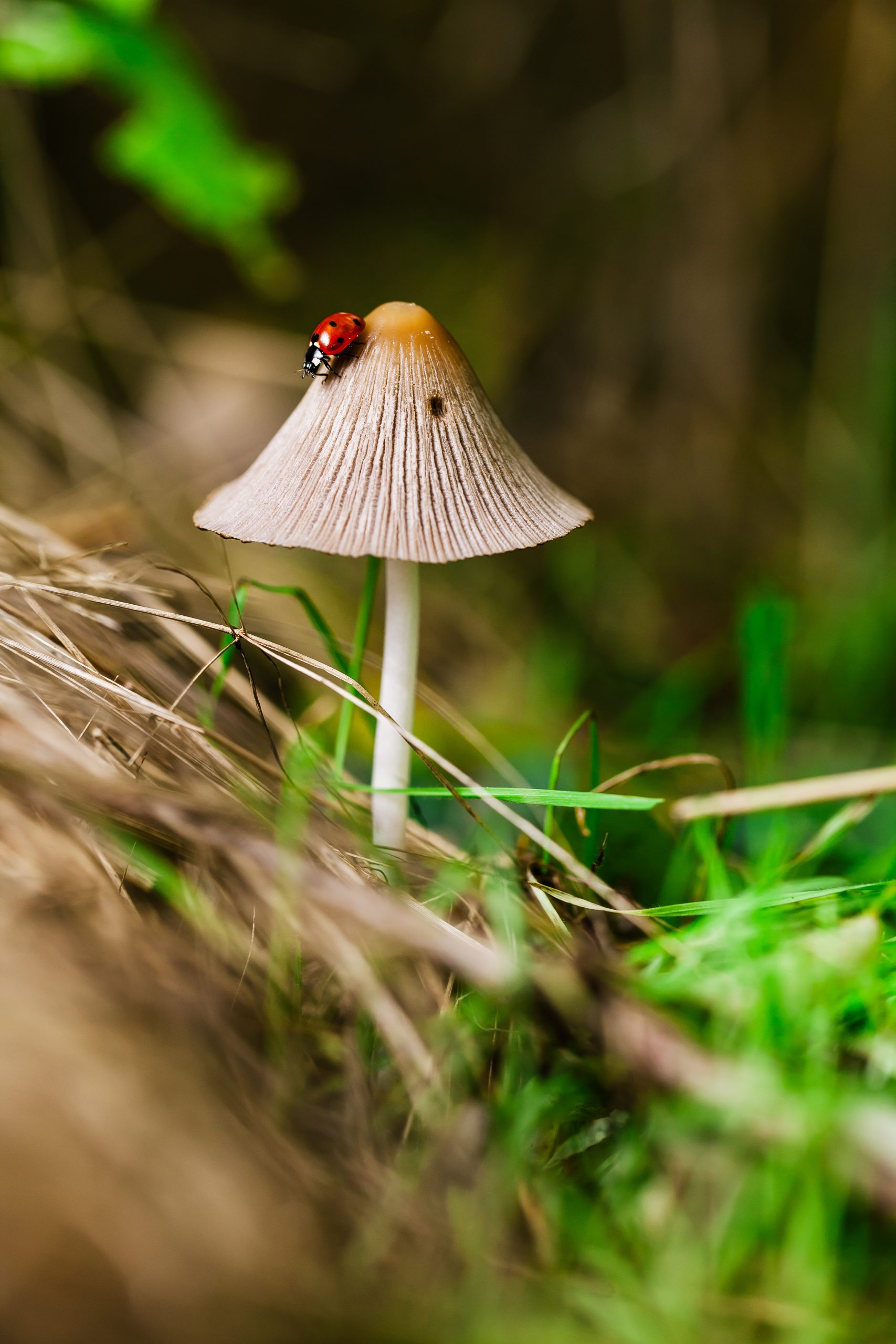
Chitin is a long-chain polymer of a derivative of glucose. It is found in many living things. For example, it is a component of the cell walls of fungi; the exoskeletons of arthropods, such as crustaceans and insects ; and the beaks and internal shells of animals, such as squids and octopuses. The structure of chitin is similar to that of cellulose.
In Figure 3.4.7, both the exoskeleton of the ladybug and the cell walls of the mushroom are made partly of the complex carbohydrate chitin.
The Right Molecule for the Job
Starch, glycogen, cellulose and chitin are all made from the monomer glucose. So how are they all so different? Their difference in structure and function is related to how they are linked together. Starch is linked in long chains with a small amount of branching, glycogen is linked in many branching chains, and chitin and cellulose form long single chains that pack together tightly. Each of these variations of linking the same monomer, glucose, together creates a different way the molecule can be used. As shown in the Figure 3.4.8 diagram, starch and glycogen have many exposed "ends" of their chains. These are areas where a glucose molecule can easily be removed for use as energy, whereas cellulose does not. For this reason, glycogen and starch are well-suited for energy storage in organisms while cellulose is not. Conversely, cellulose packs many monomers together in a sort of mesh that is very strong — this is why it is a great option for building strong cell walls.
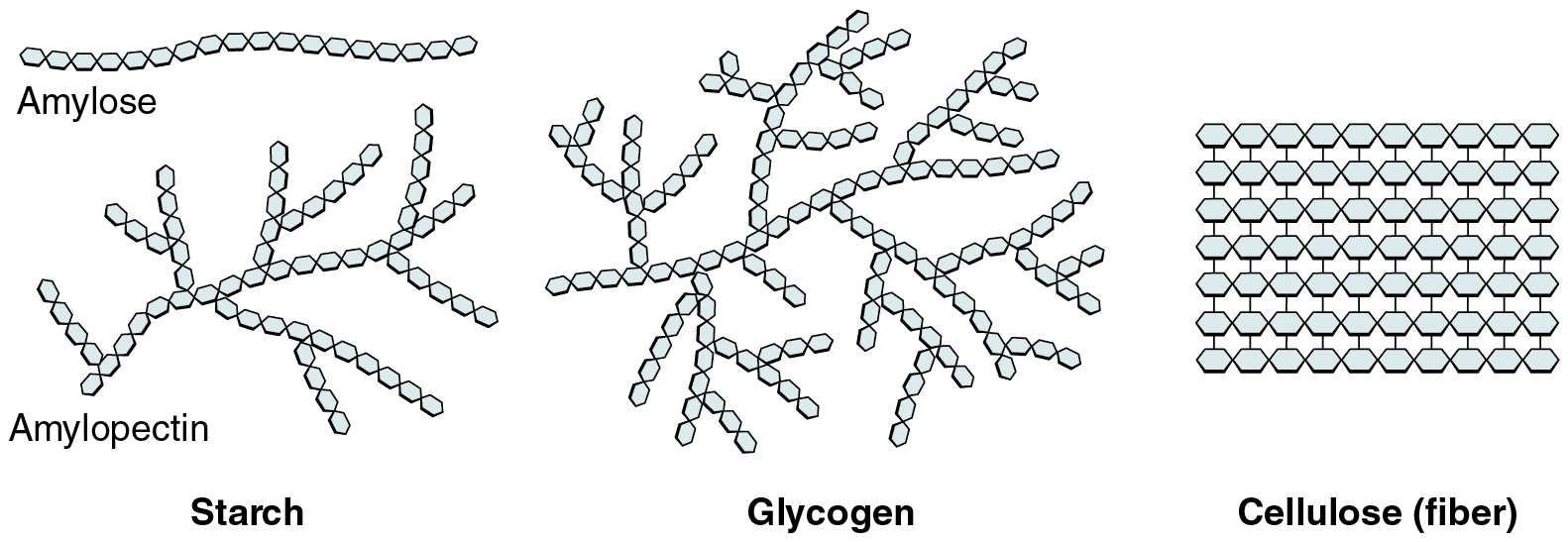
Feature: My Human Biology
You probably know that you should eat plenty of fibre, but do you know how much fibre you need, how fibre contributes to good health, or which foods are good sources of fibre? Dietary fibre consists mainly of cellulose, so it is found primarily in plant-based foods, including fruits, vegetables, whole grains, and legumes. Dietary fibre can't be broken down and absorbed by your digestive system. Instead, it passes relatively unchanged through your gastrointestinal tract and is excreted in feces (otherwise known as poop). That's how it helps keep you healthy.
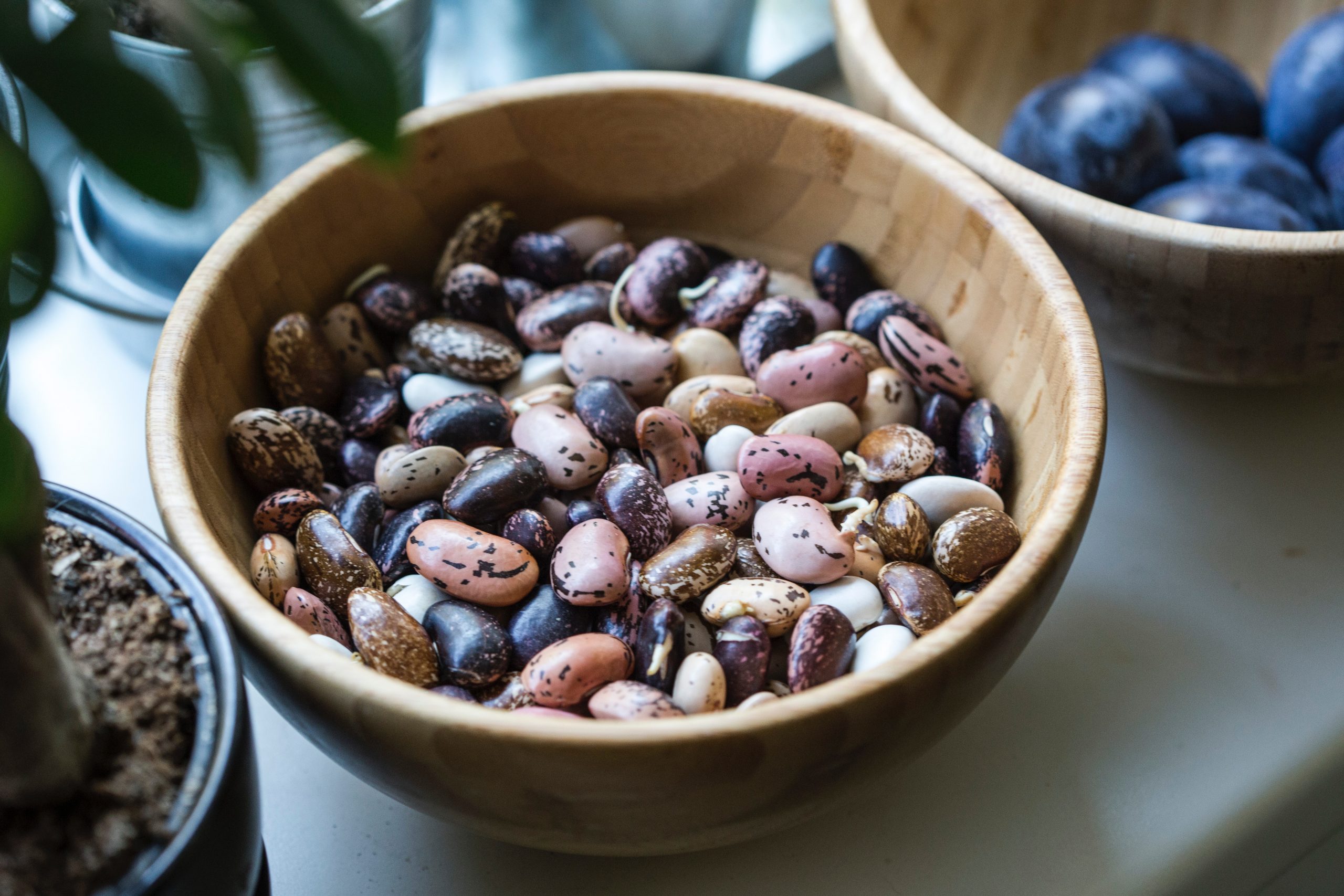
Fibre in food is commonly classified as either soluble or insoluble fibre.
- Soluble fibre dissolves in water to form a gel-like substance as it passes through the gastrointestinal tract. It lowers blood levels of cholesterol and glucose, which is beneficial for your health. Good sources of soluble fibre include whole oats, peas, beans, and apples.
- Insoluble fibre does not dissolve in water. This type of fibre increases the bulk of feces in the large intestine, and helps keep food wastes moving through, which may help prevent or correct constipation. Good sources of insoluble fibre include whole wheat, wheat bran, beans, and potatoes.
How much fibre do you need for good health? That depends on your age and gender. The Institute of Medicine recommends the daily fibre intake for adults shown in Table 3.4.1 below. Most dietitians further recommend a ratio of about three parts of insoluble fibre to one part of soluble fibre each day. Most fibre-rich foods contain both types of fibre, so it usually isn't necessary to keep track of the two types of fibre as long as your overall fibre intake is adequate.
Table 3.4.1
Recommended Daily Fibre Intake for Males and Females
| Recommended Daily Fibre Intake for Males and Females | ||
| Gender | Age 50 or Younger | Age 51 or Older |
| Male | 38 grams | 30 grams |
| Female | 25 grams | 21 grams |
Use food labels like the one shown below in Figure 3.4.10 and online fibre counters to find out how much total fibre you eat in a typical day. Are you consuming enough fibre for good health? If not, consider ways to increase your intake of this important substance. For example, substitute whole grains for refined grains, eat more legumes (such as beans), and try to consume at least five servings of fruits and vegetables each day.
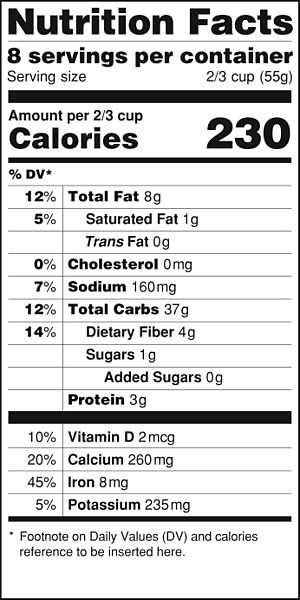
Table 3.4.2
Carbohydrate Comparison
Name |
Class |
Function |
Location |
| Glucose | Monosaccharide | Energy for cells | Cells |
| Starch | Polysaccharide | Energy storage | Plant cells |
| Glycogen | Polysaccharide | Energy storage | Animal cells |
| Cellulose | Polysaccharide | Structural component in cell walls | Plant cells |
| Chitin | Polysaccharide | Structural component in cell walls and exoskeletons | Fungi and arthropods |
3.4 Summary
- Carbohydrates are the most common class of biochemical compounds. The basic building block of carbohydrates is the monosaccharide, which consists of six carbon atoms.
- Sugars are sweet, short-chain, soluble carbohydrates that are found in many foods and supply us with energy. Simple sugars, such as glucose, consist of just one monosaccharide. Some sugars, such as sucrose (or table sugar), consist of two monosaccharides. These are called disaccharides.
- Complex carbohydrates, or polysaccharides, consist of hundreds — or even thousands — of monosaccharides. They include starch, glycogen, cellulose, and chitin. They generally either store energy or form structures, such as cell walls, in living things.
- Starch is a complex carbohydrate that is made by plants to store energy. Potatoes are a good food source of dietary starch, which is readily broken down into its component sugars during digestion.
- Glycogen is a complex carbohydrate that is made by animals and fungi to store energy. Glycogen plays a critical part in the homeostasis of blood glucose levels in humans.
- Cellulose is the single most common biochemical compound in living things. It forms the cell walls of plants and certain algae. Like most other animals, humans cannot digest cellulose, but it makes up most of the crucial dietary fibre in the human diet.
- Chitin is a complex carbohydrate, similar to cellulose, that makes up organic structures, such as the cell walls of fungi and the exoskeletons of insects and other arthropods.
3.4 Review Questions
- What are carbohydrates? Describe their structure.
- Compare and contrast sugars and complex carbohydrates.
-
- If you chew on a starchy food (such as a saltine cracker) for several minutes, it may start to taste sweet. Explain why.
- True or False: Glucose is mainly stored by lipids in the human body.
-
- Name three carbohydrates that contain glucose as a monomer.
- Jeans are made of tough, durable cotton. Based on what you know about the structure of carbohydrates, explain how you think this fabric gets its tough qualities.
- Which do you think is faster to digest — simple sugars or complex carbohydrates? Explain your answer.
- True or False: Cellulose is broken down in the human digestive system into glucose molecules.
- ___________ fibre dissolves in water, __________ fibre does not dissolve in water.
- What are the similarities and differences between muscle glycogen and liver glycogen?
- Which carbohydrate is used directly by the cells of living things for energy?
- Which of the following is not a complex carbohydrate?
- Chitin
- Starch
- Disaccharide
- None of the above
3.4 Explore More
https://youtu.be/wxzc_2c6GMg
How do carbohydrates impact your health? - Richard J. Wood, TED-Ed, 2016
https://www.youtube.com/watch?v=tKLJ6KQAcjI
Why is cotton in everything? - Michael R. Stiff, TED-Ed, 2020
Attributions
Figure 3.4.1
Jeans by Maude Frédérique Lavoie on Unsplash is used under the Unsplash License (https://unsplash.com/license).
Figure 3.4.2
e-from-xtal-1979-Alpha-D-glucose-from-xtal-1979-3D-balls by Ben Mills [Benjah-bmm27] on Wikimedia Commons, is released into the public domain (https://en.wikipedia.org/wiki/Public_domain).
Figure 3.4.3
Monosasccharides by OpenStax College on Wikimedia Commons is used under a CC BY 4.0 (https://creativecommons.org/licenses/by/4.0) license.
Figure 3.4.4
Potatoes by Jean Beaufort, on Public Domain Pictures.net, is used under a CC0 1.0 Universal Public Domain Dedication license (https://creativecommons.org/publicdomain/zero/1.0/).
Figure 3.4.5
Homeostasis_of_blood_sugar by Christine Miller [christinelmiller] Is used under a CC0 1.0 Universal Public Domain Dedication license (https://creativecommons.org/publicdomain/zero/1.0/).
Figure 3.4.6
Cotton by David Nance for Agricultural Research Service, the research agency of the United States Department of Agriculture, on Wikimedia Commons, is released into the public domain (https://en.wikipedia.org/wiki/Public_domain).
Figure 3.4.7
Ladybug on a mushroom /Fungi in the Woods by Benjamin Balázs on Unsplash is used under the Unsplash License (https://unsplash.com/license).
Figure 3.4.8
Carbohydrate structure comparison [Three Important Polysaccharides] by OpenStax College is on Wikimedia Commons, used under a CC BY 3.0 (https://creativecommons.org/licenses/by/3.0) license.
Figure 3.4.9
Beans by Milada Vigerova on Unsplash is used under the Unsplash License (https://unsplash.com/license).
Figure 3.4.10
FDA Nutrition Facts Label 2014, by US Food and Drug Administration, on Wikimedia Commons is released into the public domain (https://en.wikipedia.org/wiki/Public_domain).
Table 3.4.1
Recommended Daily Fibre Intake for Males and Females is from OpenStax, used under a CC BY 4.0 (https://creativecommons.org/licenses/by/4.0) license..
Table 3.4.2
Carbohydrate Comparison is from OpenStax. used under a CC BY 4.0 (https://creativecommons.org/licenses/by/4.0) license.
References
Betts, J.G., Young, K.A., Wise, J.A., Johnson, E., Poe, B., Kruse, D.H., Korol, O., Johnson, J.E., Womble, M., DeSaix, P. (2013, April 25). Figure 2.18. Five important monosaccharides [image]. In Anatomy and Physiology. OpenStax. https://openstax.org/books/anatomy-and-physiology/pages/1-introduction
Betts, J.G., Young, K.A., Wise, J.A., Johnson, E., Poe, B., Kruse, D.H., Korol, O., Johnson, J.E., Womble, M., DeSaix, P. (2013, April 25). Figure 2.20. Three important polysaccharides [image]. In Anatomy and Physiology. OpenStax. https://openstax.org/books/anatomy-and-physiology/pages/1-introduction
Mayo Clinic. (n.d.). Lactose intolerance [online article]. Mayo Foundation for Medical Education and Research (MFMER). https://www.mayoclinic.org/diseases-conditions/lactose-intolerance/symptoms-causes/syc-20374232
TED-Ed. (2016, January 11). How do carbohydrates impact your health? - Richard J. Wood. YouTube. https://youtu.be/wxzc_2c6GMg
TED-Ed. (2020, January 23). Why is cotton in everything? - Michael R. Stiff. https://www.youtube.com/watch?v=tKLJ6KQAcjI
The ability of an organism to maintain constant internal conditions despite external changes.
Created by: CK-12/Adapted by Christine Miller
Yum!
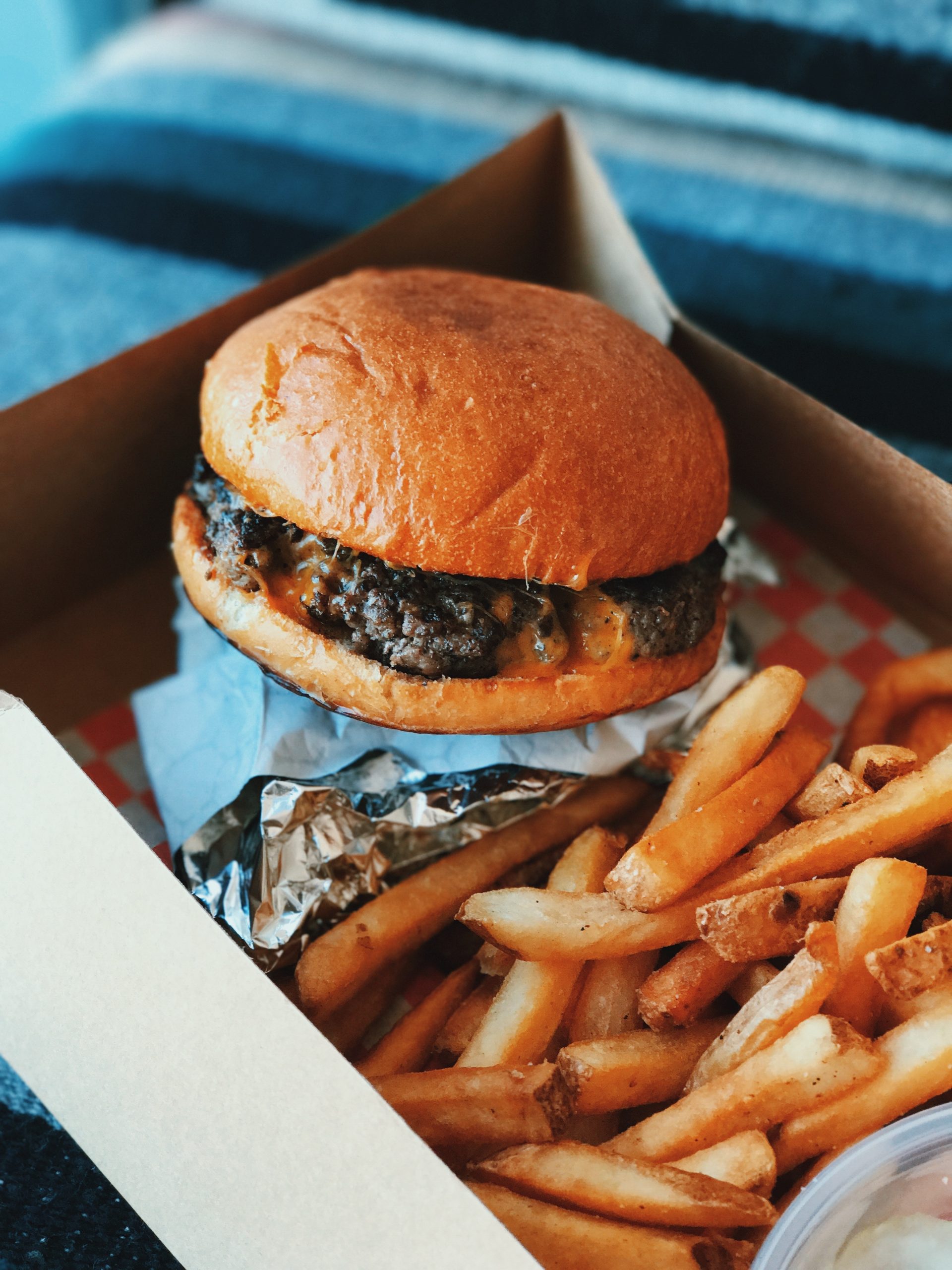
It glistens with fat, from the cheese to the fries. Both cheese and fries are typically high-fat foods, so this meal is definitely not recommended if you are following a low-fat diet. We need some fats in our diet for good health, but too much of a good thing can be harmful to our health, no matter how delicious it tastes. What are fats? And why do we have such a love-hate relationship with them? Read on to find out.
Lipids and Fatty Acids
Fats are actually a type of lipid. Lipids are a major class of biochemical compounds that includes oils, as well as fats. Among other things, organisms use lipids to store energy.
Lipid molecules consist mainly of repeating units called fatty acids. There are two types of fatty acids: saturated fatty acids and unsaturated fatty acids. Both types consist mainly of simple chains of carbon atoms bonded to one another and to hydrogen atoms. The two types of fatty acids differ in how many hydrogen atoms they contain and the number of bonds between carbon atoms.
3.5 Cultural Connection: Fats in Tanning
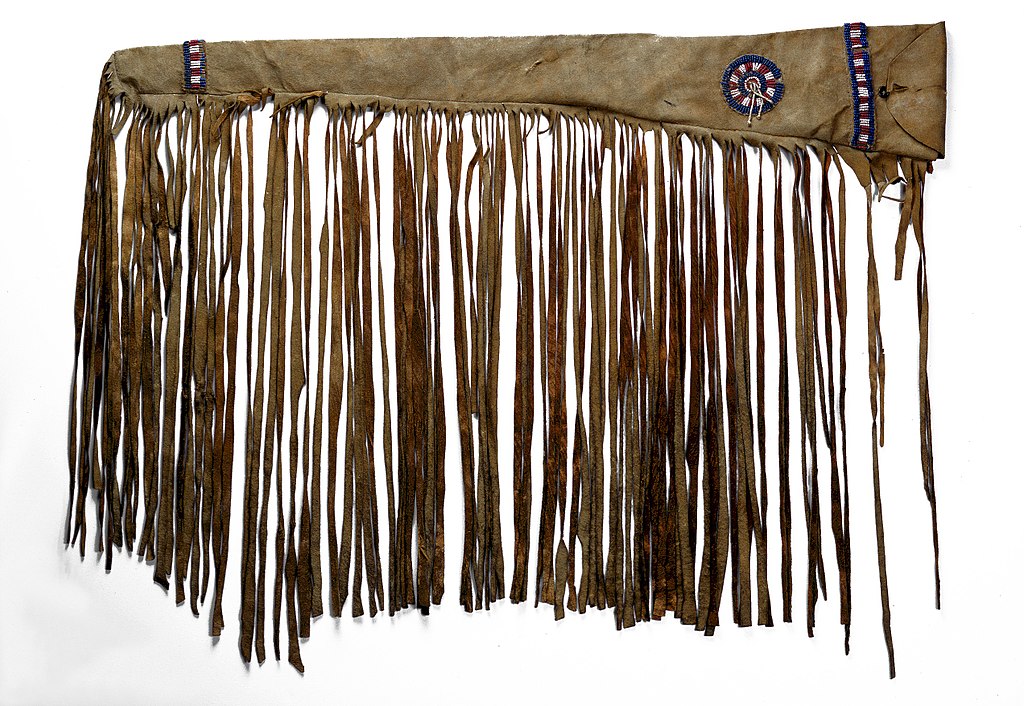
Ancient civilizations all over the world have used fats in the hide tanning process. If raw hides (animal skins) aren't tanned, they get very brittle and can breakdown. Tanning results in a hide that is soft, flexible, and resists decay.
One method of tanning is called "brain tanning". It's name is quite self-explanatory — a mixture of boiled animal brains is used to tan a hide. A type of fat in the brain, called lecithin, is a natural tanning agent. Once the hide has been rubbed with the brain mixture, it is smoked and then it is ready for use!
Brain tanning is preferred in many cultures because it creates hides which are waterproof and it doesn't create environmentally harmful byproducts.
Saturated Fatty Acids
In saturated fatty acids, carbon atoms are bonded to as many hydrogen atoms as possible. All the carbon-to-carbon atoms share just single bonds between them. This causes the molecules to form straight chains, as shown in the figure below. The straight chains can be packed together very tightly, allowing them to store energy in a compact form. Saturated fatty acids have relatively high melting points, which explains why they are solids at room temperature. Animals use saturated fatty acids to store energy. Some dietary examples of saturated fats include butter and lard.
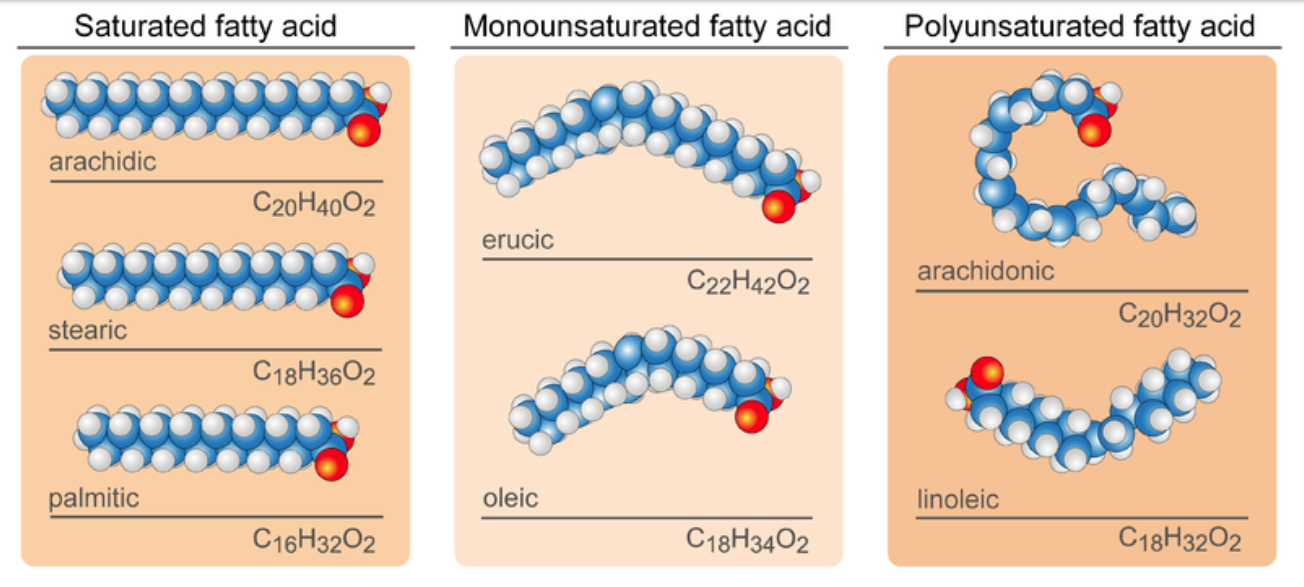
Unsaturated Fatty Acids
In unsaturated fatty acids, some carbon atoms are not bonded to as many hydrogen atoms as possible. Instead, they form double or even triple bonds with other carbon atoms. This causes the chains to bend (see Figure 3.5.3). The bent chains cannot be packed together very tightly. Unsaturated fatty acids have relatively low melting points, which explains why they are liquids at room temperature. Plants use unsaturated fatty acids to store energy.
Monounsaturated fatty acids contain one less hydrogen atom than the same-length saturated fatty acid chain. Monounsaturated fatty acids are liquids at room temperature, but start to solidify at refrigerator temperatures. Good food sources of monounsaturated fats include olive oils, peanut oils, and avocados.
Polyunsaturated fatty acids contain at least two fewer hydrogen atoms than the same-length saturated fatty acid chain. Polyunsaturated fatty acids are liquids at room temperature and remain in the liquid state in the refrigerator. Good food sources of polyunsaturated fats include safflower oils, soybean oils, and many nuts and seeds.
Types of Lipids
Lipids may consist of fatty acids alone, or they may contain other chemical components, as well. For example, some lipids contain alcohol or phosphate groups. Types of lipids include triglycerides, phospholipids, and steroids. Each type has different functions in living things.
Triglycerides
Triglycerides are formed by combining a molecule of glycerol with three fatty acid molecules, as shown below. Glycerol (also called glycerine) is a simple compound known as a sugar alcohol. It is a colourless, odorless liquid that is sweet tasting and nontoxic. Triglycerides are the main constituent of body fat in humans and other animals. They are also found in fats derived from plants. There are many different types of triglycerides, with the main division being between those that contain saturated fatty acids and those that contain unsaturated fatty acids.
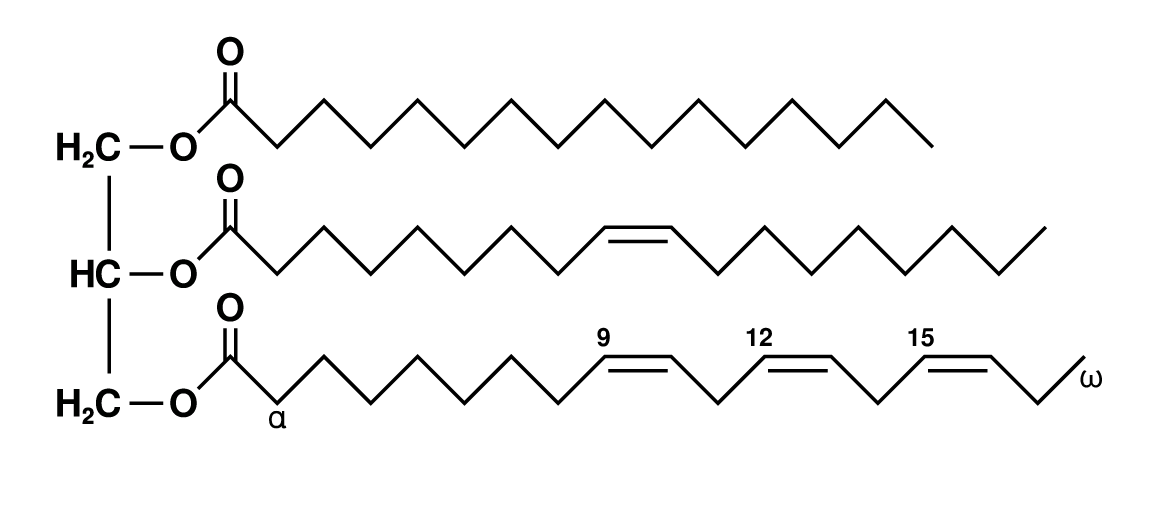
In the human bloodstream, triglycerides play an important role in metabolism as energy sources and transporters of dietary fat. They contain more than twice as much energy as carbohydrates, the other major source of energy in the diet. When you eat, your body converts any calories it doesn't need to use right away into triglycerides, which are stored in your fat cells. When you need energy between meals, hormones trigger the release of some of these stored triglycerides back into the bloodstream.
Phospholipids

Phospholipids are a major component of the cell membranes of all living things. Each phospholipid molecule has a "tail" consisting of two long fatty acids, and a "head" consisting of a phosphate group and glycerol molecule (see Figure 3.5.5). The phosphate group is a small, negatively-charged molecule causing it to be hydrophilic, or attracted to water. The fatty acid tail of the phospholipid is hydrophobic, or repelled by water. These properties allow phospholipids to form a two-layered cell membrane, which is also called a bilayer.
As shown in Figure 3.5.6, a phospholipid bilayer forms when many phospholipid molecules line up tail to tail, forming an inner and outer surface of hydrophilic heads. The hydrophyilic heads point toward both the watery extracellular space and the watery inside space (lumen) of the cell. The hydrophobic fatty acids are nestled in the inner space of the bilayer.
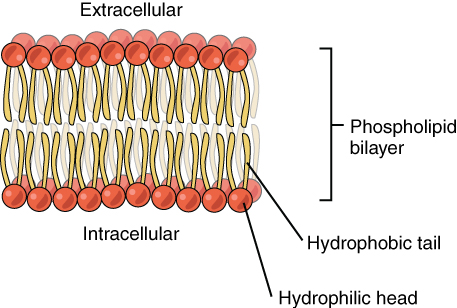
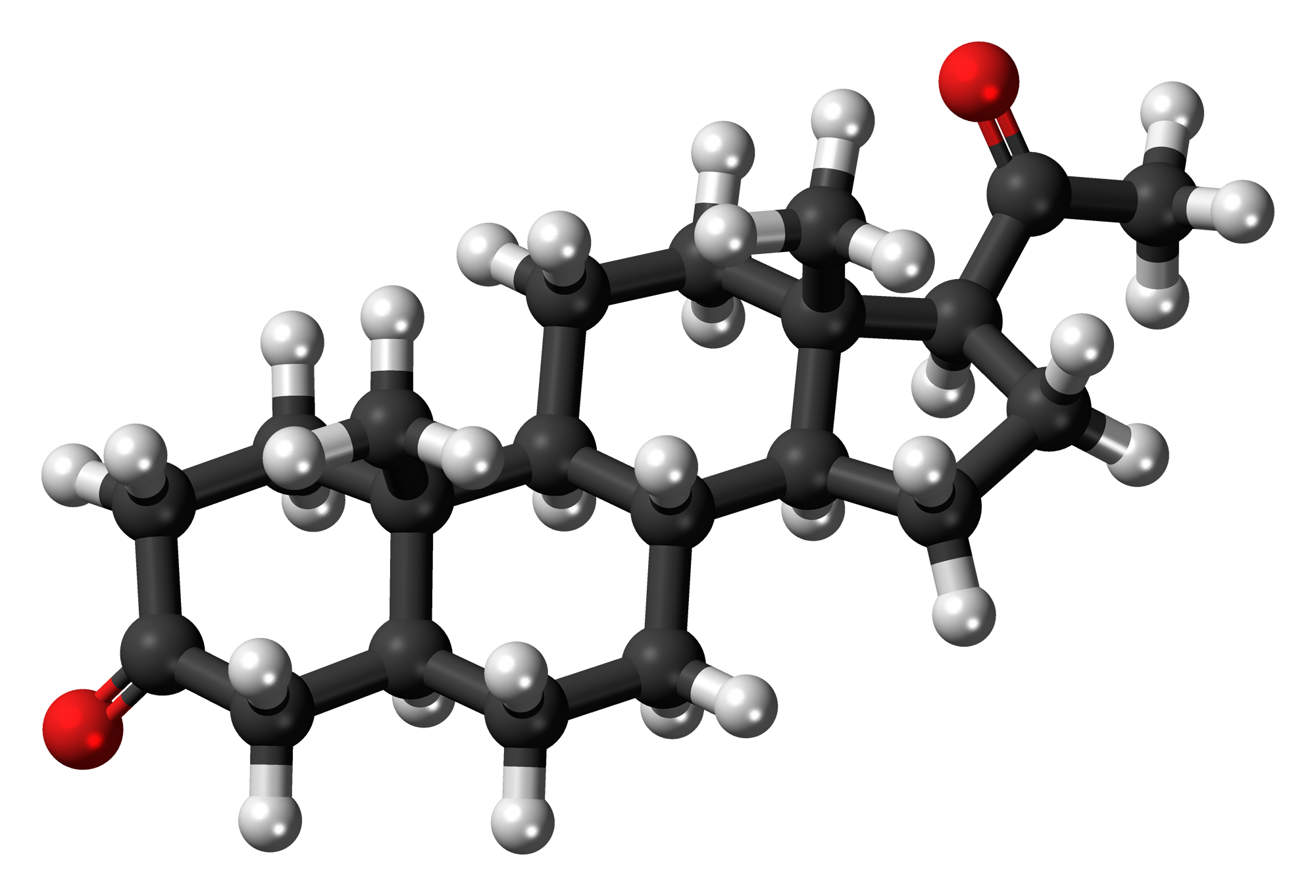
Steroids
Steroids are lipids with a ring structure. Each steroid has a core of 17 carbon atoms, which are arranged in four rings of five or six carbons each (pictured in Figure 3.5.7). Steroids vary by the other components attached to this four-ring core. Hundreds of steroids are found in plants, animals, and fungi, but most steroids have one of just two principal biological functions. Some steroids (such as cholesterol) are important components of cell membranes, while many other steroids are hormones, which are messenger molecules. In humans, steroid hormones include cortisone — a fight-or-flight hormone — and the sex hormones estrogen, progesterone and testosterone.
Feature: My Human Body
During a routine checkup with your family doctor, your blood was collected for a lipid profile. The results are back, and your triglyceride level is 180 mg/dL. Your doctor says this is a little high. A blood triglyceride level of 150 mg/dL or lower is considered normal. Higher levels of triglycerides in the blood have been linked to an increased risk of atherosclerosis, heart disease, and stroke.

If a blood test reveals that you have high triglycerides, the levels can be lowered through healthy lifestyle choices and/or prescription medications. Healthy lifestyle choices to control triglyceride levels include:
- Weight loss: If you are overweight, losing even 5 or 10 pounds (about 2.2 to 4.5 kg) may help lower your triglyceride level.
- Calorie reduction: Extra calories are converted to triglycerides and stored as fat, so reducing your calories should also reduce your triglyceride level.
- Reduction in sugars and refined foods: Simple carbohydrates, such as sugars and foods made with white flour, can increase triglyceride levels.
- Healthier fats: Trade saturated fats found in animal foods for healthier unsaturated fats found in plants and oily fish. For example, substitute olive oil for butter and salmon for red meat.
- Cut back on alcohol: Alcohol is high in calories and sugar. It has a strong effect on triglyceride levels.
- Regular exercise: Aim for at least 30 minutes of physical activity on most or all days of the week.
If healthy lifestyle changes aren't enough to bring down high triglyceride levels, drugs prescribed by your doctor are likely to help.
3.5 Summary
- Lipids are a major class of biochemical compounds that includes oils and fats. Organisms use lipids for storing energy and for making cell membranes and hormones, which are chemical messengers.
- Lipid molecules consist mainly of repeating units called fatty acids. Depending on the proportion of hydrogen atoms they contain, fatty acids may be saturated or unsaturated. Animals store fat as saturated fatty acids, while plants store fat as unsaturated fatty acids.
- Types of lipids include triglycerides, phospholipids, and steroids. Each type consists of fatty acids and certain other molecules. Each also has different functions.
- Triglycerides contain glycerol (an alcohol), in addition to fatty acids. Humans and other animals store fat as triglycerides in fat cells.
- In addition to fatty acids, phospholipids contain phosphate and glycerol. They are the main component of cell membranes in all living things.
- Steroids are lipids with a four-ring structure. Some steroids (such as cholesterol) are important components of cell membranes. Many other steroids are hormones. An example of a human hormone is cortisone, which is the fight-or-flight hormone.
3.5 Review Questions
- What are lipids?
-
- Compare and contrast saturated and unsaturated fatty acids.
- Identify three major types of lipids. Describe differences in their structures.
- How do triglycerides play an important role in human metabolism?
- Explain how phospholipids form cell membranes.
- What is cholesterol? What is its major function?
- Give three examples of steroid hormones in humans.
- Which type of fatty acid do you think is predominant in the cheeseburger and fries shown above? Explain your answer.
- Which type of fat would be the most likely to stay liquid in colder temperatures: bacon fat, olive oil, or soybean oil? Explain your answer.
- Why do you think that the shape of the different types of fatty acid molecules affects how easily they solidify? Can you think of an analogy for this?
- High cholesterol levels in the bloodstream can cause negative health effects. Explain why we wouldn’t want to get rid of all of the cholesterol in our bodies.
3.5 Explore More
https://www.youtube.com/watch?v=zqSoyaDu4b0&feature=emb_logo
Cortisone and Healing - An overview of the science, by Sportology and OrthoCarolina, 2015
https://www.youtube.com/watch?v=QhUrc4BnPgg&feature=emb_logo
What is fat? - George Zaidan, TED-Ed, 2013
Attributions
Figure 3.5.1
cheeseburger by kayleigh harrington on Unsplash is used under the Unsplash License (https://unsplash.com/license).
Figure 3.5.2
Buffalo_Hide_Beaded_Guncase by Unknown onWikimedia Commons, is used under the Missouri History Museum's MHS Open Access Policy. Image is released into the public domain (https://en.wikipedia.org/wiki/Public_domain).
Figure 3.5.3
Fatty acids by CK-12 Foundation is used under a CC BY-NC 3.0 (https://creativecommons.org/licenses/by-nc/3.0/) license.
Figure 3.5.4
Fat_triglyceride_shorthand_formula by Wolfgang Schaefer on Wikimedia Commons, is released into the public domain (https://en.wikipedia.org/wiki/Public_domain).
Figure 3.5.5
Phospholipid_Structure by OpenStax on Wikimedia Commons, is used under a CC BY 4.0 (https://creativecommons.org/licenses/by/4.0) license.
Figure 3.5.6
Phospholipid_Bilayer by OpenStax on Wikimedia Commons, is used under a CC BY 4.0 (https://creativecommons.org/licenses/by/4.0) license.
Figure 3.5.7
Progesterone, 5alpha-Dihydroprogesterone 3D ball by Jynto is used under a CC0 1.0 Universal Public Domain Dedication license (https://creativecommons.org/publicdomain/zero/1.0/deed.en).
Figure 3.5.8
Healthy plate by Edgar Castrejon on Unsplash is used under the Unsplash License (https://unsplash.com/license).
References
Betts, J.G., Young, K.A., Wise, J.A., Johnson, E., Poe, B., Kruse, D.H., Korol, O., Johnson, J.E., Womble, M., DeSaix, P. (2013, April 25). Figure 3.2. Phospholipid structure [digital image]. In Anatomy and Physiology. OpenStax. https://openstax.org/books/anatomy-and-physiology/pages/3-1-the-cell-membrane
Betts, J.G., Young, K.A., Wise, J.A., Johnson, E., Poe, B., Kruse, D.H., Korol, O., Johnson, J.E., Womble, M., DeSaix, P. (2013, April 25). Figure 3.3. Phospolipid bilayer [digital image]. In Anatomy and Physiology. OpenStax. https://openstax.org/books/anatomy-and-physiology/pages/3-1-the-cell-membrane
Mayo Clinic. (n.d.). Arteriosclerosis / atherosclerosis [online article]. https://www.mayoclinic.org/diseases-conditions/arteriosclerosis-atherosclerosis/symptoms-causes/syc-20350569
Mayo Clinic. (n.d.). Heart disease [online article]. https://www.mayoclinic.org/diseases-conditions/heart-disease/symptoms-causes/syc-20353118
Mayo Clinic. (n.d.). Stroke [online article]. https://www.mayoclinic.org/diseases-conditions/stroke/symptoms-causes/syc-20350113
Sportology/OrthoCarolina. (2015, February 26). Cortisone and healing - An overview of the science. YouTube. https://www.youtube.com/watch?v=zqSoyaDu4b0&feature=youtu.be
TED-Ed. (2013, May 22). What is fat? - George Zaidan. YouTube. https://www.youtube.com/watch?v=QhUrc4BnPgg&feature=youtu.be
Glucose (also called dextrose) is a simple sugar with the molecular formula C6H12O6. Glucose is the most abundant monosaccharide, a subcategory of carbohydrates. Glucose is mainly made by plants and most algae during photosynthesis from water and carbon dioxide, using energy from sunlight.
Created by CK-12 Foundation/Adapted by Christine Miller
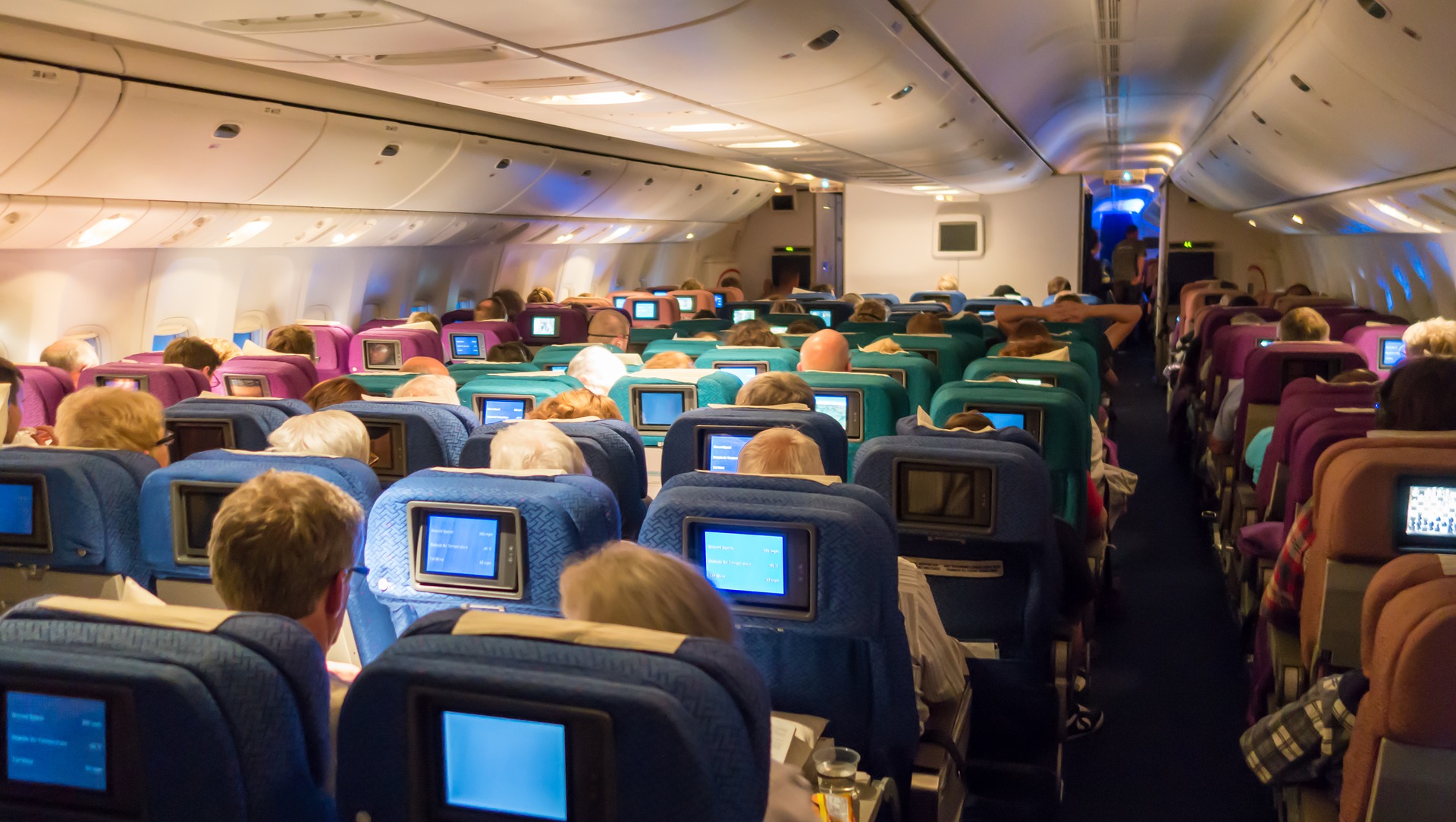
Case Study: Flight Risk
Nineteen-year-old Malcolm is about to take his first plane flight. Shortly after he boards the plane and sits down, a man in his late sixties sits next to him in the aisle seat. About half an hour after the plane takes off, the pilot announces that she is turning the seat belt light off, and that it is safe to move around the cabin.
The man in the aisle seat — who has introduced himself to Malcolm as Willie — immediately unbuckles his seat belt and paces up and down the aisle a few times before returning to his seat. After about 45 minutes, Willie gets up again, walks some more, then sits back down and does some foot and leg exercises. After the third time Willie gets up and paces the aisles, Malcolm asks him whether he is walking so much to accumulate steps on a pedometer or fitness tracking device. Willie laughs and says no. He is actually trying to do something even more important for his health — prevent a blood clot from forming in his legs.
Willie explains that he has a chronic condition: heart failure. Although it sounds scary, his condition is currently well-managed, and he is able to lead a relatively normal lifestyle. However, it does put him at risk of developing other serious health conditions, such as deep vein thrombosis (DVT), which is when a blood clot occurs in the deep veins, usually in the legs. Air travel — and other situations where a person has to sit for a long period of time — increases the risk of DVT. Willie’s doctor said that he is healthy enough to fly, but that he should walk frequently and do leg exercises to help avoid a blood clot.
As you read this chapter, you will learn about the heart, blood vessels, and blood that make up the cardiovascular system, as well as disorders of the cardiovascular system, such as heart failure. At the end of the chapter you will learn more about why DVT occurs, why Willie has to take extra precautions when he flies, and what can be done to lower the risk of DVT and its potentially deadly consequences.
Chapter Overview: Cardiovascular System
In this chapter, you will learn about the cardiovascular system, which transports substances throughout the body. Specifically, you will learn about:
- The major components of the cardiovascular system: the heart, blood vessels, and blood.
- The functions of the cardiovascular system, including transporting needed substances (such as oxygen and nutrients) to the cells of the body, and picking up waste products.
- How blood is oxygenated through the pulmonary circulation, which transports blood between the heart and lungs.
- How blood is circulated throughout the body through the systemic circulation.
- The components of blood — including plasma, red blood cells, white blood cells, and platelets — and their specific functions.
- Types of blood vessels — including arteries, veins, and capillaries — and their functions, similarities, and differences.
- The structure of the heart, how it pumps blood, and how contractions of the heart are controlled.
- What blood pressure is and how it is regulated.
- Blood disorders, including anemia, HIV, and leukemia.
- Cardiovascular diseases (including heart attack, stroke, and angina), and the risk factors and precursors — such as high blood pressure and atherosclerosis — that contribute to them.
As you read the chapter, think about the following questions:
- What is heart failure?Why do you think it increases the risk of DVT?
- What is a blood clot? What are possible health consequences of blood clots?
- Why do you think sitting for long periods of time increases the risk of DVT? Why does walking and exercising the legs help reduce this risk?
Attribution
Figure 14.1.1
aircraft-1583871_1920 [photo] by olivier89 from Pixabay is used under the Pixabay License (https://pixabay.com/de/service/license/).
A neurotransmitter that will have excitatory effects on the neuron, meaning it will increase the likelihood that a neuron will fire an action potential.
A rigid organ that constitutes part of the vertebrate skeleton in animals.
Created by: CK-12/Adapted by Christine Miller
Is It Magic?
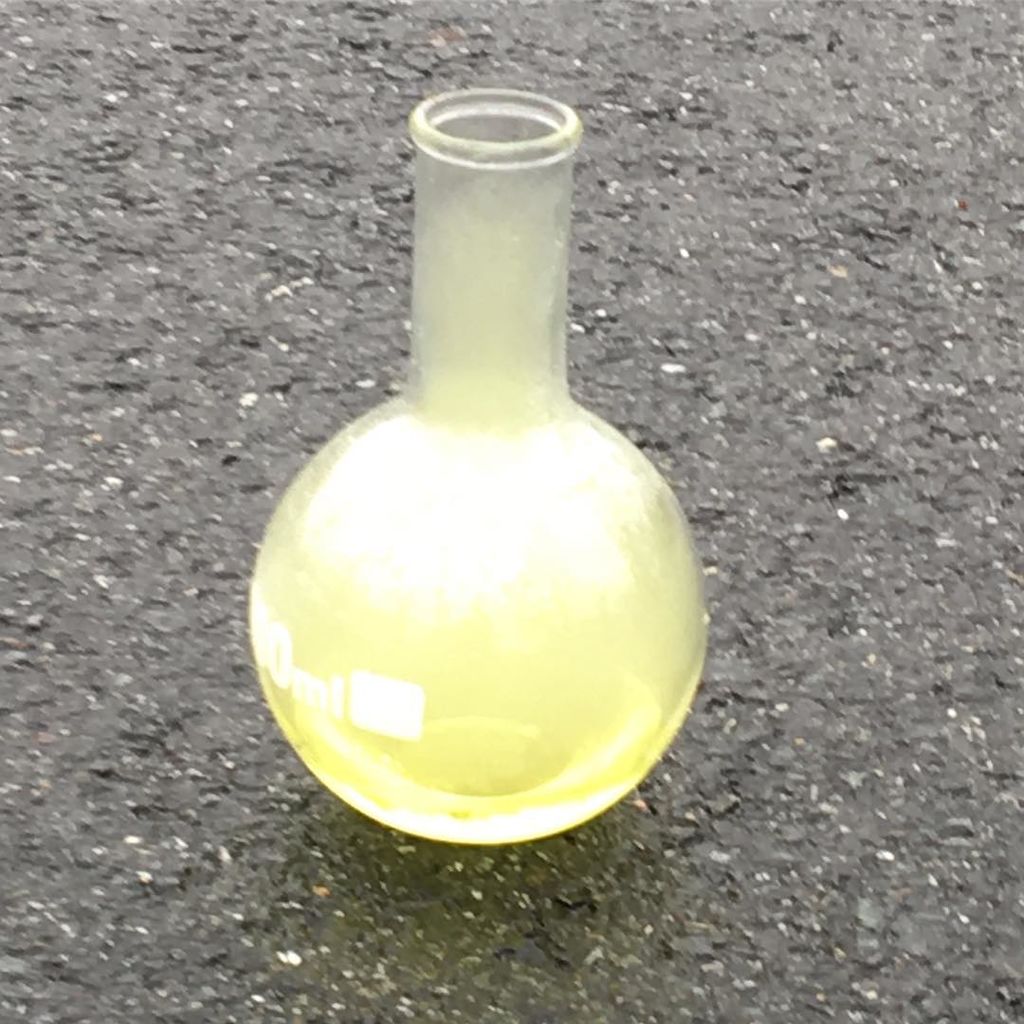
The harmless-looking bottle in Figure 3.8.1 contains a greenish-yellow, poisonous gas. The gas is chlorine, which is also used as bleach and to keep the water in pools and hot tubs free of germs. Chlorine can kill just about anything. Would you breathe in chlorine gas or drink liquid chlorine? Of course not, but you often eat a compound containing chlorine. You probably eat this chlorine compound just about every day. Can you guess what it is? It's table salt.
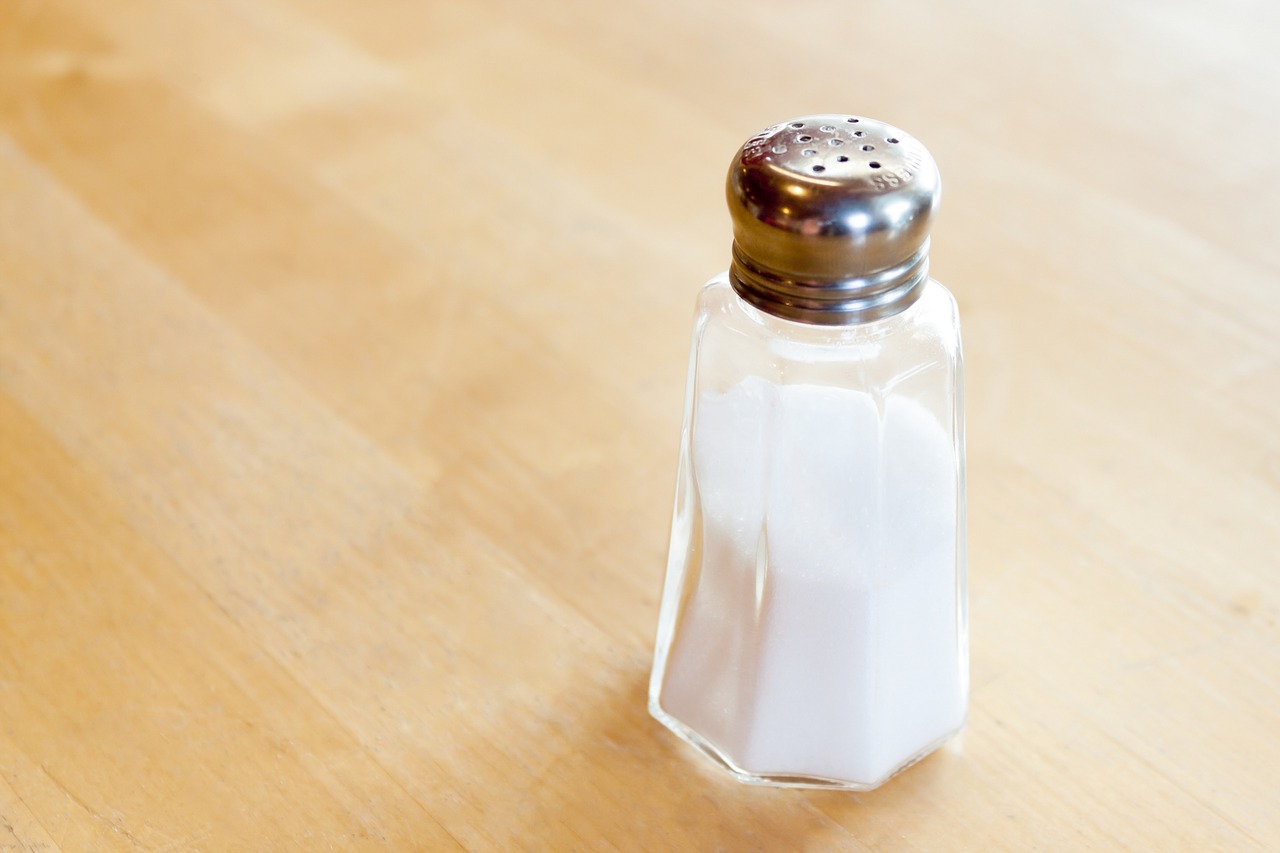
Table salt is actually sodium chloride (NaCl), which forms when chlorine and sodium (Na) combine in certain proportions. How does the toxic green chemical chlorine change into the harmless white compound we know as table salt? It isn't magic — it's chemistry, and it happens in a chemical reaction.
What Is a Chemical Reaction?
A chemical reaction is a process that changes some chemical substances into others. A substance that starts a chemical reaction is called a reactant, and a substance that forms as a result of a chemical reaction is called a product. During the reaction, the reactants are used up to create the products.
The burning of methane gas, as shown in the picture below, is a chemical reaction. In this reaction, the reactants are methane (CH4) and oxygen (O2), and the products are carbon dioxide (CO2) and water (H2O). As this example shows, a chemical reaction involves the breaking and forming of chemical bonds, which are forces that hold together the atoms of a molecule. When methane burns, for example, bonds break within the methane and oxygen molecules, and new bonds form in the molecules of carbon dioxide and water.
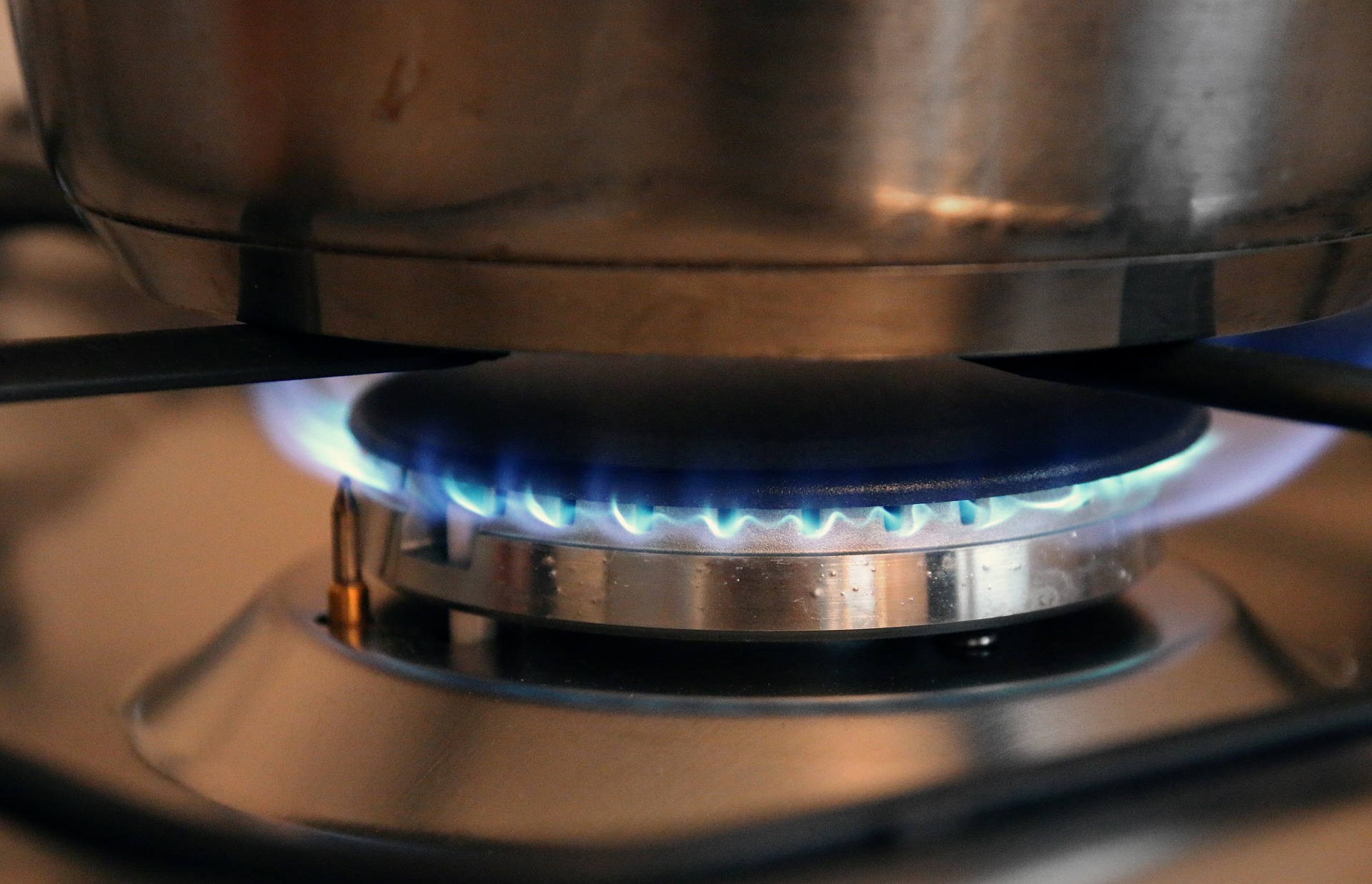
Chemical Equations
Chemical reactions can be represented by chemical equations. A chemical equation is a symbolic way of showing what happens during a chemical reaction. The burning of methane, for example, can be represented by the chemical equation:
CH4 + 2O2 → CO2 + 2H2O
The arrow in a chemical equation separates the reactants from the products, and shows the direction in which the reaction proceeds. If the reaction could occur in the opposite direction as well, two arrows pointing in opposite directions would be used. The number 2 in front of O2 and H2O, called the coefficient, shows that two oxygen molecules and two water molecules are involved in the reaction. If just one molecule is involved, no number is placed in front of the chemical symbol. Note the subscript of 2 for the oxygen (O) and hydrogen (H) atoms in the oxygen and water molecules, respectively. That tells you that each oxygen molecule is made up of two oxygen atoms. If there is no subscript, then there is a single atom. Thus, one water molecule is made up of two hydrogen atoms and one oxygen atom. In order for this chemical reaction to take place, one methane molecule reacts with two oxygen molecules to form one carbon dioxide molecule and two water molecules.
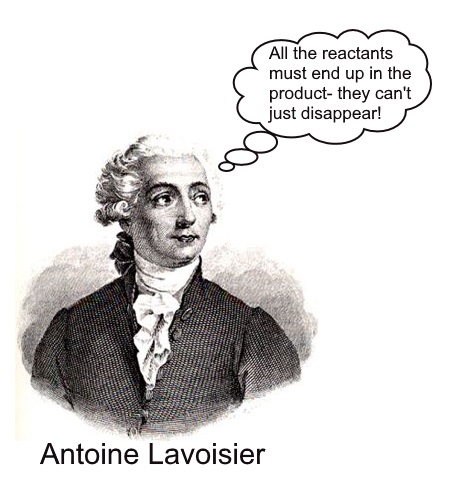
Conservation of Mass
In a chemical reaction, the quantity of each element does not change. There is the same amount of each element in the products as there was in the reactants. Mass is always conserved. According to the law of conservation of mass — which was first demonstrated convincingly by French chemist Antoine Lavoisier in 1785 — mass is neither created nor destroyed during a chemical reaction. Therefore, during a chemical reaction, the total mass of products is equal to the total mass of reactants. The conservation of mass is reflected in a reaction's chemical equation. The same number of atoms of each element appears on each side of the arrow. In the chemical equation above, there are four hydrogen atoms on each side of the arrow. Can you find all four of them on each side of the equation?
Chemical vs. Physical Changes
Many processes that happen all around us on a daily basis involve chemical reactions. Not every change, however, is a chemical change. Some changes are simply physical and do not involve chemical reactions. Physical changes include change in size of pieces and change in state. If you break an eggshell and pour out the egg into a pan, its chemical makeup and properties do not change. This is just a physical change. No chemical reactions have occurred, and no chemical bonds have broken or formed. Other examples of physical changes are cutting paper into smaller pieces and letting an ice cube melt. What if you put the egg in the pan over a hot flame? The egg turns to a rubbery solid and changes colour. The properties of the egg have changed because its chemical makeup has changed. Cooking the egg is a chemical change that involves chemical reactions.
Other common examples of chemical changes include a cake baking, metal rusting, and a candle burning. More practice is below.
Figure 3.8.5 Chemical changes often involve chemical reactions as well.
3.8 Summary
- A chemical reaction is a process that changes some chemical substances into others. A substance that starts a chemical reaction is called a reactant, and a substance that forms during a chemical reaction is called a product. During the chemical reaction, bonds break in reactants and new bonds form in products.
- Chemical reactions can be represented by chemical equations. According to the law of conservation of mass, mass is always conserved in a chemical reaction, so a chemical equation must be balanced, with the same number of atoms of each type of element in the products as in the reactants.
- Many chemical reactions — such as iron rusting and organic matter rotting — occur all around us each day, but not all changes are chemical processes. Some changes — like ice melting or paper being torn into smaller pieces — are physical processes that do not involve chemical reactions and the formation of new substances.
3.8 Review Questions
- What is a chemical reaction?
- Define the reactants and products in a chemical reaction.
- List three examples of common changes that involve chemical reactions.
- Define a chemical bond.
- What is a chemical equation? Give an example.
- What does it mean for a chemical equation to be balanced? Why must a chemical equation be balanced?
- Our cells use glucose (C6H12O6) to obtain energy in a chemical reaction called cellular respiration. In this reaction, six oxygen molecules (O2) react with one glucose molecule. Answer the following questions about this reaction:
- How many oxygen atoms are in one molecule of glucose?
- Write out what the reactant side of this equation would look like.
- In total, how many oxygen atoms are in the reactants? Explain how you calculated your answer.
- In total, how many oxygen atoms are in the products? Is it possible to answer this question without knowing what the products are? Why or why not?
- Answer the following questions about the following equation: CH4+ 2O2 → CO2 + 2H2O
- Can carbon dioxide (CO2)transform into methane (CH4) and oxygen (O2) in this reaction? Why or why not?
- How many molecules of carbon dioxide (CO2) are produced in this reaction?
- Is the evaporation of liquid water into water vapor a chemical reaction? Why or why not?
- Why do bonds break in the reactants during a chemical reaction?
3.8 Explore More
https://www.youtube.com/watch?v=2S6e11NBwiw&feature=emb_logo
The law of conservation of mass - Todd Ramsey, TED-Ed, 2015.
https://www.youtube.com/watch?v=37pir0ej_SE
Chemical Changes: Crash Course Kids #19.2, by Crash Course Kids, 2015.
Attributions
Figure 3.8.1
Chlorine_gas_in_high_concentration by Larenmclane on Wikimedia Commons, is used under a CC BY-SA 4.0 (https://creativecommons.org/licenses/by-sa/4.0/deed.en) license.
Figure 3.8.2
Tags: Salt Salt Shaker Spices Kitchen Spice Component; salt-4160306_1280 by katie175 from Pixabay is used under the Pixabay License (https://pixabay.com/de/service/license/).
Figure 3.8.3
Tags: Gas Flame Gas Stove Italy Gas Cook Kitchen by moerschy from Pixabay is used under the Pixabay License (https://pixabay.com/de/service/license/).
Figure 3.8.4
Antoine_lavoisier by unknown on Wikimedia Commons has been adapted by Christine Miller. The orginal work, believed to be from http://www.schuster-ingolstadt.de/Chemie.htm has been released into the public domain (https://en.wikipedia.org/wiki/Public_domain).
Figure 3.8.5
- Ice cream melting by Aron Visuals on Unsplash is used under the Unsplash License (https://unsplash.com/license).
- Kombucha [photo] by Klara Avsenik on Unsplash is used under the Unsplash License (https://unsplash.com/license).
- Grated cheese by Steve Buissinne on PublicDomainPictures is used under the CC0 1.0 Universal Public Domain Dedication license (https://creativecommons.org/publicdomain/zero/1.0/).
References
Crash Course Kids. (2015, July 16). Chemical changes: Crash Course Kids #19.2. YouTube. https://www.youtube.com/watch?v=37pir0ej_SE
TED-Ed. (2015, February 26 ). The law of conservation of mass - Todd Ramsey. YouTube. https://www.youtube.com/watch?v=2S6e11NBwiw&feature=emb_logo
Wikipedia contributors. (2020, June 15). Antoine Lavoisier. Wikipedia. https://en.wikipedia.org/w/index.php?title=Antoine_Lavoisier&oldid=962631283


